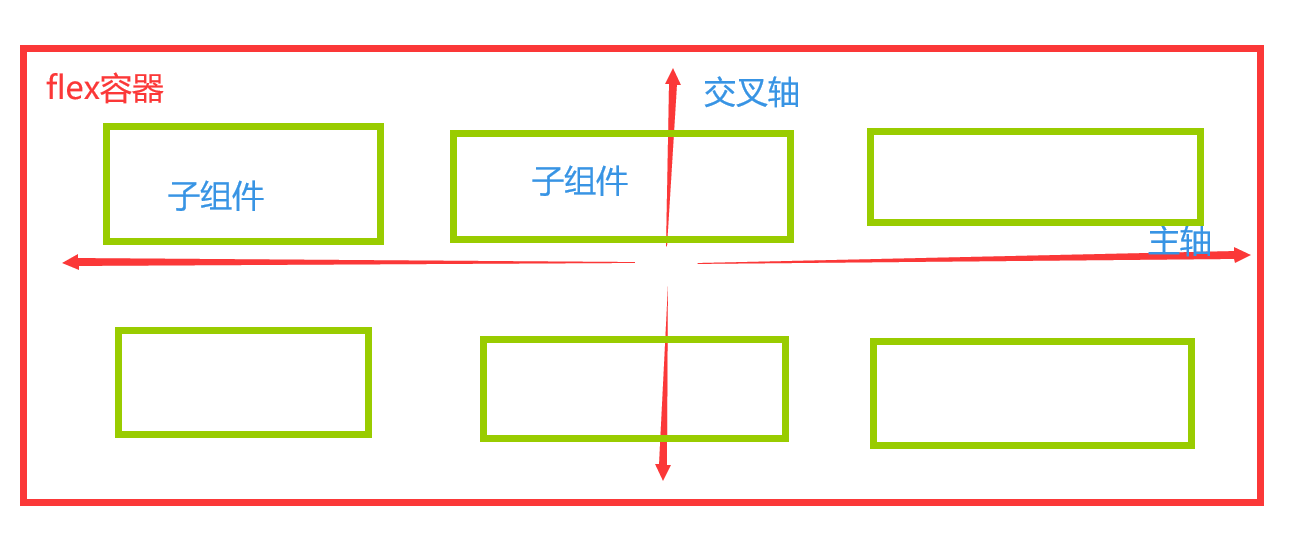本文主要是介绍加州大学欧文分校英语中级语法专项课程01:Perfect Tenses and Modals 学习笔记,希望对大家解决编程问题提供一定的参考价值,需要的开发者们随着小编来一起学习吧!
Perfect Tenses and Modals
course certificate
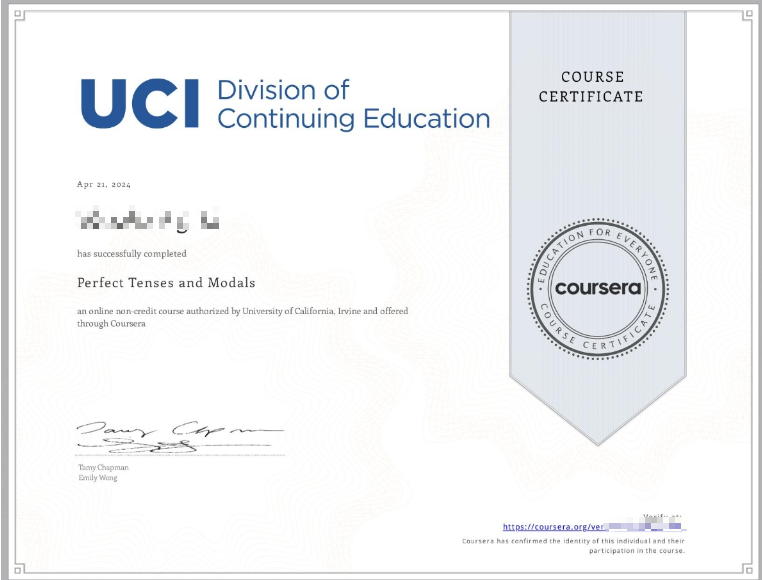
本文是学习https://www.coursera.org/learn/perfect-tenses-modals?specialization=intermediate-grammar 这门课的学习笔记,如有侵权,请联系删除。
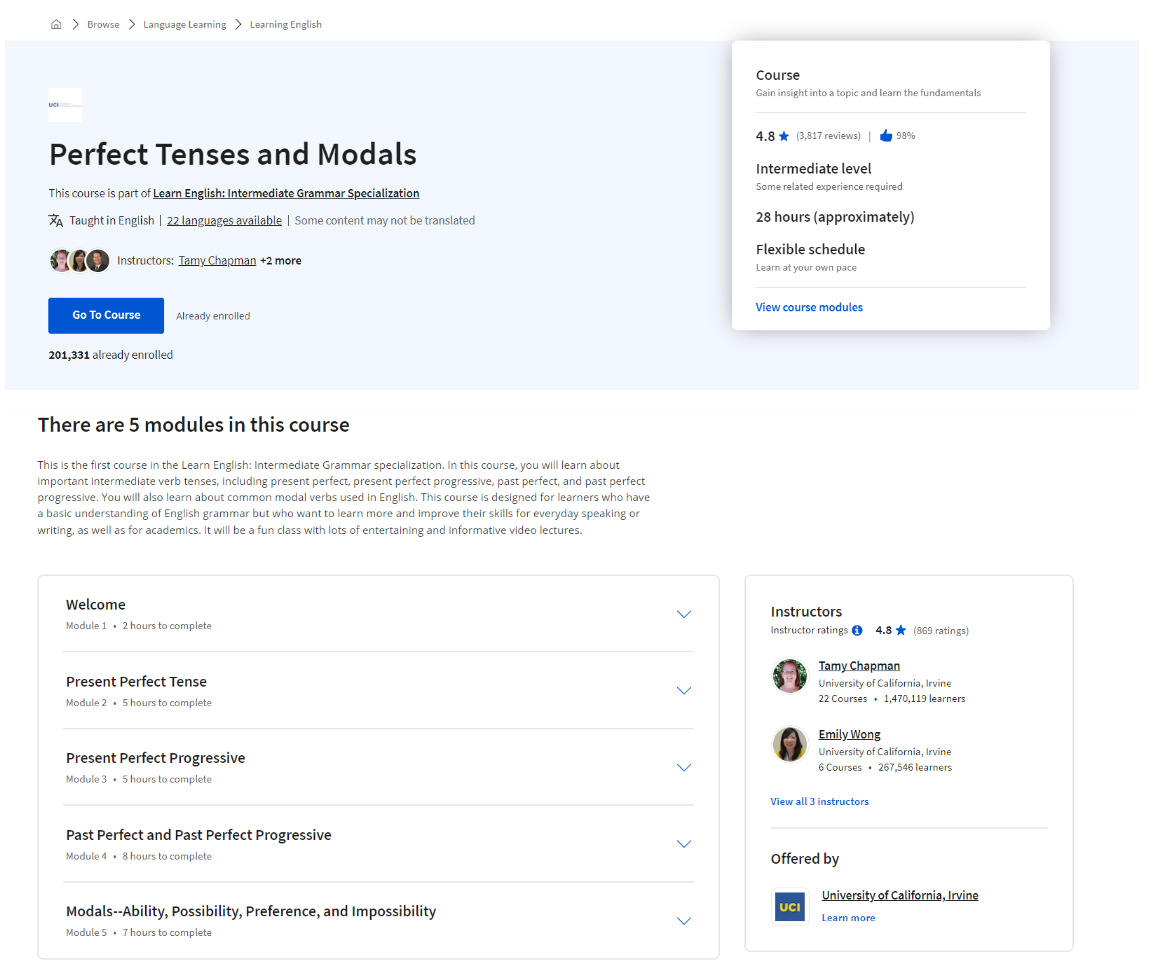
这门课是如下专项中的一门:Learn English: Intermediate Grammar Specialization
Website: https://www.coursera.org/specializations/intermediate-grammar
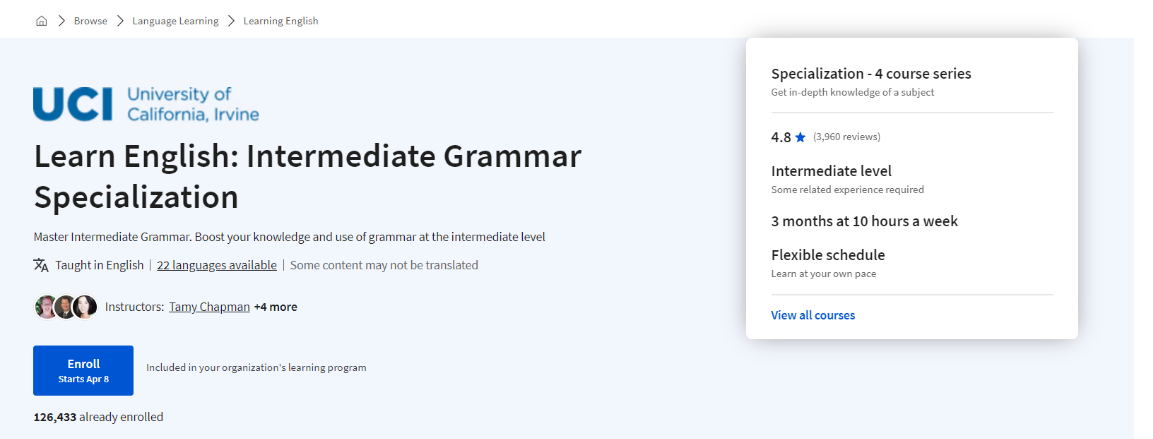
文章目录
- Perfect Tenses and Modals
- Week 01: Present Perfect Statements
- Present Perfect Overview Lecture
- Past Participles Lecture
- Present Perfect with Since and For Lecture
- Present Perfect without Since and For Lecture
- Practice Quiz on Present Perfect
- Present Perfect Questions Lecture
- Practice Quiz on Present Perfect Questions
- Present Perfect Adverbs Lecture
- Practice Quiz on Adverbs
- Graded Assignment: Present Perfect Assignment
- Graded Quiz: Present Perfect Quiz
- Week 02: Present Perfect Progressive
- Learning Objectives
- Stative Verbs Part 1 Lecture
- Stative Verbs Part 2 Lecture
- Practice Quiz on Stative Verbs
- Stative Verbs Practice 1
- Present Perfect Progressive Overview Lecture
- Practice Quiz on Present Perfect Progressive
- Stative Verbs Practice 2
- Present Perfect Progressive Questions Lecture
- Practice Quiz on Present Perfect Progressive Questions
- Present Perfect vs. Present Perfect Progressive Lecture
- Practice Quiz on Present Perfect vs. Present Perfect Progressive
- Graded Assignment: Present Perfect Progressive Assignment
- Graded Quiz:Present Perfect Progressive Quiz
- Week 03: Past Perfect and Past Perfect Progressive
- Learning Objectives
- Past Perfect Lecture
- Past Perfect Practice
- Practice Quiz on Past Perfect
- Past Perfect Questions Lecture
- Practice Quiz on Past Perfect Questions
- Past Perfect Questions Practice
- Graded Assignment: Past Perfect Assignment
- Past Perfect Progressive Lecture
- Practice Quiz on Past Perfect Progressive
- Past Perfect Progressive Questions Lecture
- Past Perfect Progressive Practice
- Practice Quiz on Past Perfect Progressive Questions
- Graded Assignment: Past Perfect Progressive Assignment
- Graded Quiz: Past Perfect and Past Perfect Progressive Quiz
- Week 04: Modals--Ability, Possibility, Preference, and Impossibility
- Learning Objectives
- Modals Introduction Lecture
- Phrasal Modals Lecture
- Phrasal Modals Practice
- Ability Modals Lecture
- Modals Part 1 Practice Quiz
- Modals of Possibility Lecture
- Modals of Possibility Practice
- Advice Modals Lecture
- Preference Modals Lecture
- Modals Part 2 Practice Quiz
- Graded Assignment: Modals Assignment 1
- Modals of Impossibility Lecture
- Questions with Modals Lecture
- Modals Part 3 Practice Quiz
- Graded Assignment: Modals Assignment 2
- Graded Quiz: Modals Quiz
- 后记
present perfect: 现在完成时
participle: 美 [ˈpɑːrtɪsɪpl] 分词
past participle: 过去分词
Past Perfect: 过去完成时
Vancouver:美 [vænˈkuːvər] 温哥华
dragon fruit: 火龙果
Present Perfect Progressive: 现在完成进行时
present participle:现在分词
past perfect progressive: 过去完成进行时
modal: 美 [ˈmoʊdl] 情态动词
handstand:倒立
preposition:介词
disbelief:不相信;怀疑;
Week 01: Present Perfect Statements
Present Perfect Overview Lecture
In this lesson, you will learn what the present perfect tense is and when to use it. You will watch several video lectures and do several practice activities. At the end of this module, you will take a quiz over everything you have learned.
After you watch the following video lecture, you will be able to:
-
form the present perfect tense correctly using a form of have and a past participle
-
list several examples of past participles
-
explain two different uses for the present perfect
The Present Perfect, An Overview. The International Club is a club at our
university that celebrates different cultures from around the world.

This is Henry. He was the old president of the club,
but he just graduated. So we need a new president. Luckily, there are two candidates for
the position, or two people who want to
be the new president. Judy and Joe are both running for
the position. Let’s take a closer look
at Judy’s experience. She has traveled all over the world. She has lived in China and Japan. She has studied English for 15 years. She has been a member of
the International Club since 2014. Wow, she seems like a pretty
good candidate to me.
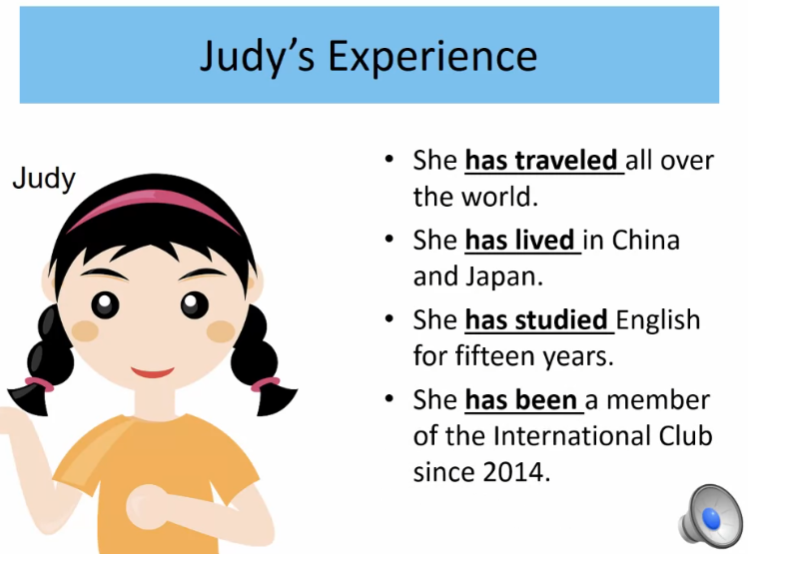
What about, Joe? He has traveled to Europe and
Latin America. He has never lived in another country. He has studied English for five years. He has been a member of
the International Club since 2013.
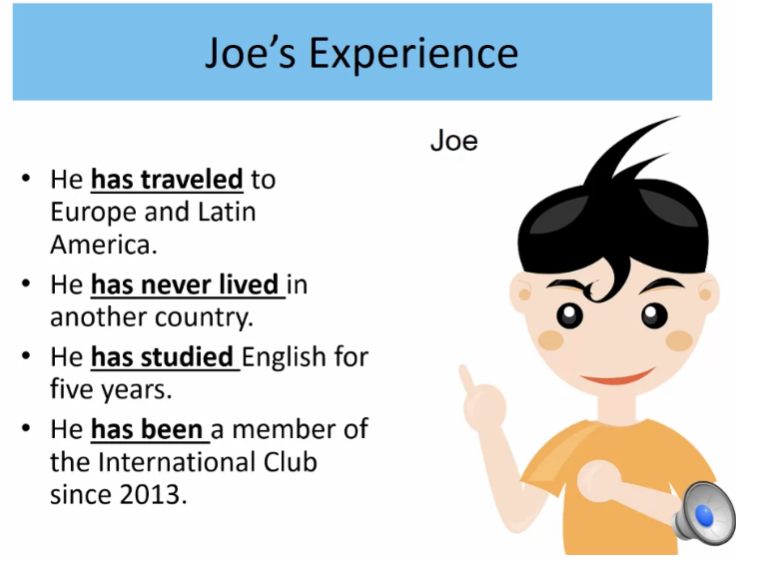
He seems like a pretty good guy for
the position as well. What do you think? Who is better for the position? Who has had more experience? This verb form, has had,
is an example of the present perfect. Okay, let’s look at how we
make the present perfect. We need the verb have or has, and not if we want to make a negative,
and a past participle. For example,
Judy has traveled all over the world. Joe has not visited every country. They have met friends from other cultures. We use has for he, she and it and have for all other subjects. But you already knew that. Traveled, visited, and met are all examples of past participles. Also known as verb free. We can also make contraction forms, or
shortened forms, of the present perfect. Take a look at these examples below.
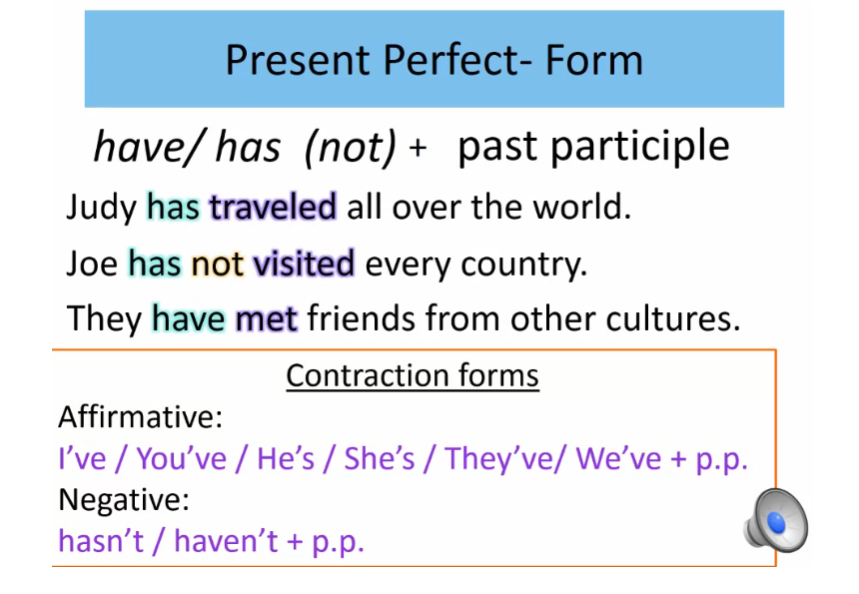
Okay, let’s talk about why
we use the present perfect. Look at these two sentences. The first sentence,
I have traveled to China, is an example of one use
of the present perfect. Unspecified time in the past. The other sentence,
I have lived here for three years, is an example of how we can use
the present perfect with since or for. Let’s take a closer look at the first use. When we say unspecified time in the past,
what we mean is that we’re talking about an activity
that started and finished in the past, but with no mention of a specific time. So for example,
we can’t say last week or yesterday. It’s not important when
the event happened, but rather it’s about life experience. We can also use the present
perfect in this way To describe repeated events in the past. For example,
I have traveled to China thee times.
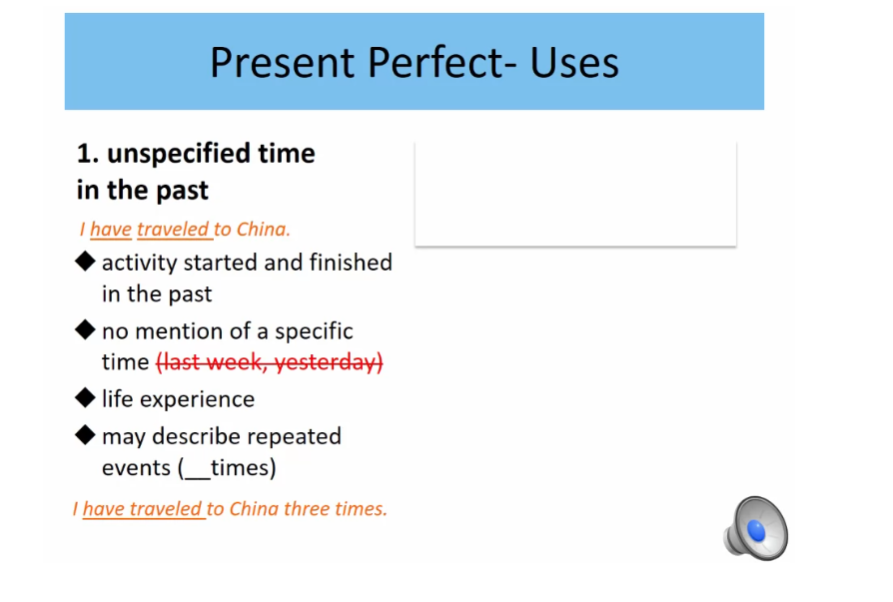
Okay, let’s look at the other
use of the present perfect. Using since, or for. When we since or for we’re talking about an activity that began
in the past and is still going on now. For example,
I have lived here for three years means that I moved here three years
ago and I’m still living here. It’s used to talk about how long
an activity has been going on. We use for with the duration of time. Or length of time, an example one year, three months, or five days. We use since with a specific
point in the past. For example, last year,
September, or 9:00. Okay, it’s important to remember that these are two different uses
of the same verb tense.
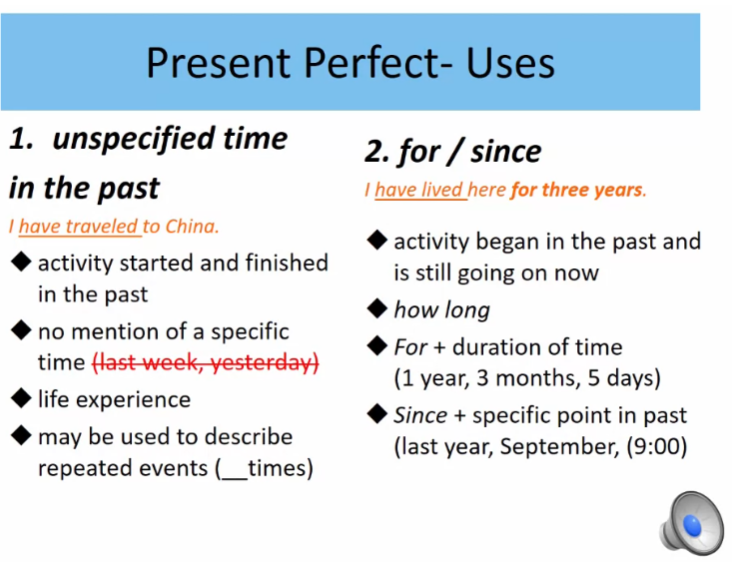
Let’s go back to Judy and Joe. Now we can see the examples of these
two uses of the present perfect. Can you find examples of
a completed past event that does not mention a specific time? Yeah, there’s one,
she has traveled all over the world. We don’t know when, and
it’s not important. What’s important is her experience. Yeah, she has lived in China and Japan. We’re talking about an event in
the past with no specific time. Now, can you find an example of
an event that started in the past and is still going? Here’s a hint. Look for since or for. Yeah number three. She has studied English for fifteen years. That means she started 15 years ago and
she is still studying it. She has been a member of the International
Club since 2014, and she still is. Good job.

Okay, it’s your turn. How are the blue sentences
different from the red ones? You’re right. These ones represent
an unspecified time in the past. And what about these ones? Now, with these ones, we use since or for to talk about something that started
in the past and is still going. Good job. So who’s your pick for
the president of the International Club? And why? I think they’re both good candidates. See you next time.
Past Participles Lecture
You have learned what the present perfect tense is, and you have learned about using past participles to form the present perfect. Now, you will look a little closer at past participles.
After you watch the following video, you will be able to:
-
understand the difference between regular and irregular verbs
-
know the past participle form for several common verbs
In this lesson, you’re going to
learn about past participles, but first I want you to
meet some friends of mine. They have done some amazing things. For example, Bob has swum with dolphins. Helen has flown all over the world. And Matt has climbed a mountain. Meet Bob, Helen, and Matt. Aren’t they amazing? What about you? Have you ever swum with dolphins? Have you flown anywhere? Have you ever climbed a mountain? What have you done?
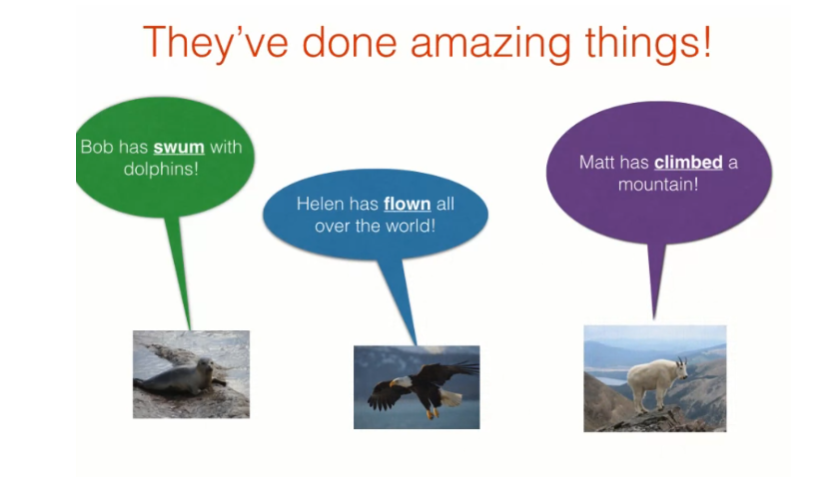
In this lesson, we’re going to focus on
these verb forms that you see underlined. Swum, flown, and climbed are all
examples of past participles. To understand what a past participle is, it’s important to know that English
verbs come in different forms. Like the simple form, the simple past, and the past participle. Let’s look at some examples. The verb fly is an example of
a verb in its simple form. For example, when I have to go to
another country I fly in an airplane. What about the simple past? Do you know what form that is? That’s right. It’s flew, yesterday,
a bird flew into my window. And the past participle is flown. Remember my friend Helen? She has flown all over the world. Okay, let’s look at some more examples. Go, went, and gone. Swim, swam, and swum. Eat, ate, and eaten. Let’s look at a couple other examples
that are a little bit different. For example, want. Do you know this simple past? How do we say want in the past? Yep, it’s wanted. Guess what? The past participle is the same. It’s also wanted. How about look? Yep, it’s looked, and so
is the past participle. This group of verbs
represents irregular verbs. And they also have a different simple
past and past participle form. Do you see how they’re different? These are all irregular verbs. And these ones are regular.
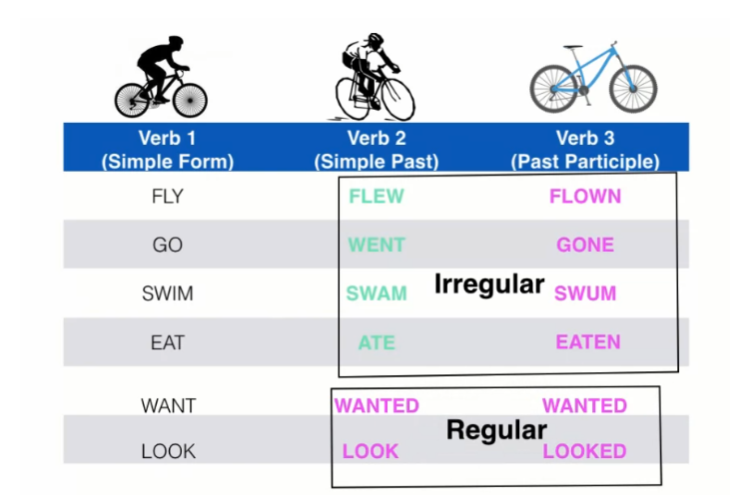
Okay, so there’s some important rules we need to
know when we talk about past participles. For example, past participles cannot
be the only verb in a sentence. It’s wrong to say I flown in an airplane. It’s incomplete. However, we can say a sentence like,
I have flown in an airplane. This is the example of
the present perfect. We can also say,
I had flown in an airplane, which is an example of the past perfect. So when we use past participles, we need a helping verb like have or had. If we try to use a past participle
without a helping verb, it’s kind of like a bike with no rider. It only works when there’s
someone to move it along.
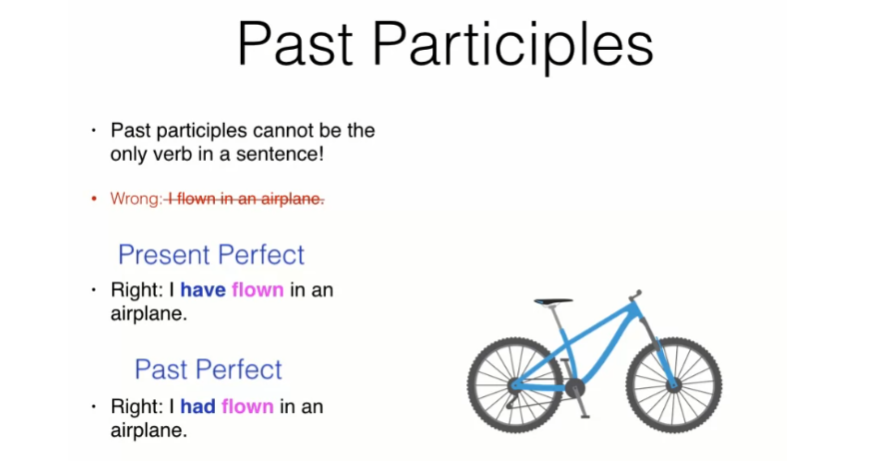
Okay, time to review. Which sentence has an example
of a past participle? You’ve got it,
Helen has caught her dinner. How did you know? Well, you probably say the helping
verb has accompanied by the past participle of the verb catch,
which is caught. You did it, good job. Now you know what a past
participle is in English.
Present Perfect with Since and For Lecture
Now, you will learn more about one of the uses of the present perfect tense.
After you watch the following video, you will be able to:
- explain what specified time refers to with the present perfect tense
- use the present perfect correctly with the words since and for
Welcome to another English grammar lesson. This one is about learning the present
perfect tense from past to present, especially when using for and since. Let’s say this is you. You have an idea. You want to get a job so you can make some money, maybe buy a car,
travel the world, meet someone, fall in love, get married, buy a house and
have two beautiful children. And then you realize your whole has
life flashed before your eyes and you don’t even remember what happened. Wait, what were we talking about? Right. You wanted to get a job. Which means you’ll have to go to
an interview where someone will ask you about your job experience, and you’ll
have to answer their questions about your experience, often using
the present perfect tense. The interviewer might ask you,
what kind of experience do you have? And you’ll say, well I have worked
with computers for ten years, and the interviewer will ask, great! How long have you studied English? And you’ll answer, I have studied
it since I was 12 years old.
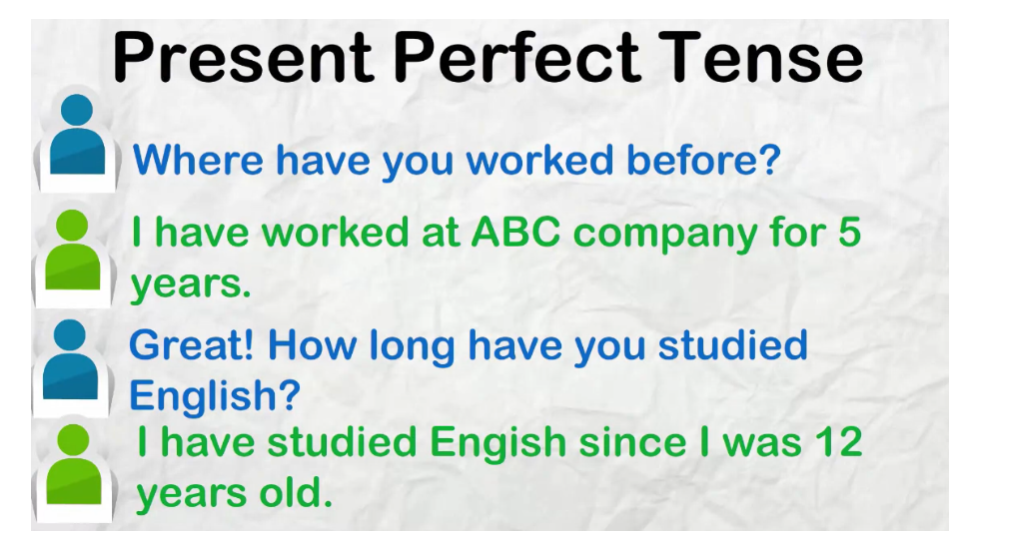
Now let’s look more closely at
your answers to the questions. Notice the verbs used in your answers,
have worked, and have studied. This is the present perfect tense, and
it often goes with the word for or since. The present perfect tense connects the
past with the present, and often uses for with a specific amount of time, or
since with the date in the past. When making present perfect tense,
I, you, we, they, goes with have followed by the past
participle of the main verb. He, she, it, goes with has, followed by the past
participle of the main verb. Both parts are needed to make
the present perfect tense. The past participle is the ED ending for
regular verbs, or irregular endings for irregular verbs,
such as written for write. In the sample sentence,
I have worked with computers for 10 years, have goes with the subject I, and
worked is the past participle of work. I have studied it since
I was 12 years old. Again, we use have because
of the subject I, and studied is the past participle of study. Now let’s look at a few
other sample sentences. Bill has grown since
the last time I saw him. Bill goes with has and grown is the past
participle of grow, the main verb. You have had a cold for two weeks. You goes with have and had is the past
participle of have, the main verb. And it’s perfectly okay
to have both have and had in the same sentence
using the present perfect. Notice that in each of these
sentences we use for or since to describe the amount of
time between the past and present. For 10 years, since I was 12 years old, since the last time I saw him,
for two weeks. For is used to show the length of time,
or how long something happened. For 12 hours, for 2 days,
for 5 weeks, for 8 years. Since is used to show when
the action started at a specific point in time in the past. Since yesterday,
since last year, or last month. Since I talked to you. Since we were away. Since a month ago. Since 1999. Let’s practice. Decide if we need FOR or
SINCE in each of the following sentences. And that’s the present perfect tense
connecting the past to the present using for and since.
Present Perfect without Since and For Lecture
You have already learned about using the present perfect tense with since and for for specified time. Now, you’re going to learn about using the present perfect with unspecified time.
After you watch the following video lecture, you will be able to:
- explain unspecified time in the present perfect tense
- use the present perfect tense correctly without since or for
Hi, I’m Judy. In this lesson, let’s talk about
the present perfect simple. Unspecified time without for or since. Just begin by looking at
some cool places to go. Do you like to travel? Have you seen a 2,000 year
old Colosseum in Rome, Italy? Have you experienced the bright lights of
New York City’s Times Square in the US? Have you ever felt the peacefulness
inside of Bamboo Grove in Kyoto, Japan? Italy, the US, Japan,
have you ever gone to these places? I have. Where do you think I live now? Actually, I live near Irvine, California. I have lived here for several years. I have lived in Irvine since 2013. Have lived, what verb tense is this? You may have learned that the present
perfect tense is formed with a helping verb has or have plus the past
participle of the main verb. When there is for or since,
it is specified time. The start time is said. You generally know when it began,
and the focus is on duration. How long from the past to now? In this example, I started living here in
the year 2013, and I still live here now. There is also present perfect without for
or since, this is unspecified time. For example, I have lived in Italy. You don’t know when I was there. The start time is unsaid. Maybe the date is not known,
or not important. In this case,
the focus is often on past experience. I have lived in Italy, means that I
lived in Italy some time before now. I want you to focus on what I did,
not when I did it. It’s like an accomplishment
something I’m proud of.

This lesson is about
unspecified experiential time. Has and have can be shortened, contracted. For instance, I’ve lived in New York,
means I have lived in New York. For the negative, we can add not,
which can also be shortened. I haven’t lived in Japan,
means that I have not lived in Japan. I actually did visit Japan on vacation,
but I didn’t live there. I’ve also been on vacation to Thailand,
another southern islands and a clean quiet beaches
Which sentence is correct? Judy has visited Thailand in 2014. Or Judy has visited Thailand many times. The answer is the second one. Why? To understand, let’s compare the past
simple tense with the present perfect. Remember, the present perfect without for
or since is unspecified time. Many times is not a specified time. You know that I went there,
in fact, you know that I went there more than once, but
it is not clear when I was there. 2014 is a specified time in the past. It is not the year 2014 anymore, so we cannot say,
Judy has visited Thailand in 2014. If we want to use a specified time
in the past, not including now, we use the past simple. Judy visited Thailand in 2014. In other words, there can also be
a difference between finished time and unfinished time.
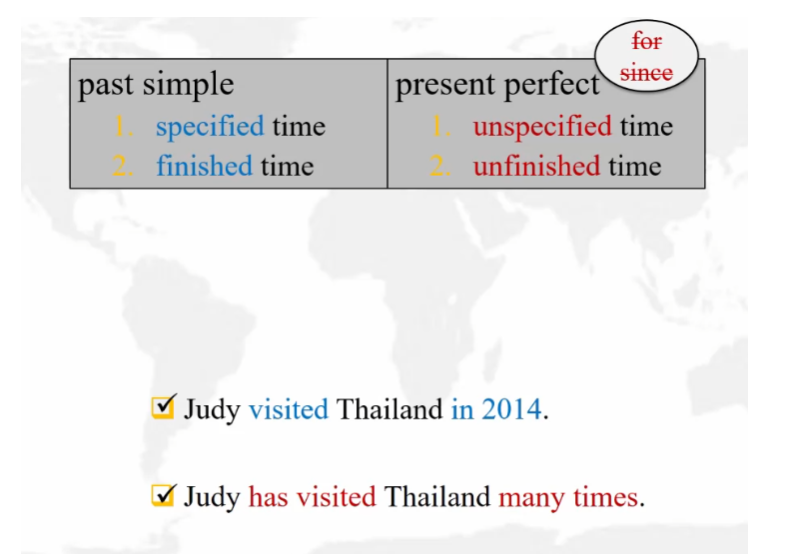
Here’s another example.
My favorite Thai drink is the mango lassi. I make this drink for breakfast sometimes. I drink two glasses of lassi this morning. This sentence is in the past simple tense. I have drunk two glasses
of lassi this morning. This sentence is in the present
perfect tense, unspecified time, which sentence means that
it is still breakfast time. In the second sentence,
this morning is unfinished time. It is still breakfast time now. If I want to, I can drink more lassi for
breakfast this morning. In the first sentence,
breakfast time is finished. It is not in the morning anymore. It is now in the afternoon or evening. I can drink more lassi today,
but not for breakfast. We’ve talked about many
amazingly cool places today. Lets review what we have learned. Do you remember how to form
the present perfect tense? Here’s a hint, look at the red words. The present perfect is has or
have plus past participle. What do we mean by unspecified time? That’s right. There is no for, or
since that tells us the start time. We’ve talked about many cool places. The start time is unsaid. The time is not important,
not known, or maybe not finish yet. The focus is on the experience
of us talking together. I’ve gotten a lot of
stamps in my passport, and I’ve shown you a few of my favorites,
but there are still many blank pages. Where shall we go next? Maybe next time we meet you can tell about
the wonderful places that you’ve been to. Until then, bon voyage.
Practice Quiz on Present Perfect

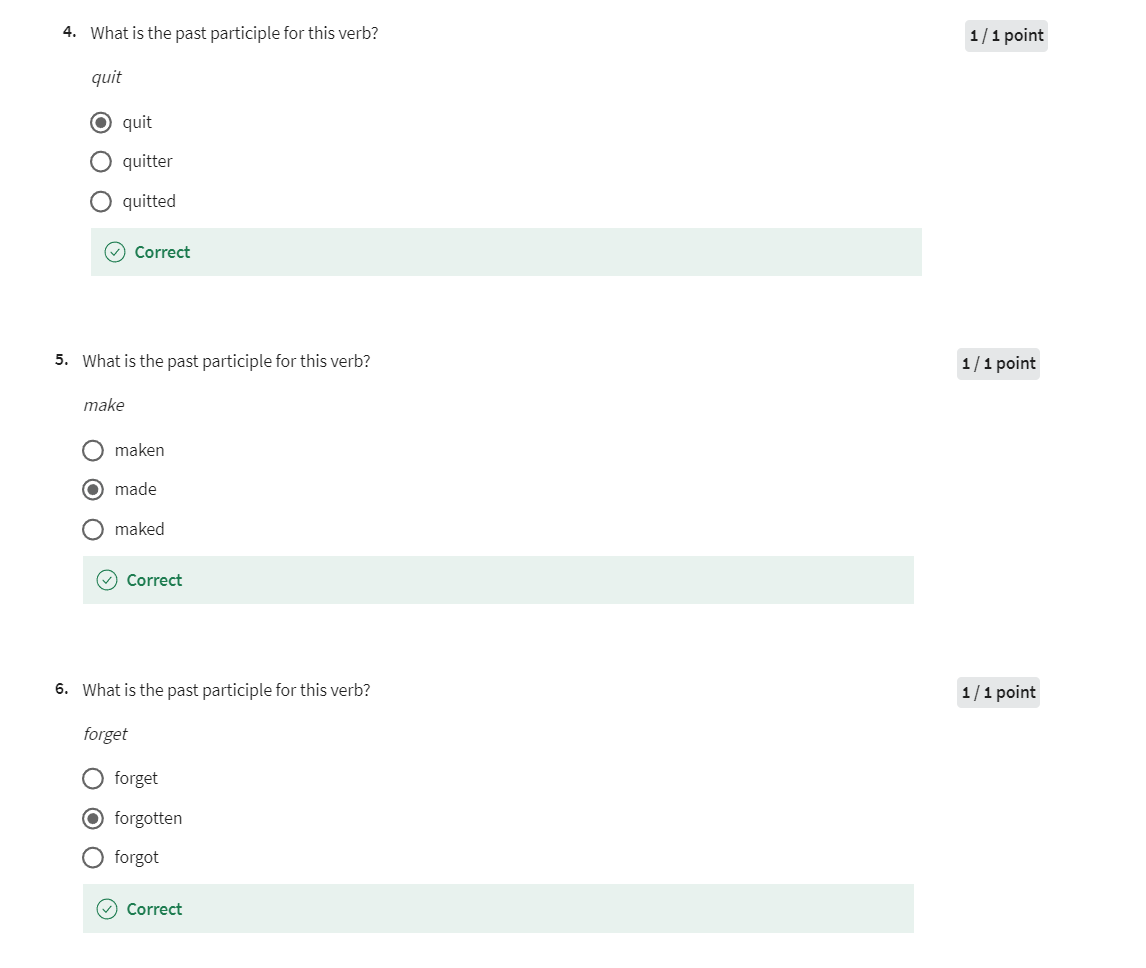
Present Perfect Questions Lecture
You’ve learned how to make statements in present perfect. In this lesson, you will learn about forming questions correctly using the present perfect tense.
After watching the video lecture, you will be able to:
- ask yes/no questions correctly using present perfect
- ask wh- questions correctly using present perfect
- answer questions correctly in present perfect
Question and short answer forms part one. The present perfect simple tense. [SOUND]
Which floor? >> 20 please. >> Hey I’ve heard of that book before. It’s supposed to have lots of
interesting facts about dinosaurs. >> Yeah. It’s pretty good. I love dinosaurs. >> Have you read about dinosaurs before? >> Yes, I have. I studied them in college. >> Where have you studied dinosaurs? >> At UC Irvine. >> They have a famous program there. Who have you studied with? >> Professor Gilpin. >> Wow!
He’s awesome! [SOUND]
This is me. Bye! >> Bye.
In the conversation, Linus uses the
present perfect tense to form questions that asked about past experiences. Linus asked have you read
about dinosaurs before? In forming yes/no questions like this,
in the present perfect tense, begin with have or has, then the subject, then
the past participle form of the main verb. Answers for
these types of questions can be short. You can simply say yes I have or
no I haven’t. Easy, right?
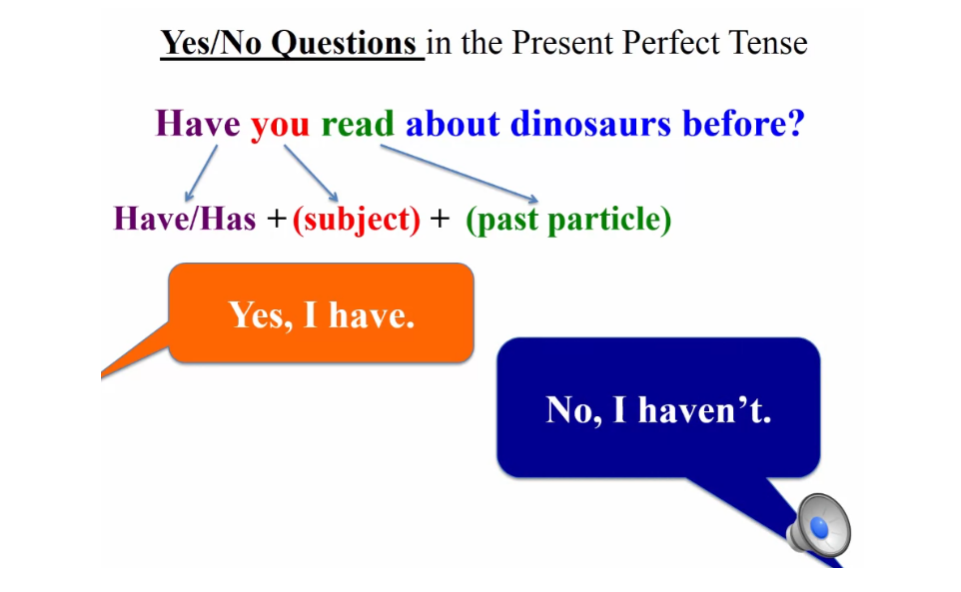
You can also ask different types
of questions using words like who, what, where, when, how, and which. These are all Wh words that can be used to make wh questions. Have you studied dinosaurs? This is a yes no question but where have
you studied dinosaurs is a wh question. To form these types of questions just add WH-words to the beginning
of yes no question forms. The WH-word + have/has, then the subject,
then the past participle.
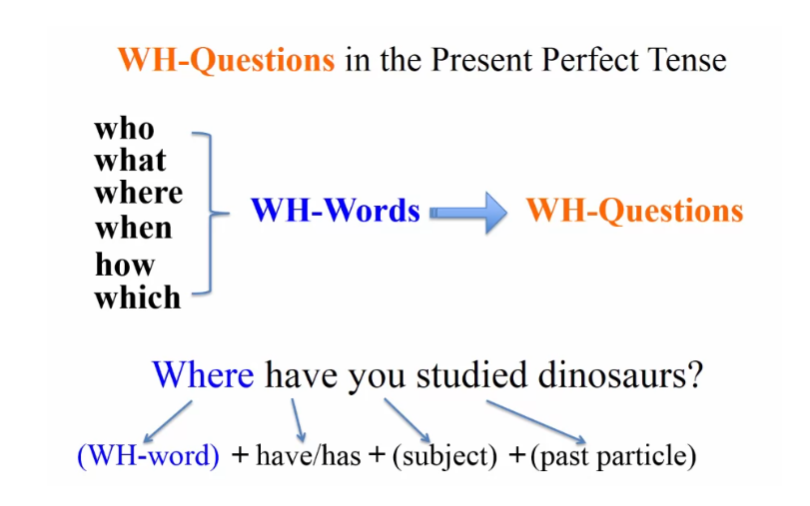
Do you remember Linus’s
very last question? That’s right. Who have you studied with? This is also a WH-question
that uses the same structure, the WH word, plus have or has, then
the subject, then the past participle. Who have you studied with? Great job.
Now do you think Linus is interested
in the girl with the book? Watch our next video to find out. Our next video is on question and
short answer forms for the present perfect progressive tense. Thanks for watching.
Practice Quiz on Present Perfect Questions


Present Perfect Adverbs Lecture
Now you will watch a video lecture on using adverbs with present perfect.
After you watch this lecture, you will be able to:
- use correct word order with adverbs
- use appropriate adverbs for the present perfect tense
Present Perfect Tense:
Frequently Used Adverbs. Ever, never, yet and already. Hi Nicky! Hey Naomi! Hey, I was wondering. Have you ever been to Canada? I’m going there by myself next month. Well, yes I have. Actually, I go to Canada quite often to
see family, but I’ve never gone alone. Do you often travel alone? Well no, I haven’t tried it yet. Next month will be my first time. It should be great. Canada is a very beautiful and safe place. I recommend going to Quebec City. It’s my favorite city. Really? I wish I had spoken to you earlier. I’ve already purchased my
plane ticket to Vancouver. Yeah?
Well, Vancouver is great, too.
In the conversation you heard the present
perfect tense used with different adverbs. Have you ever been to Canada? I’ve never gone alone. I haven’t tried it yet. I’ve already purchased a plane ticket.

Ever is used most often to make questions. Questions like have you ever been to
Canada, which is an affirmative question. But you can also make negative
questions using ever, like haven’t you ever been to Canada,
using have with not. The negative question, like all negative
questions, just expresses surprise. But both forms of ever
are asking if you’ve ever experienced something
at some point in your life.
Never is like the opposite of ever. It is used in statement form and it means you have not ever experienced
something at any time in your life. Like when Nicky says
I’ve never gone alone. Which means that she has never in
her life gone to Canada alone.
Yet is like ever because it can
be used to form a question. But you can also use it to form negative
statements, like, I haven’t tried it yet. Yet focuses on the idea that
there’s an action not finished or completed but you believe you will. Naomi believes she will go to Canada and
travel alone. So she uses yet. I haven’t tried it yet.
Already can also be
used to form questions. But, the statements formed
are usually in the affirmative. Like when Naomi says,
I have already purchased a plane ticket. So, as we can see in this sentence,
already focuses on a finished action that
does not need to be done again. The action is done. Naomi does not plan to buy another ticket.
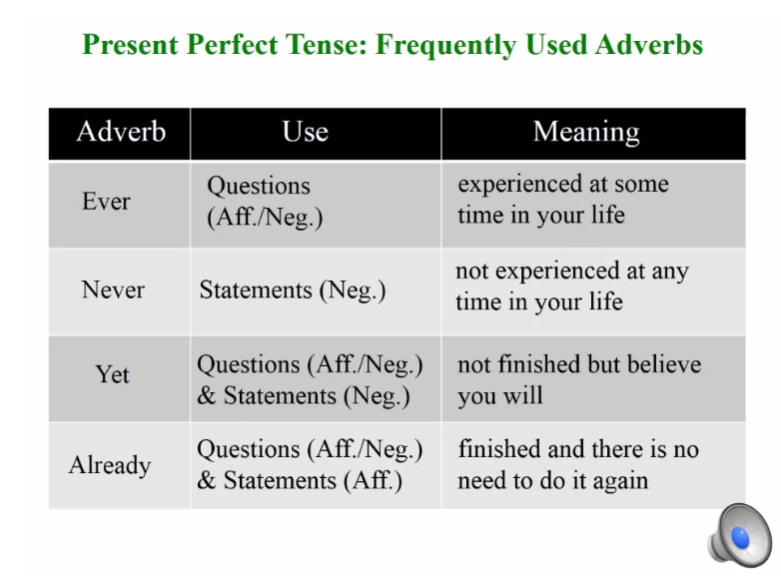
Let’s look at some more examples,
starting with ever and never, which are often used
together in conversation. Have you ever ridden an elephant? The grammatical structure here is,
have or has, plus the subject, plus ever. Then the past participle of the main verb. Have you ever ridden? If someone asked you this
question how would you answer? You could simply answer with, yes, I have, which just means, yes,
I have ridden an elephant. Or maybe your answer is, no, I haven’t. And this just means, no,
I have never ridden an elephant. Notice where never is in the sentence. After the subject comes have or has,
and never plus the past participle. I have never ridden. Remember not to use, not and
never in the same sentence. They both make sentences negative. You only need one.
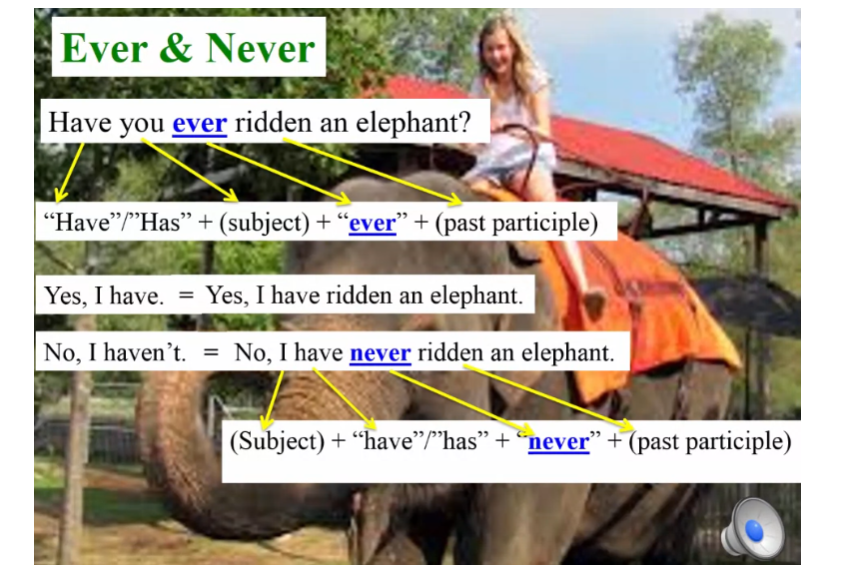
Look at this fruit. It is a dragon fruit. Have you ever eaten dragon fruit? What is your answer? Yes, I have.
I have eaten dragon fruit. No, I haven’t.
I have never eaten dragon fruit. I hope you didn’t say,
I have not never eaten dragon fruit. That’s two negatives. [SOUND] Are you ready for Yet and Already? Okay. Imagine your roommate saying,
have you brushed your teeth yet? It’s time to go! Where is yet in the question,
it is at the end, that’s right. If your answer is no,
you would simply say, no, I haven’t brushed my teeth yet. If your answer is yes, you’d say,
yes, I’ve brushed my teeth. But if you want to show that
it’s a finished action and you don’t have do it again,
you can add already. You can add it between have and the past
participle or at the end of the sentence. You can say, I’ve already brushed my
teeth, or I’ve brushed my teeth already. We can go. Yet & Already.
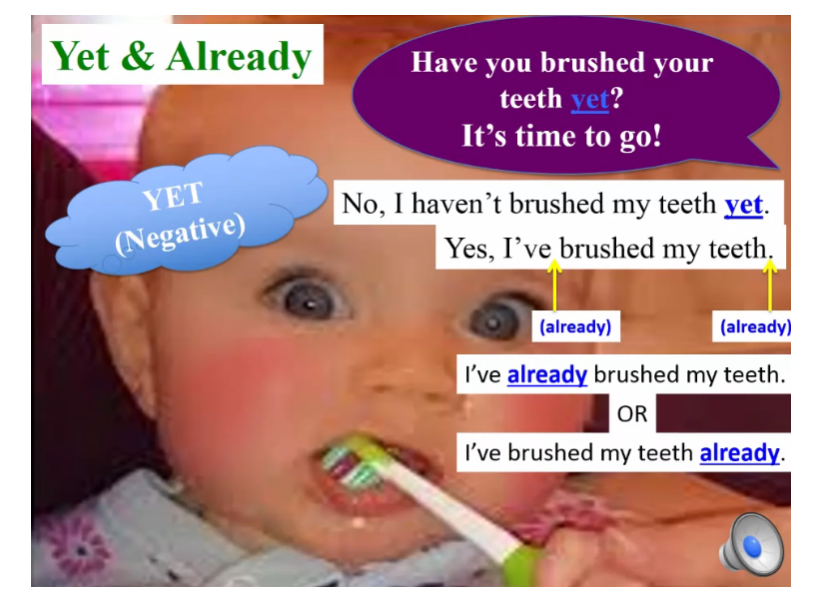
Let’s look at a negative
question using yet. Haven’t you finished your homework yet? It’s time to go to bed. Remember, this negative
question expresses surprise. Surprise that the homework
is still not done. You might answer, no,
I haven’t finished my homework yet. Okay, you have ten more minutes, or
yes, I’ve already finished my homework, or yes, I’ve finished my homework already. Good then get ready for bed.
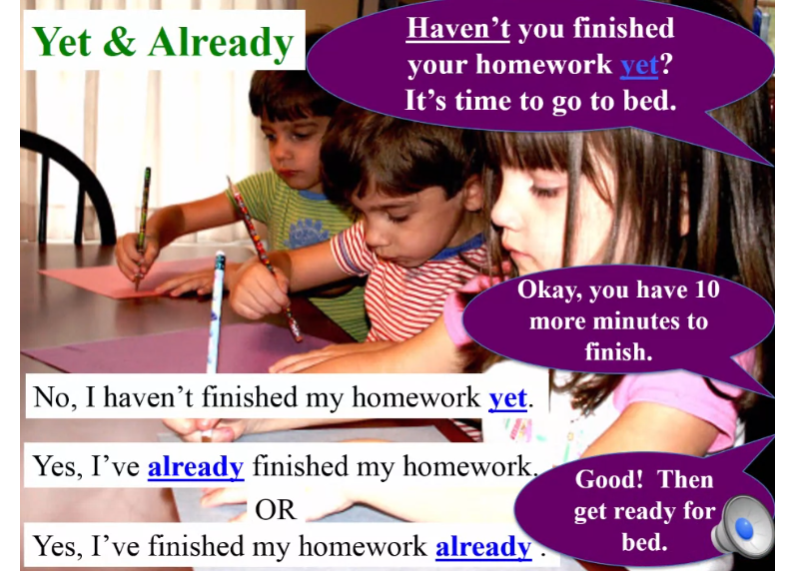
Here’s a quick review. Try answering this question. Have you ever climbed a mountain? What am I asking? I’m asking if at any time in your
life you have climbed a mountain. Like this man. Perhaps your answer is. Yes, I have, it was amazing. Or maybe you’re thinking, no, I haven’t,
I’ve never climbed a mountain, but I hope to some day. Okay, what about this question,
have you done the laundry yet? You might say, no, I haven’t done
the laundry yet, I’ll do it later. Or, you could be thinking, yes,
I’ve already done the laundry. Yes, I’ve done the laundry already. All right.
Now you can go ask people lots of questions using ever,
never, yet and already. Thanks for listening.
Practice Quiz on Adverbs
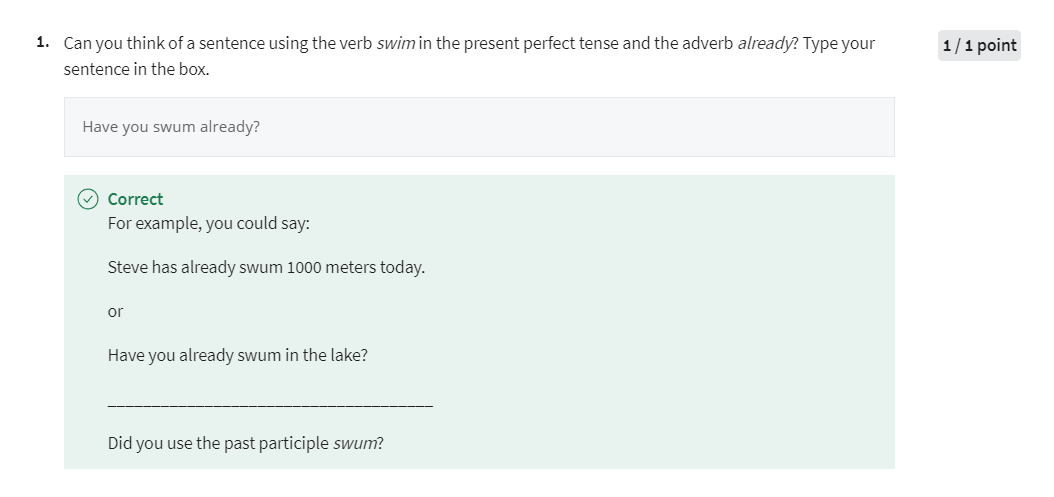

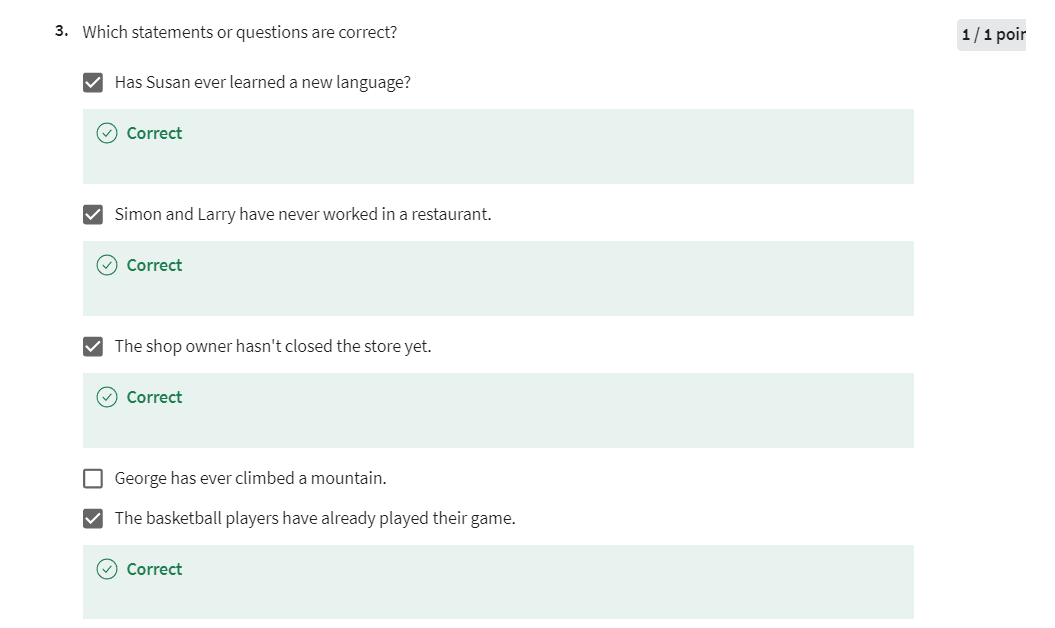
Graded Assignment: Present Perfect Assignment
Practice using the present perfect tense. Write two questions with answers and two statements.
For example:
Questions
- A: What have you eaten today?
B: I have eaten a banana and a sandwich.
- A: Have you ever been to Disneyland?
B: No, I haven’t. I have never been to Disneyland.
Statements
- My boss has asked me to work late this Friday.
- James hasn’t spoken to me since last month.
My try:
Questions
A: Have you seen that movie?
B: No, I haven’t.
A: What books has he read?
B: Educated.
Statements
- Bob hasn’t have a tweeter account yet.
- Alice has already finished the housework.
Graded Quiz: Present Perfect Quiz
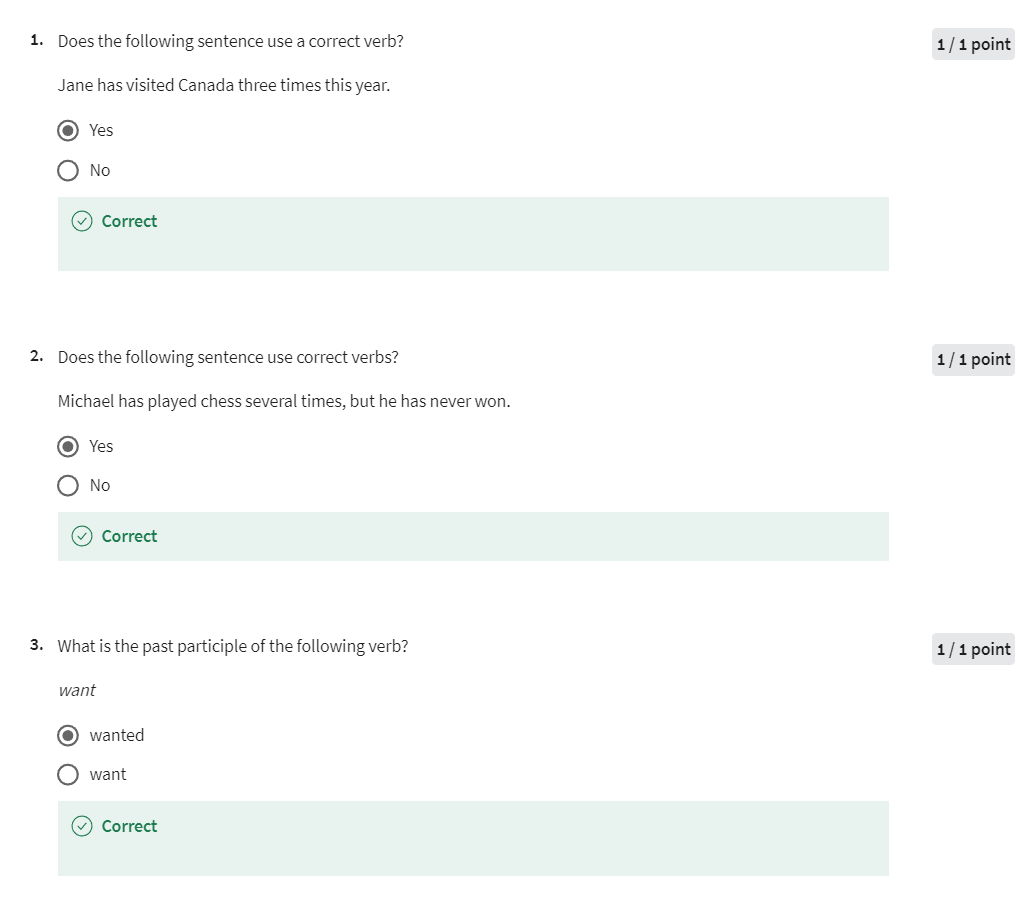
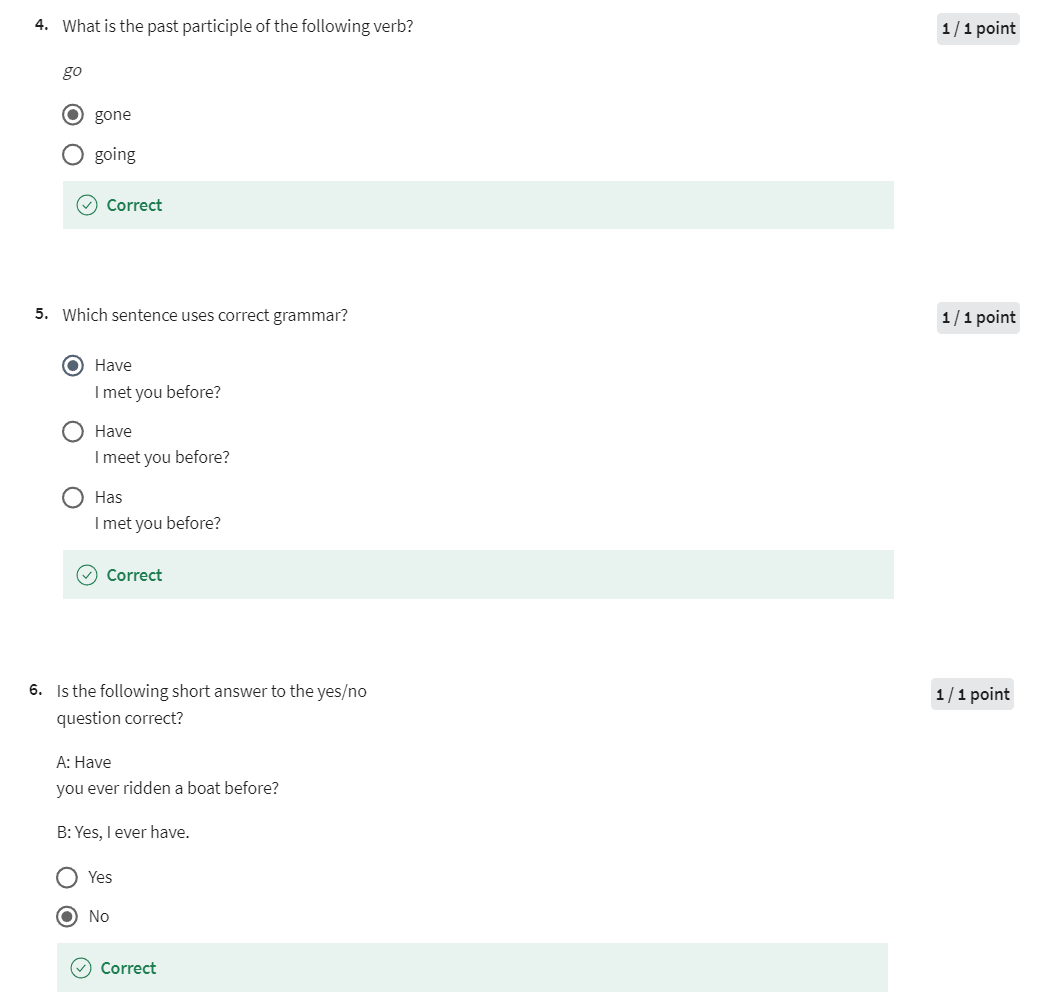
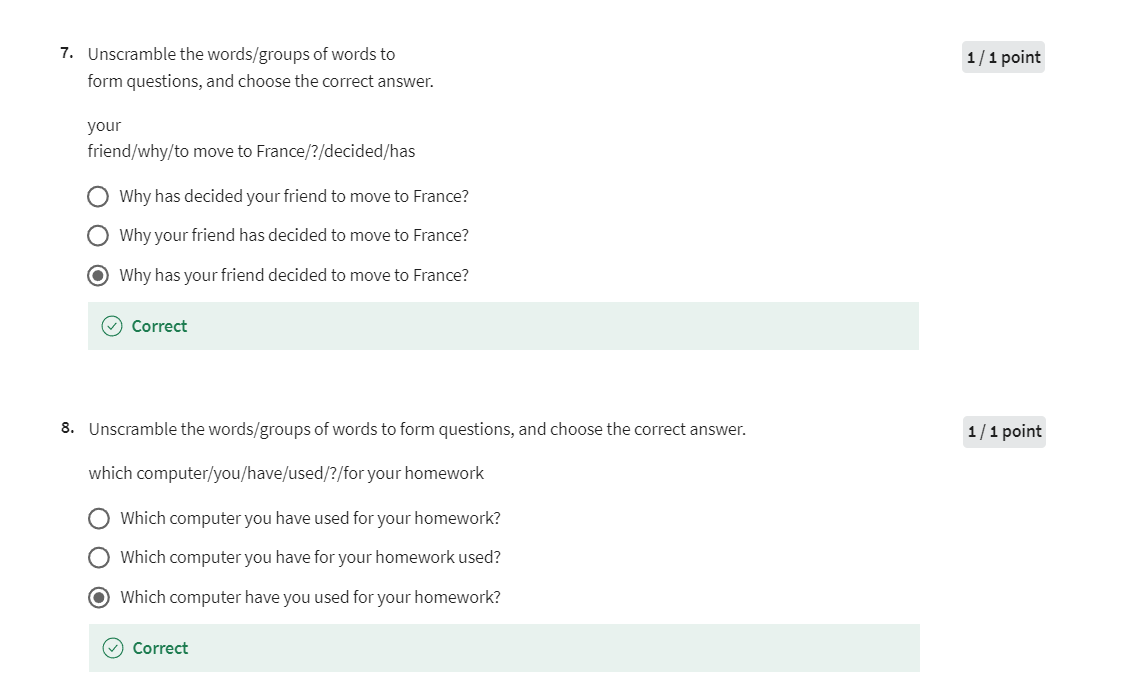
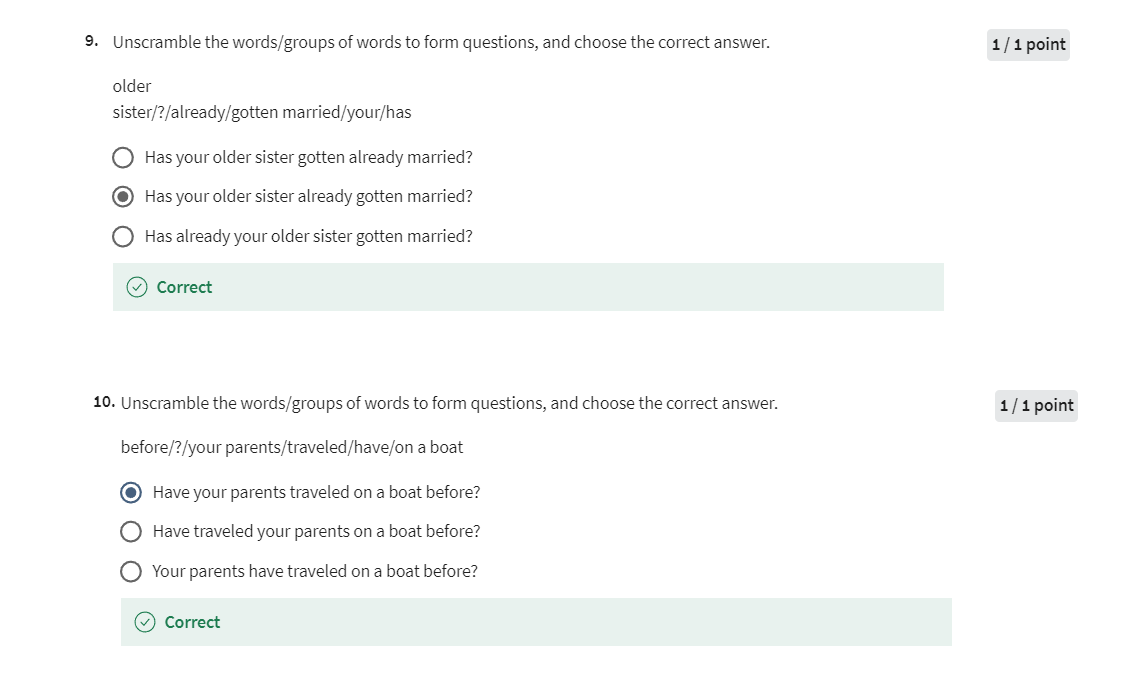
Week 02: Present Perfect Progressive
Now that you’ve learned about the present perfect tense, you’re going to learn about the present perfect progressive. To start, you’ll review when to use progressive tenses in English. Then you’ll learn how to form the present perfect progressive and how it is different from present perfect.
Learning Objectives
- explain the difference between stative and non-stative verbs 解释静态动词和非静态动词的区别
- determine if a verb is stative or non-stative based on its usage in a sentence
- determine if a verb can be used in a progressive tense or not
Stative Verbs Part 1 Lecture
Stative verbs, also known as non-action verbs. Part one. I am enjoying a beautiful day at the park. I see people everywhere. I hear children laughing and
people talking. This man prefers the shade. This woman likes the sun. Everyone is relaxing. Do you know what kinds of verbs these are? This are stative verbs,
also called non-action verbs.
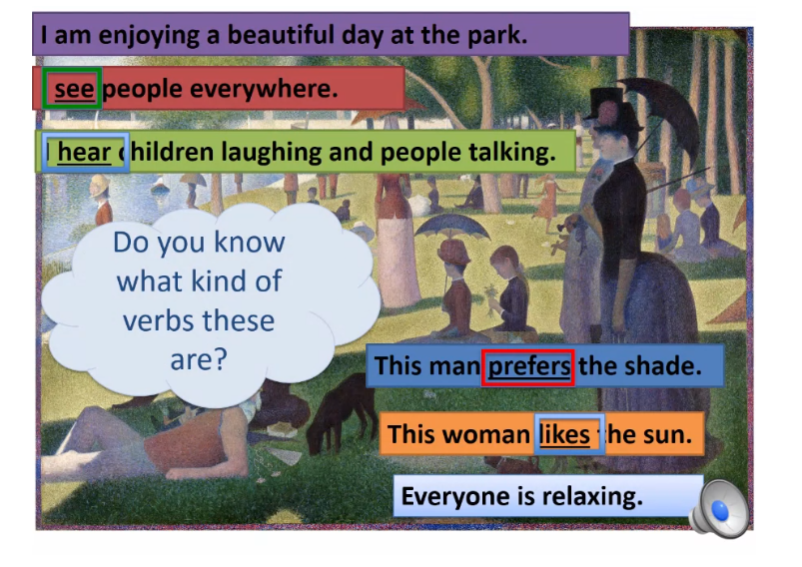
They do not express an action,
they express a state. We use them to talk about thoughts,
emotions senses, and states of being. We do not use them to talk about actions.
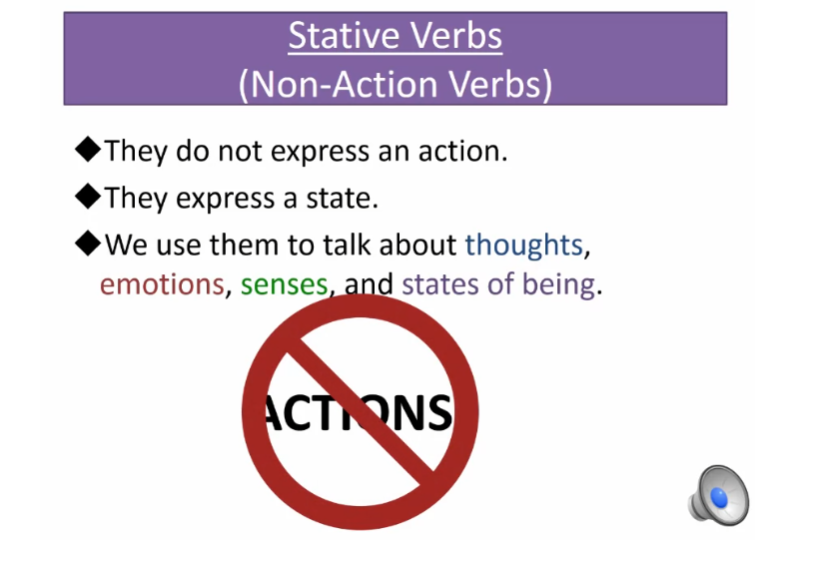
Let’s look at some examples. Mary believes that sun can make her happy. Believe is related to thoughts. Other examples are agree, remember, understand, prefer, and know.

John hates the sun, so
he is sitting in the shade. Hate is related to emotions. Other examples of stative
verbs that are related to emotions are love, like and dislike. I bet this dog is thinking,
mm, this grass tastes good! The verb taste is related to the senses. Other examples of stative verbs that
are related to the senses are hear, smell, sound, see, feel, and look.
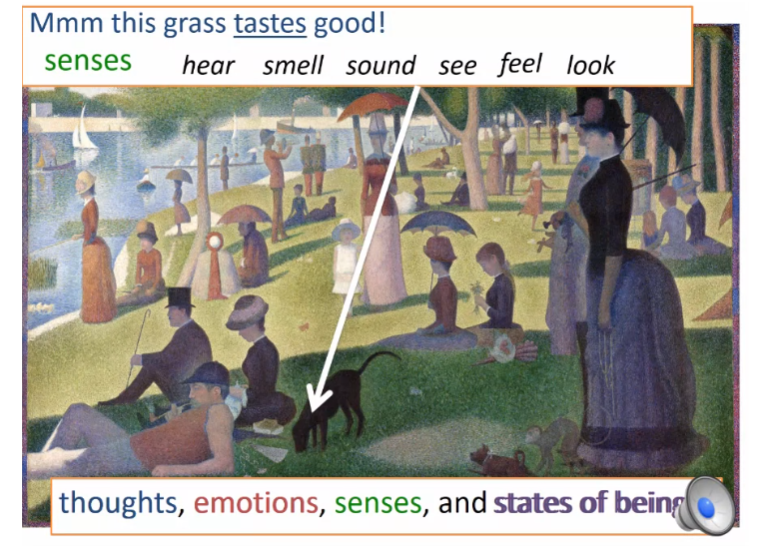
Here in the park almost
everyone has a hat. The verb have is expressing
a state of being. Other examples are be,
appear, need, and want.
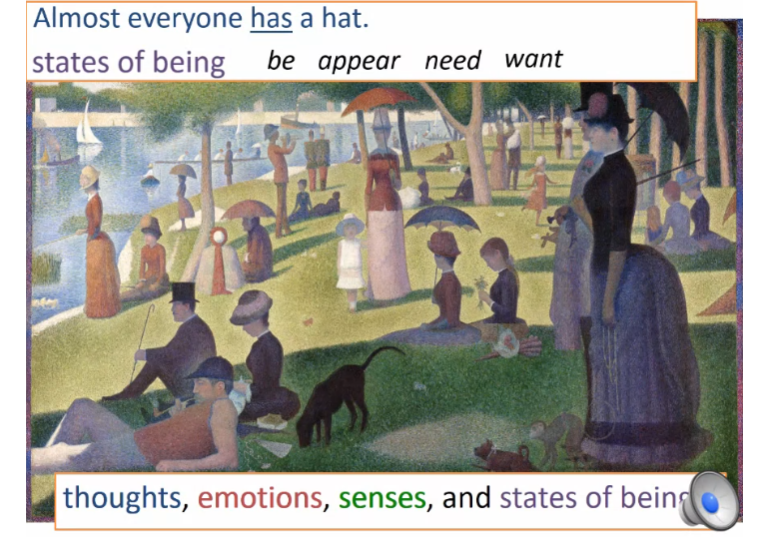
Careful, do not use verbs that
express states with -ing. Here are some examples of how you
can use stative verbs correctly. The music sounds beautiful. Who wants something to drink? You are so handsome. Do you hear that? Do you know where mom went? We must not use -ing with stative verbs. Notice, none of those examples have -ing. We cannot say, sounding, wanting,
being, hearing or knowing. It’s incorrect. Because we can’t use
-ing with stative verbs, that means we can’t use stative
verbs in any progressive tenses. However, we can use
action verbs with -ing. But you already knew that. For example,
we can say they are listening to music. They are eating food. A man is singing. The children are playing with each other. Watch part 2 of stative verbs to learn
about some important exceptions. Thank you and goodbye.
静态动词(stative verbs)是指表示状态、感觉、想法、关系等方面的动词,通常不表示行为或动作。以下是一些常见的静态动词:
- be(是,存在):例如,“I am happy.”(我很开心。)
- seem(似乎):例如,“She seems tired.”(她看起来很累。)
- appear(似乎,显然):例如,“He appears confused.”(他似乎很困惑。)
- feel(感觉):例如,“I feel cold.”(我感觉冷。)
- look(看起来):例如,“You look beautiful.”(你看起来很美。)
- taste(尝起来):例如,“This cake tastes delicious.”(这块蛋糕尝起来很好吃。)
- smell(闻起来):例如,“The flowers smell lovely.”(这些花闻起来很香。)
- sound(听起来):例如,“The music sounds relaxing.”(这音乐听起来很舒缓。)
- believe(相信):例如,“I believe you.”(我相信你。)
- know(知道):例如,“She knows the answer.”(她知道答案。)
- understand(理解):例如,“I understand the instructions.”(我理解了说明。)
- own(拥有):例如,“They own a big house.”(他们拥有一栋大房子。)
- possess(拥有):例如,“He possesses great knowledge.”(他拥有丰富的知识。)
- want(想要):例如,“She wants a new car.”(她想要一辆新车。)
- like(喜欢):例如,“They like chocolate.”(他们喜欢巧克力。)
这些动词通常用于描述状态或感受,而不是特定的动作或行为。
Stative Verbs Part 2 Lecture
Stative verbs.
Part 2. Okay, there are some exceptions
you should know about. Some verbs can express both states and
actions, depending on the context. Take the verb think for example. We can use think as an action verb or
a verb of state. Let’s take a look at how think
can be used as an action verb. We can say, he is thinking about lunch. He is not thinking about class. In this case, we can use think with
ing because it’s expressing an action. However, If I say,
she thinks the teacher is boring, now I’m using think as a verb of state. Here think means believe, so
we cannot use it with ing.
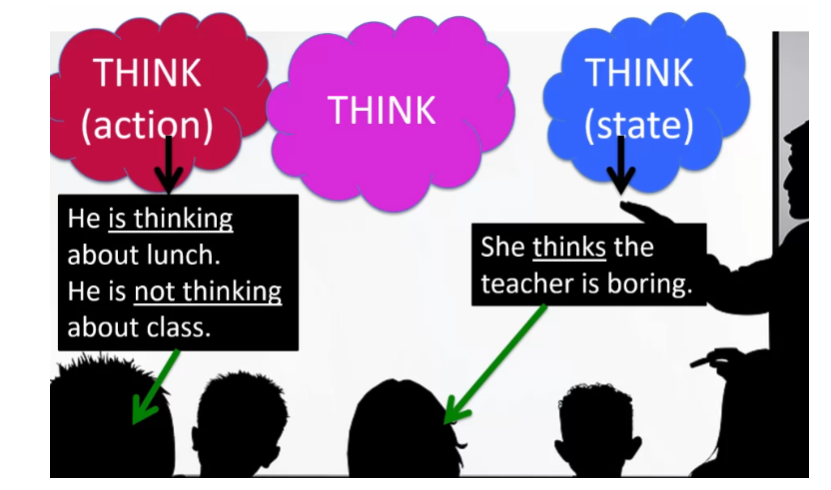
Be is another example. It can be used an action verb,
and a verb of state. Bob is usually a good student, but
today he is being disrespectful. Here we can use be with ing to express that something is
different than it normally is. Alex is the youngest in the class. Here it’s a verb of state so
we can’t use ing.
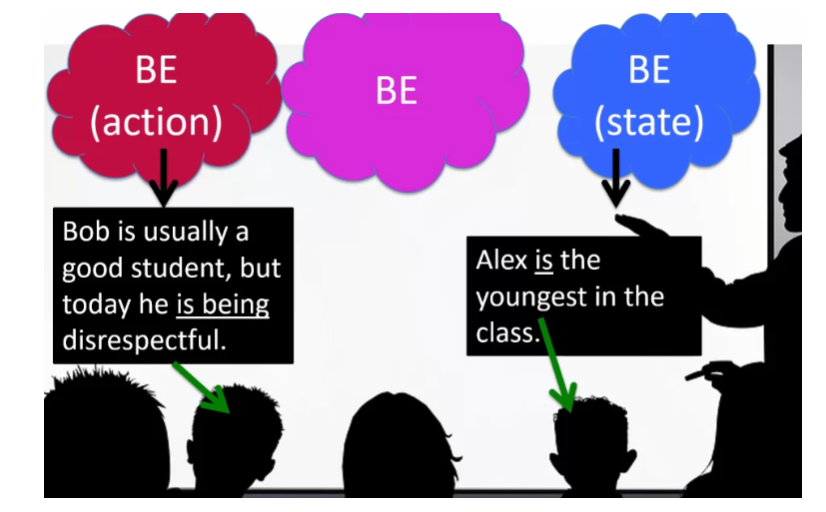
Have, can also be an action verb,
and a verb of state. Maria is having a hard time understanding. The teacher has some
important information.
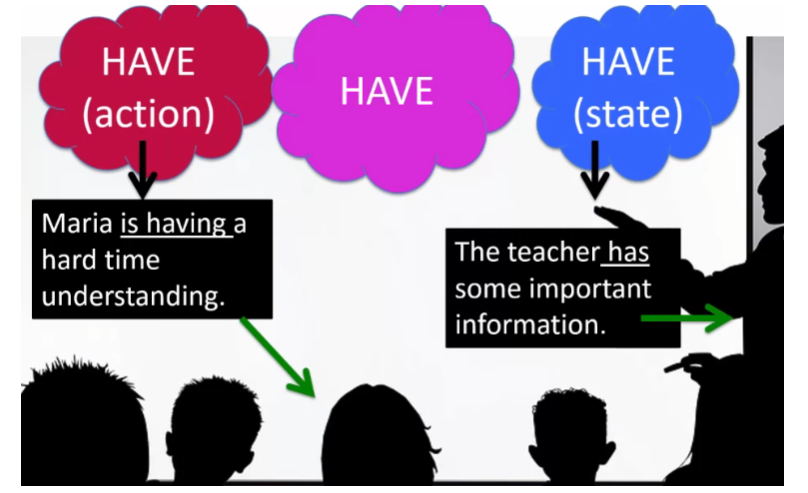
Here are some more examples of verbs that
can express both states and actions. Can you decide which group of examples
shows states and which shows actions? At the cafe, Some people are tasting the coffee
to make sure it’s not too hot. The man is smelling his food
before he takes a bite. A woman is looking at a menu. The man and woman may fall in love, but
right now they are just seeing each other. If the food tastes delicious, most of these customers will return. It smells wonderful at this cafe. These people look relaxed and happy. Do you see the man in the orange shirt? Okay, do you know which
sentences have action verbs?
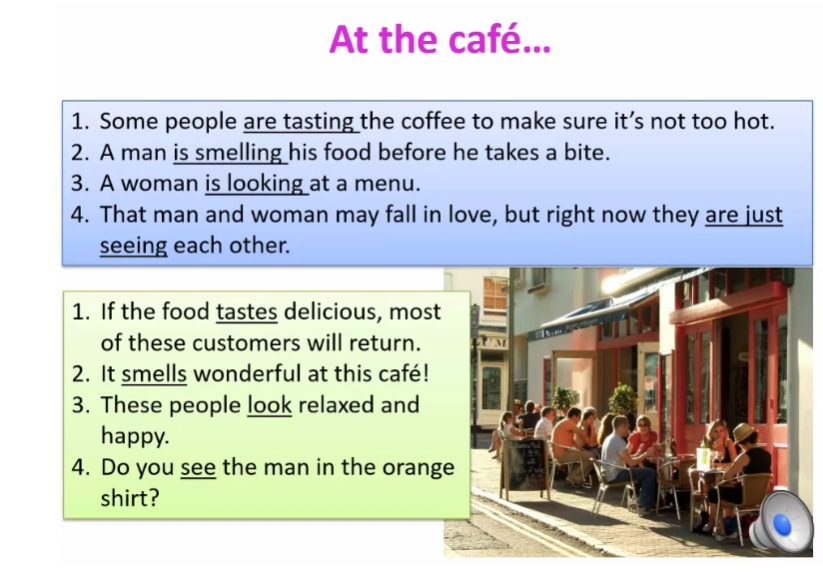
Yep, you’re right, these ones do. We’re talking about right now. Describing a scene at a cafe. We can use the present progressive with
these verbs because they’re actions. What about the other sentences,
and the other verbs? You know it. These ones are stative verbs. That’s why,
even though we’re talking about right now, we are not using the present
progressive tense. Okay, here are a few more examples
of stative verbs used correctly. Think about how you would
answer these questions. Imagine you are here. You are enjoying a beautiful
night at the pier. What do you see? What do you smell?
What do you hear? Do you prefer to relax on the beach? Or do you want to go on the ferris wheel? Use stative verbs and action verbs
to describe the pier at night. Now you know about stative verbs. Thanks for listening. Goodbye.
Practice Quiz on Stative Verbs
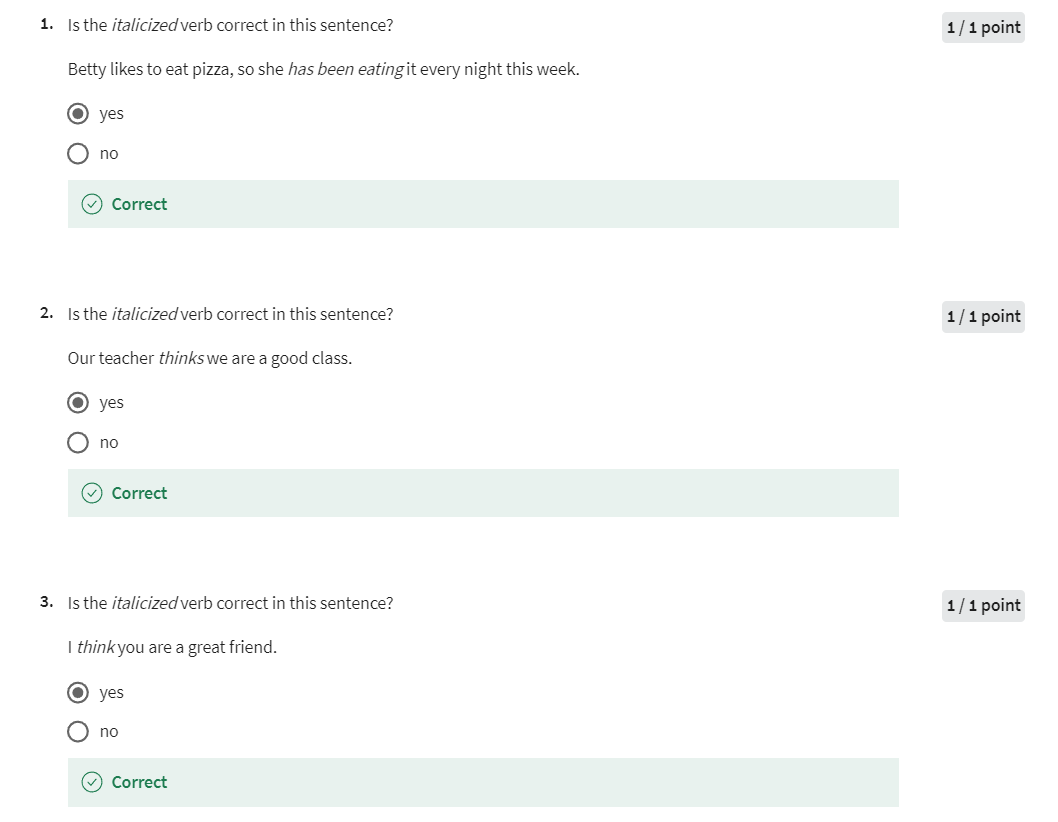
Stative Verbs Practice 1
Practice
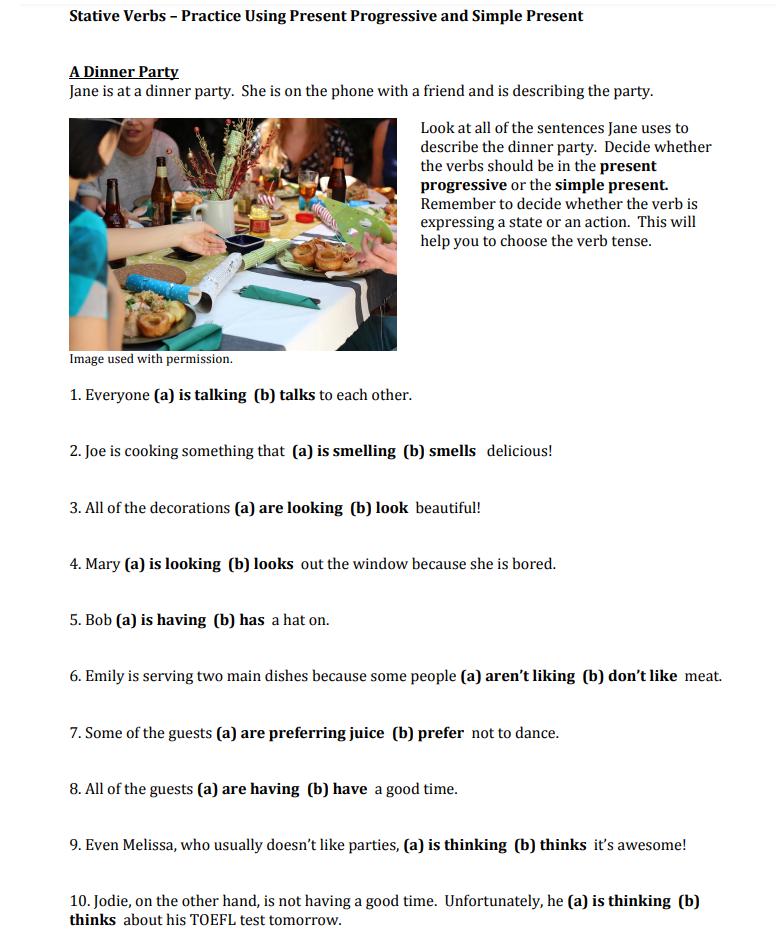
Answer
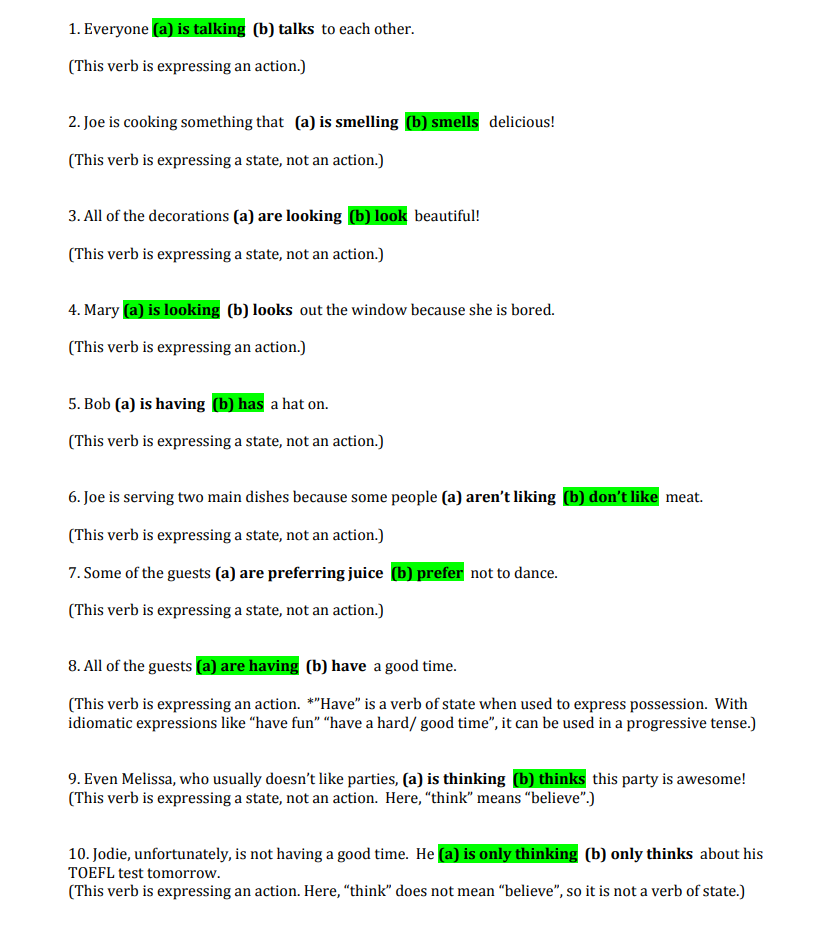
Present Perfect Progressive Overview Lecture
You have reviewed stative verbs and progressive tenses. Now, you will learn about the present perfect progressive.
After you watch this video lecture, you will be able to:
- form the present perfect progressive correctly
- explain when to use the present perfect progressive
- explain the difference between present perfect progressive and present perfect tense
The present perfect progressive. How long has Jake been swimming? It is 1:30 in the afternoon. Jake is swimming right now. She started swimming at one o’clock. [SOUND] How long has she been swimming? She has been swimming for 30 minutes. She must be tired.
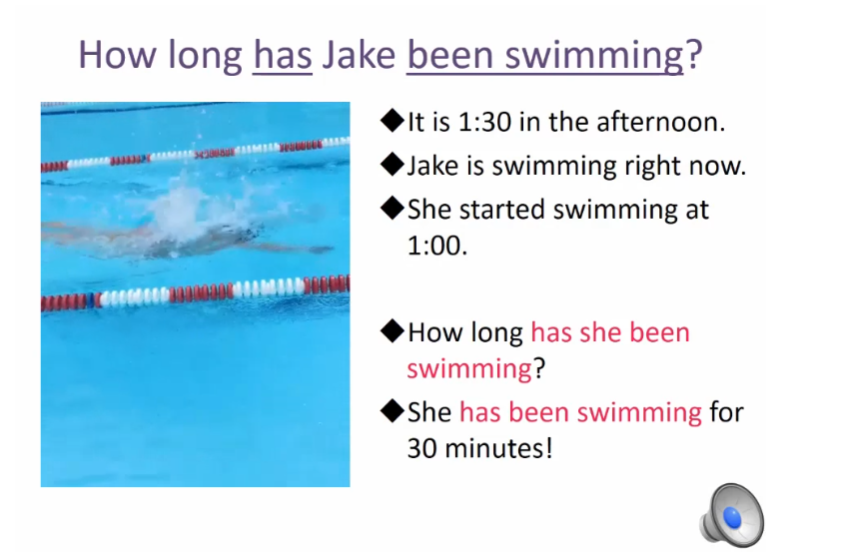
Let’s look at how we form
the present perfect progressive. Of course we need a subject and then we need has or have, been and a verb in the ing form or
a present participle. For example, she has been swimming for
thirty minutes. We can also say,
she has been swimming since 1:00. We use for with an amount of time,
like thirty minutes. And since,
with a specific time in the past. Like 1:00 or maybe yesterday. We can also make shorter forms of this
verb tense by making contractions. Like she’s, he’s, it’s, I’ve, you’ve, they’ve, and we’ve. All followed by been and I-N-G.

For example, you’ve been watching
this presentation for a few minutes. To make a negative statement, all we need to do is add nots in between have and
been. For example, she has not been swimming. What has she been doing? She’s been sleeping. How lazy! We can also make negative
contraction forms. She, he, it, hasn’t, I, you, we, they, haven’t, followed by been and ing.
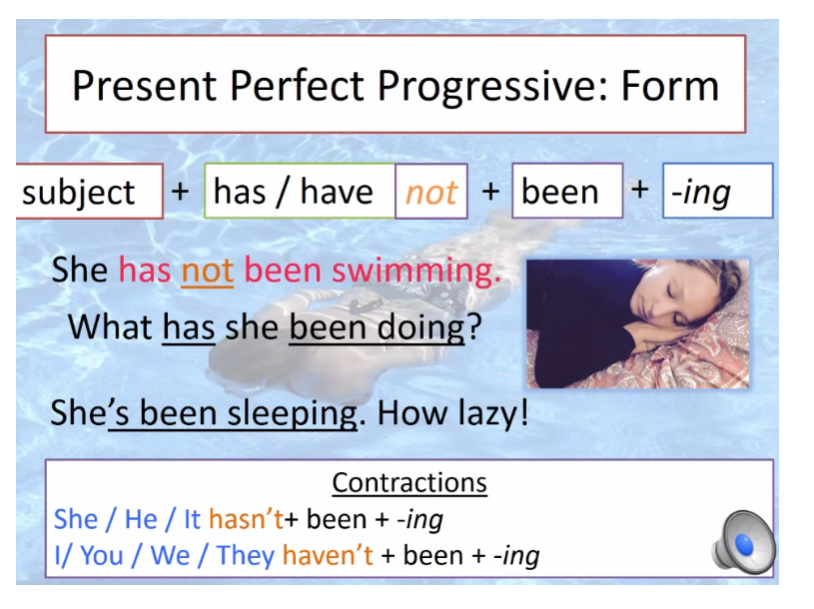
For example, for the last five minutes,
I haven’t been lying on the beach. I’ve been talking to you about grammar. All right, now let’s talk about why we
use the present perfect progressive. We use this tense to
talk about an activity that began in the past and
is in progress right now. We also use it to talk about how long
an activity has been going on or the duration of that activity.
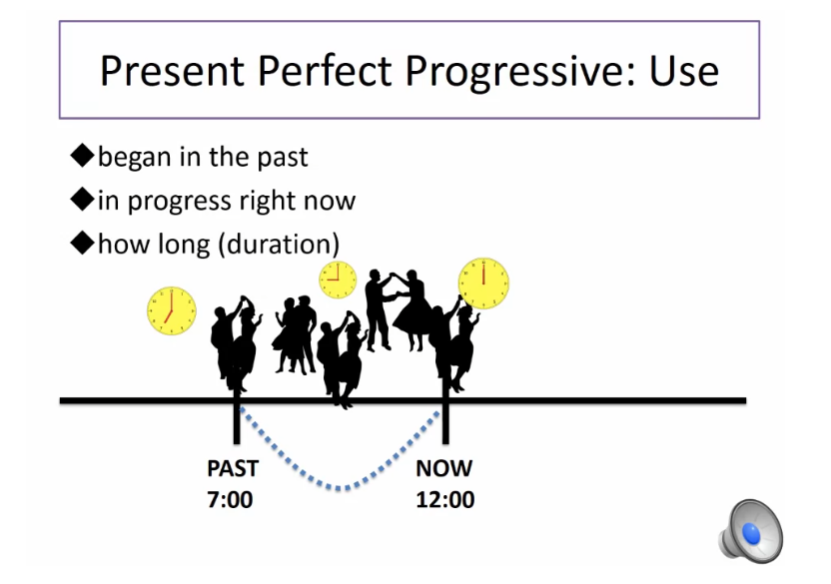
For example. [MUSIC] When Shonda got to the party at 7:00,
she started dancing. At 9:00 she was still dancing. Now, it’s 12:00 and she is still dancing! Who knows when she’ll stop? So we use the present perfect progressive
to show how long she has been dancing. She started in the past,
and she’s still doing it. She has been dancing for five hours! She must be exhausted.
It is possible to use the present perfect
progressive without since or for. Often we can use it with
the adverbs recently or lately to talk about a recent habit.

Grrr, look how strong I am. It looks like someone wants us to know
he’s been working out a lot lately. Be careful. You need to be aware of
the differences between the present perfect progressive and
the present progressive. For example,
we can say Emily has been reading for three hours to show that she
started reading three hours ago, and she’s still reading. We can also say Emily
is reading right now. However, we cannot use the present
perfect progressive with right now. It is wrong to say Emily has
been reading right now, and we can’t use the present
progressive to show duration. So it’s impossible to say Emily
is reading for three hours. So with the present perfect progressive, we can show that something started in
the past and is still going on now. We’re showing a length of time or
the duration of time of an activity. But with the present
progressive we can only express what is happening right now.
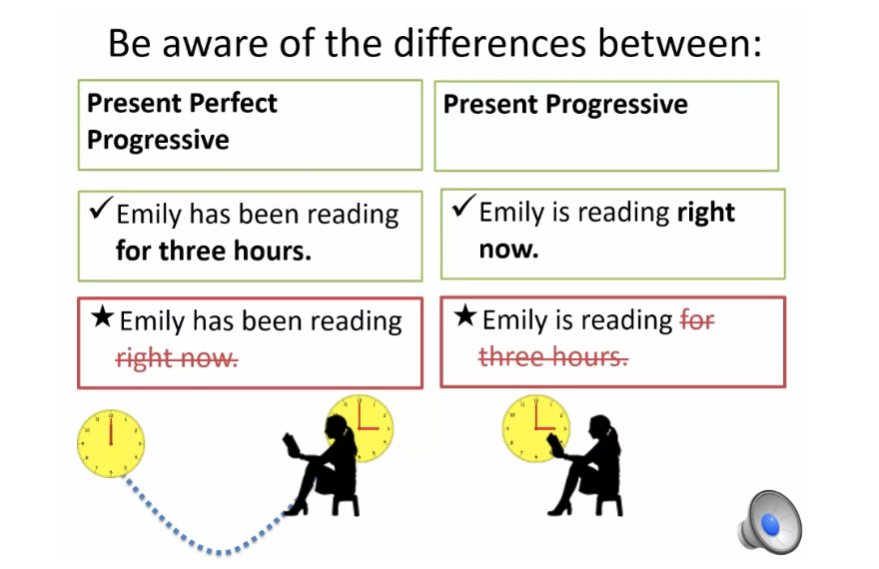
When we use the present
perfect progressive it’s important that we only use action verbs. For example the horse has been running for ten minutes. They have been dancing all night. I’ve been driving since the morning. Run, dance, and drive,
are all examples of action verbs that we can use with
the present-perfect progressive. However, we cannot use non-action verbs,
also called verbs of state. For example, we cannot say, I have been
knowing my best friend for ten years. That sound terrible. Instead we would say I have known my best friend for
ten years using the present perfect. Not the present perfect progressive.
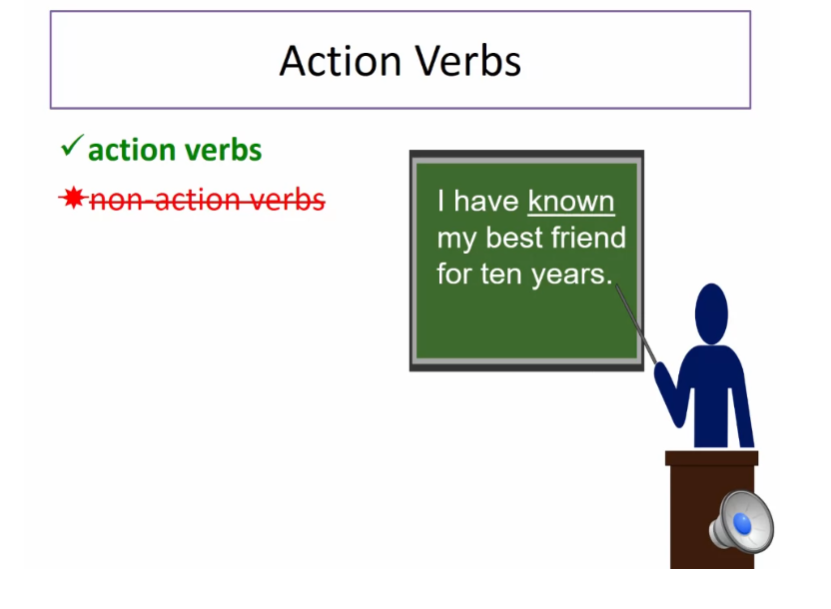
Here are a few more examples,
of non action verbs, that we shouldn’t use in
the present perfect progressive. Except in special cases. Like, understand, seem,
taste, have, appear, prefer. And there are many others. Okay let’s practice. Put the words in order
to find out the answer. You will not use all of the words. Steve called Melisa at 5:20. Now it’s 5:40, and
they are still on the phone. How long have they been
talking on the phone? Can you use the words on
the right to make a sentence? Good, they have been talking for 20 minutes. Good job. Okay, time for some more practice. Create sentences to show how long
an activity has been in progress. All right, let’s start with number 1. The boys met to play soccer at 3:00. They’re still playing soccer now at 5:00. They have been playing soccer since 3:00. Number 2, my mom is cooking dinner, she started right when she got
home from work an hour ago. She has been cooking for an hour. Number 3. It’s the end of August now, and we’ve been traveling in Europe
since the beginning of June. We have been traveling for three months. Number 4, it’s 6:00 AM and
Bob is still asleep. He has been sleeping for ten hours. He has been sleeping since 8:00PM. Good job.
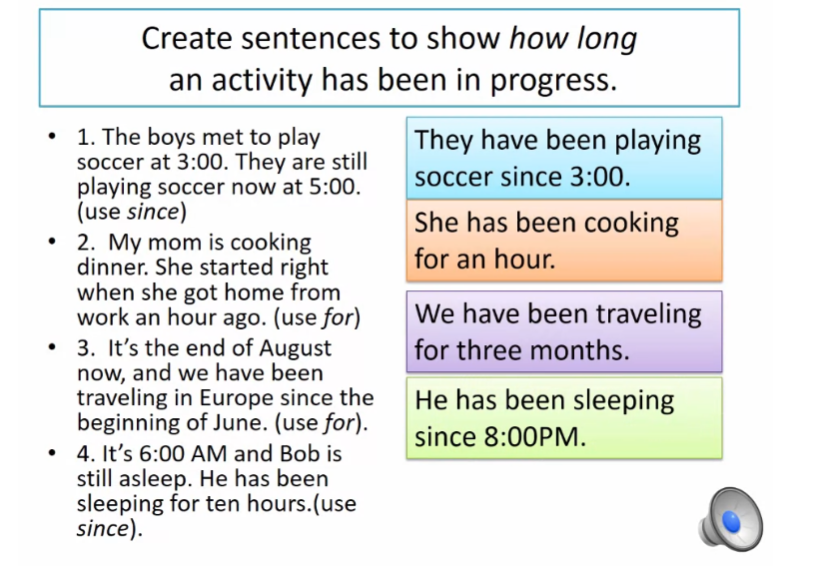
Practice Quiz on Present Perfect Progressive
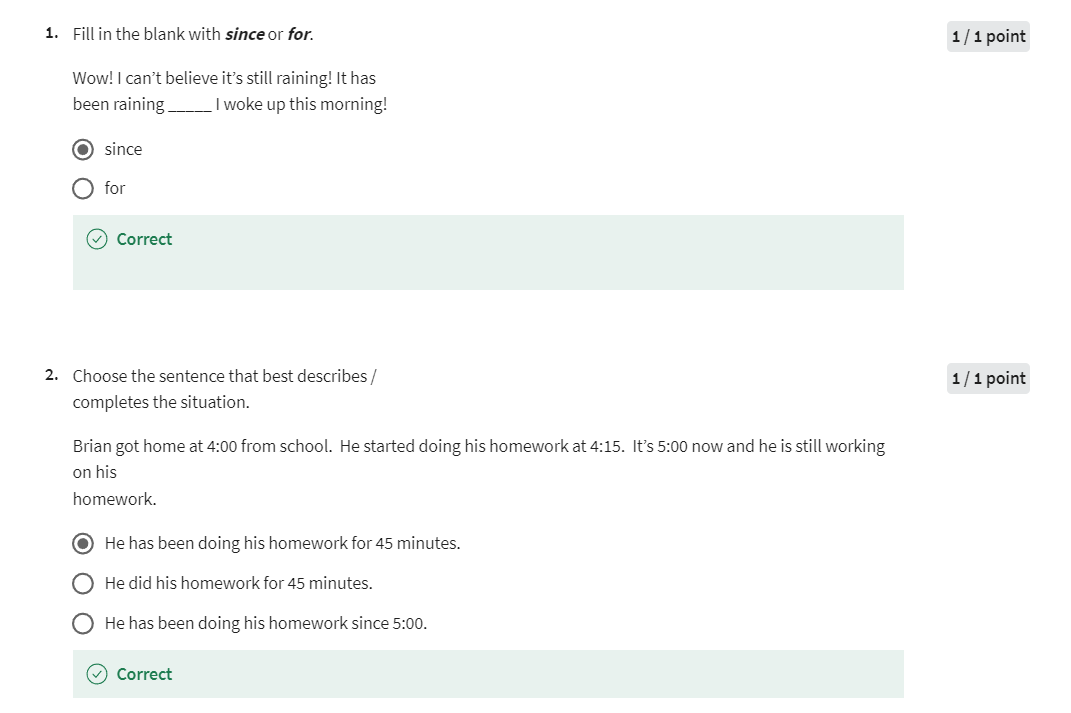
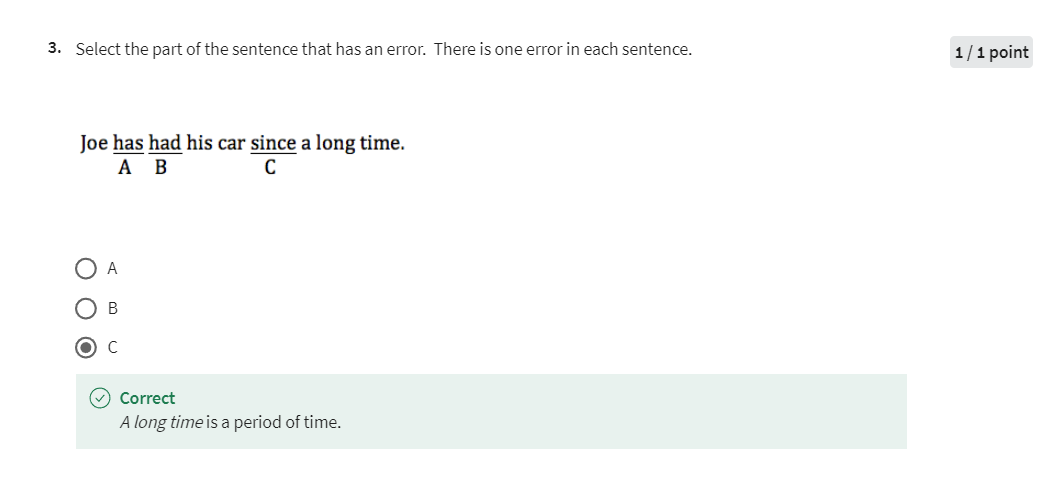
Stative Verbs Practice 2
Practice
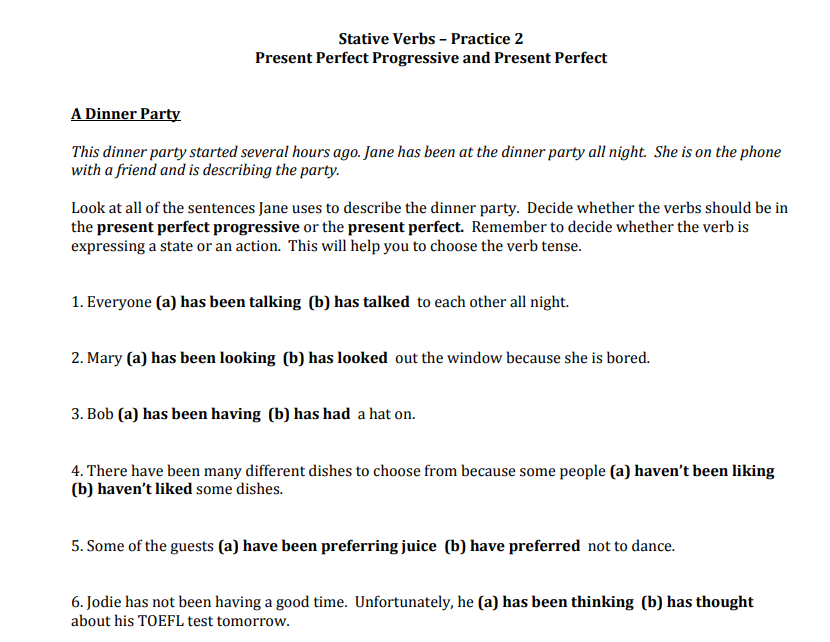
Answer
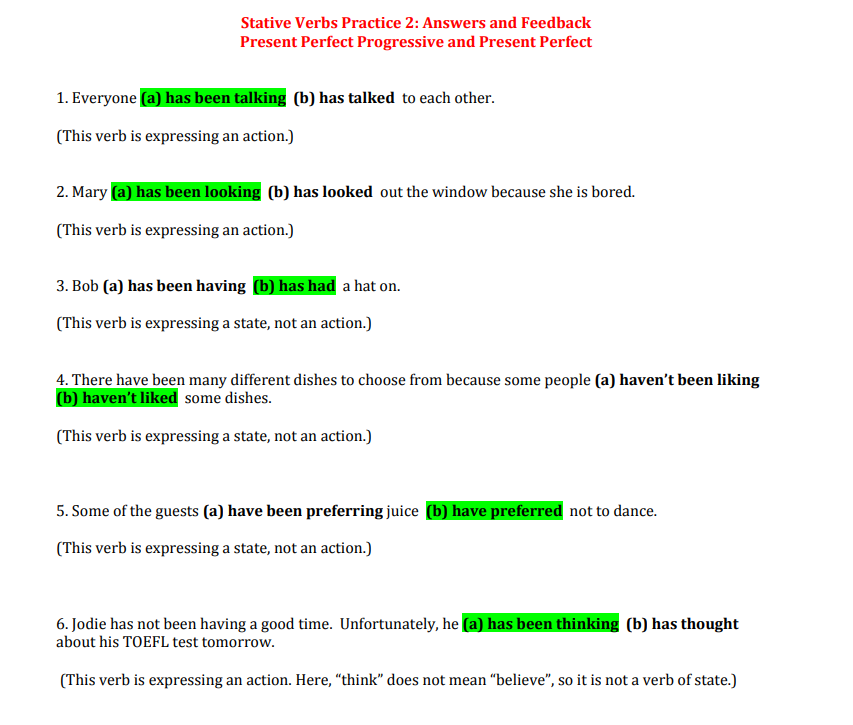
Present Perfect Progressive Questions Lecture
Question and short answer forms part two,
the present perfect progressive tense. >> Hey, hey, Maria. I just met a really awesome girl in
the elevator, but I didn’t catch her name. >> Really? What did she look like? >> Well,
she had dark hair with big blue eyes. >> I know who you’re talking about. That’s Jackie. >> Has she been working here for
a long time? >> No, she hasn’t. She’s been working here for
less than a year. >> Which department has
she been working for? >> Advertising. She’s been working on lots of project
with really big name companies. >> Really?
Who has she been working with? >> Belizon and Amajon. She’s really good at what she does. >> Wow! She’s so cool. >> Do you think Linus is
interested in Jackie? He is asking Maria many questions
about the job that she has. First she asked,
has she been working here for a long time? To form yes,
no questions like this in the present perfect progressive tense, use have or has plus the subject then been then
the ing form of the main verb. Maria’s short answer to Linus’s
question was no, she hasn’t. But, what would be the positive response? Yes, it would be yes, she has.
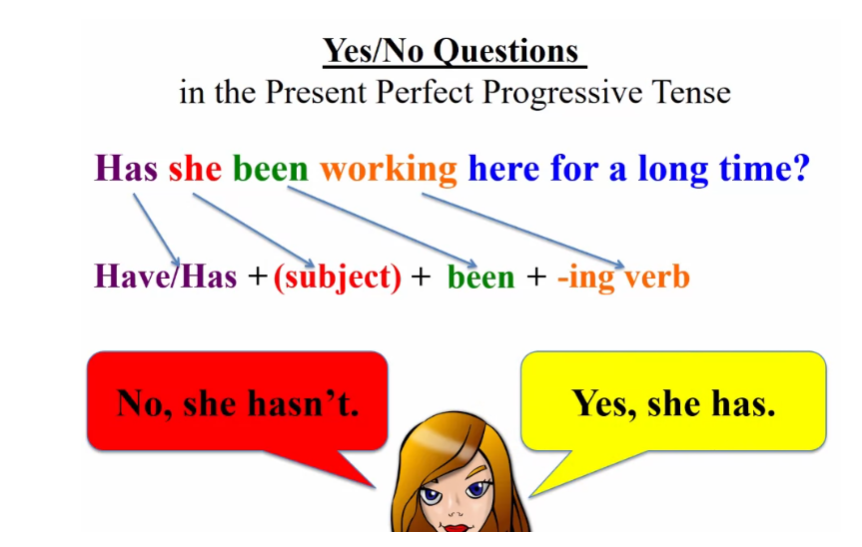
If you want to use a W-H word added
to the beginning of the question, keeping the same word order as the yes
no question form, has she been working? Will turn into,
which department has she been working for? Or, who has she been working with? Great job. Make sure to watch the next video, and find out what else Linus
learns about Jackie. Until then, bye.
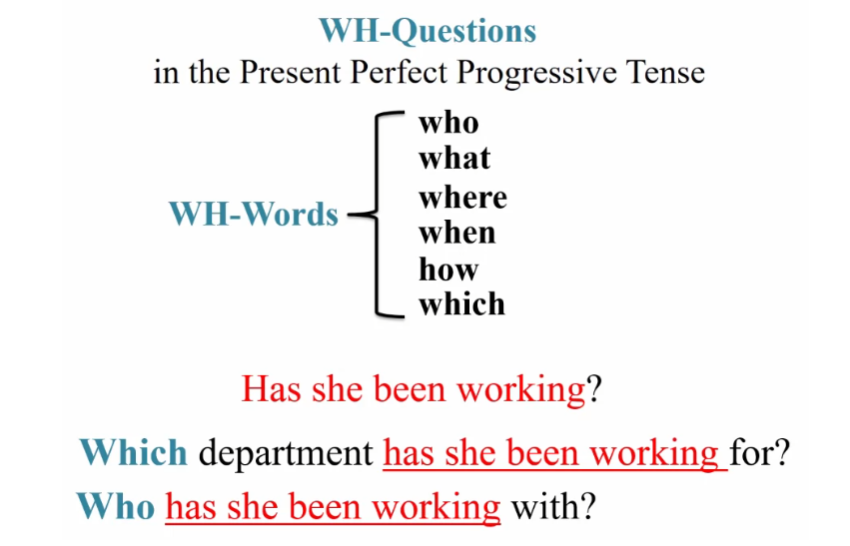
Practice Quiz on Present Perfect Progressive Questions
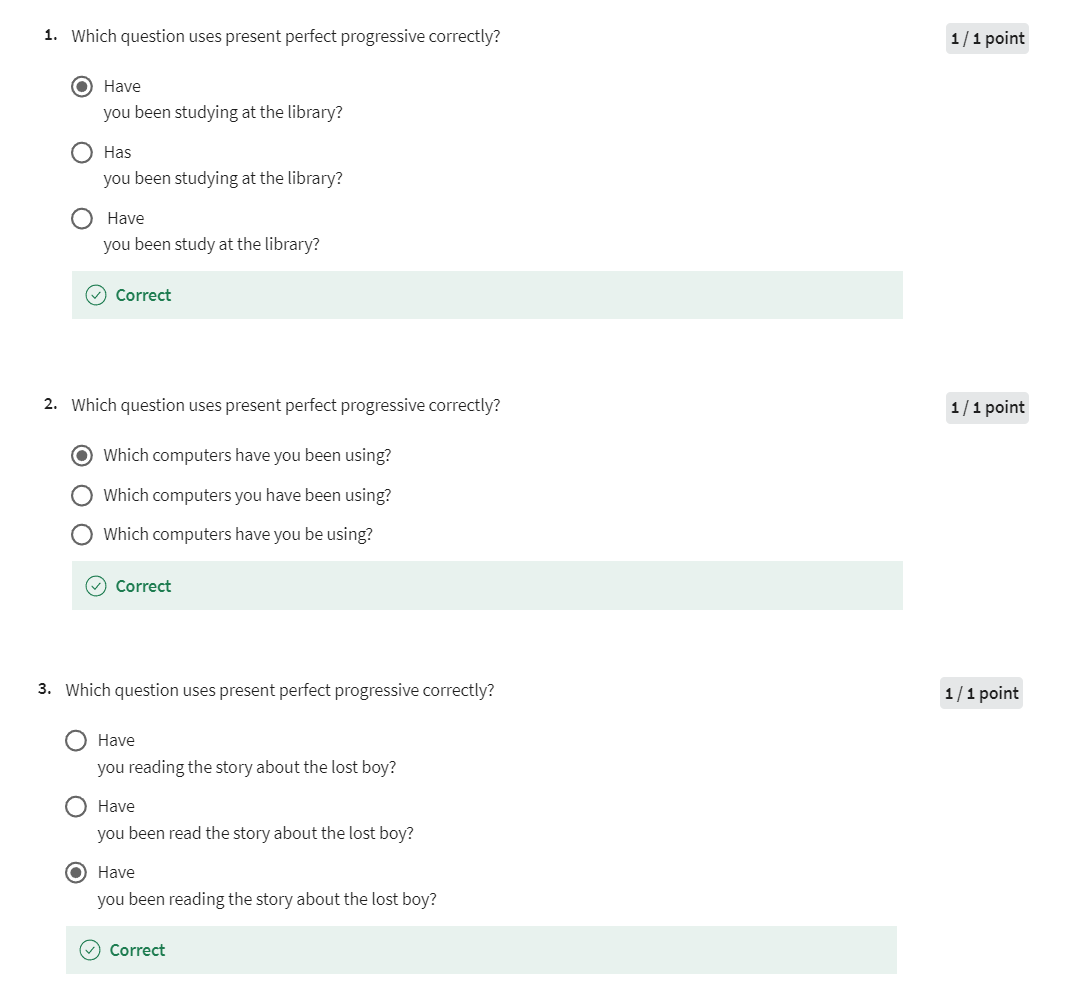
Present Perfect vs. Present Perfect Progressive Lecture
Now, you’re going to learn about the similarities and differences between the present perfect and present perfect progressive tenses.
After you watch the following video lecture, you will be able to:
- explain 3 similarities between present perfect and present perfect progressive tenses
- explain 4 differences between present perfect and present perfect progressive tenses
- use present perfect and present perfect progressive correctly
- use another name for progressive tenses
Welcome to the lesson on The Present
Perfect vs Present Perfect Continuous. In this lesson we will
discuss the similarities and differences between the present perfect
with the present perfect continuous tense. For example, when you meet somebody new, you often talk about yourself and
your life. For example, my family has been
living in California for 10 years. I’ve been working in
an engineering firm for 5 years. My son has been studying
medicine at university. My daughter has been studying law. All of these sentences use
the present perfect continuous. Some textbooks call the present
continuous text progressive, but it means the same thing.

Let’s look at a couple of more
examples of the present perfect and present perfect continuous tense. I have studied English for 5 years. I have been studying English for 5 years. So, what is the difference? Before we talk about the differences,
let’s talk about the similarities. First, each starts in the past and
has some importance in the present time. Second, each uses for and since. Third, each uses habitual actions
with verbs like work, live, study, play, wear glasses and
other similar verbs.
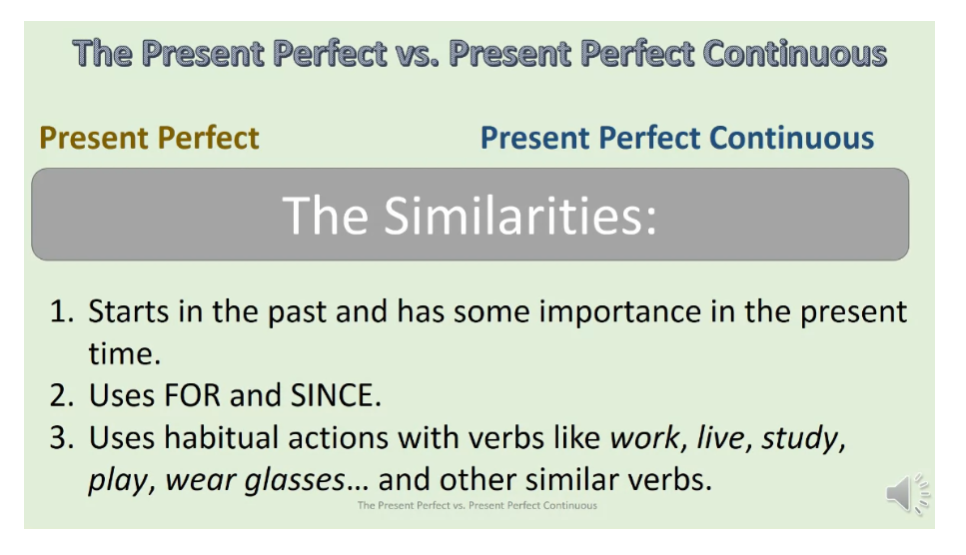
First, each starts in the past and
has some importance in the present time. For example, He has wanted to go to
New York since he was 10 years old. They have studied engineering for 3 years. The water has been boiling for 10 minutes. I have been studying for
this test since 7:00 this morning.
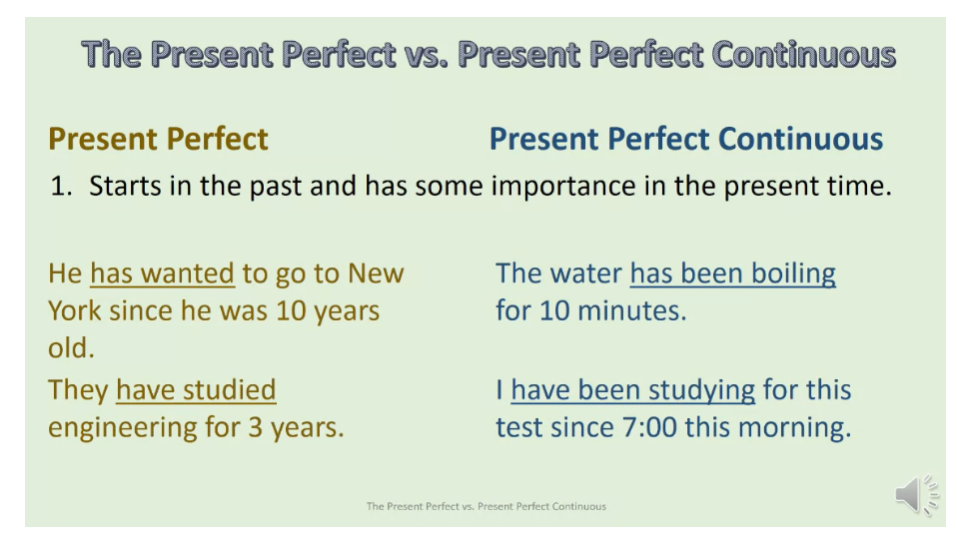
Next, each uses for and since. He has wanted to go to New York
since he was 10 years old. They have studied engineering for 3 years. The water has been boiling for 10 minutes. I have been studying for
this test since 7:00 this morning. Next, each uses habitual actions with
verbs like work, live, study, play, wear glasses and other similar verbs. With habitual action, there is no
difference in meaning between the present perfect and
present perfect continuous tenses. For example, He has lived in
California for five years, and, He has been living in California for
5 years, have the same meaning. They have studied engineering for 3 years, They have been studying engineering for
3 years, have the same meaning.
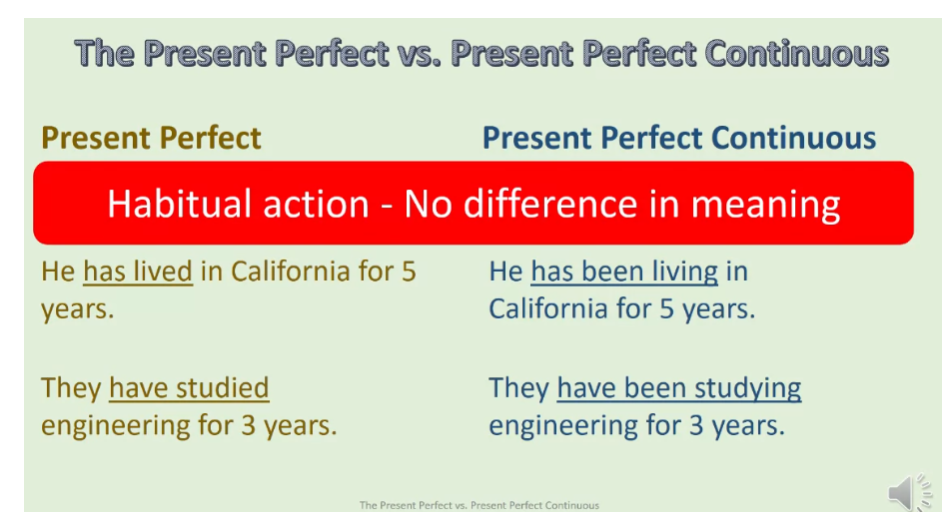
Now let’s look at the differences
between present perfect and present perfect continuous. For present perfect, first, the emphasis
is on the result of an action. Meaning, the action is completed. Second, it’s used with non-action verbs
that can’t use the continuous ing ending. Third, it’s often used with “ever” and
“never”, and it’s used with “how often” questions. Present perfect continuous
is used to put the emphasis on the ongoing action meaning. It’s not completed yet. Second, it’s used with
“how long” questions. Next, the emphasis is on
the duration of time for an action whether it’s finished or
unfinished. Lastly, when the action is finished but
you can still see the results, we use present perfect continuance.
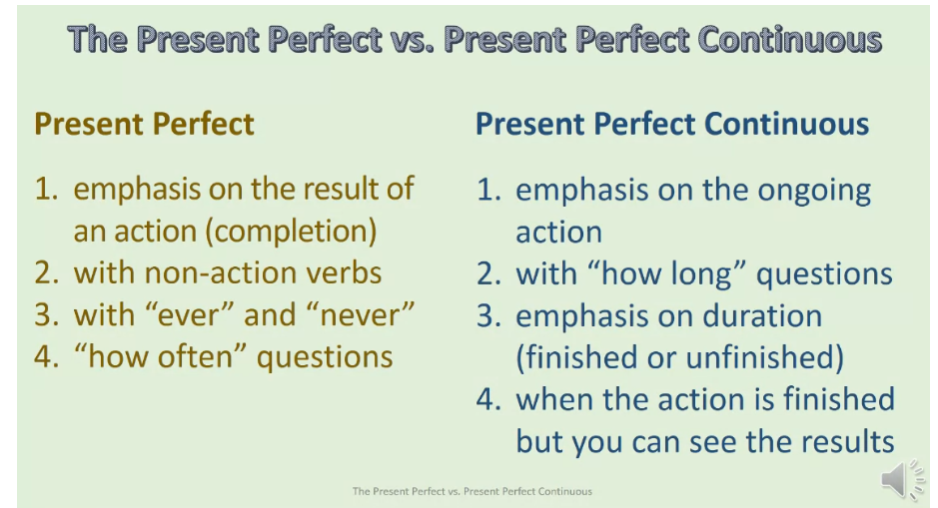
Let’s look at the two differences
between the present perfect and present perfect continuous tenses. First, present perfect emphasizes
the result of an action, the completion of the action. For example,
I have worked on my homework for 2 hours, means, I have finished my homework
after working for 2 hours. With present perfect continuous tense
the emphasis is on the ongoing action. So the example, I have been working
on my homework for 2 hours, means, I have not finished it yet. I’m still working on my
homework after 2 hours.
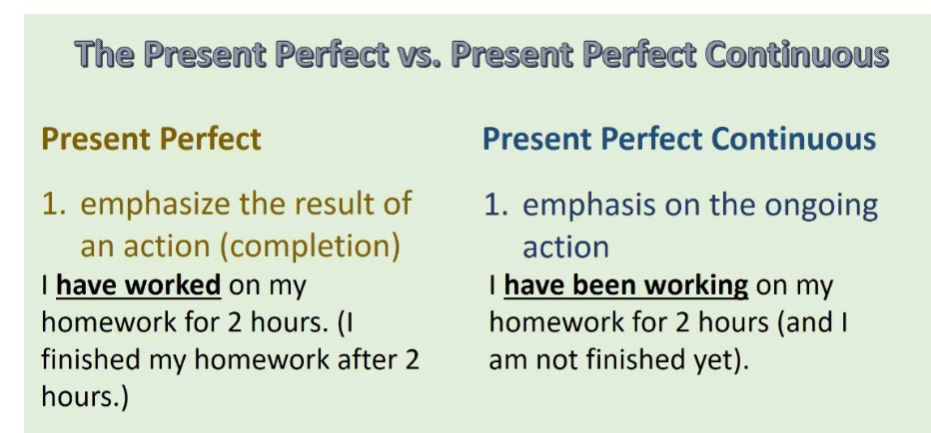
Second, present perfect is
used with non-action verbs. Non-action verbs are verbs that describe
states, senses or mental activities. For example, have, be, feel, hear, smell, taste, believe,
think, know, understand. These verbs cannot use ing at the end. For example, I have had 10 cellphones. I have been a lawyer for 2 years. I have heard this story before. You haven’t tasted this before. We have thought about it before. She has known them for years.
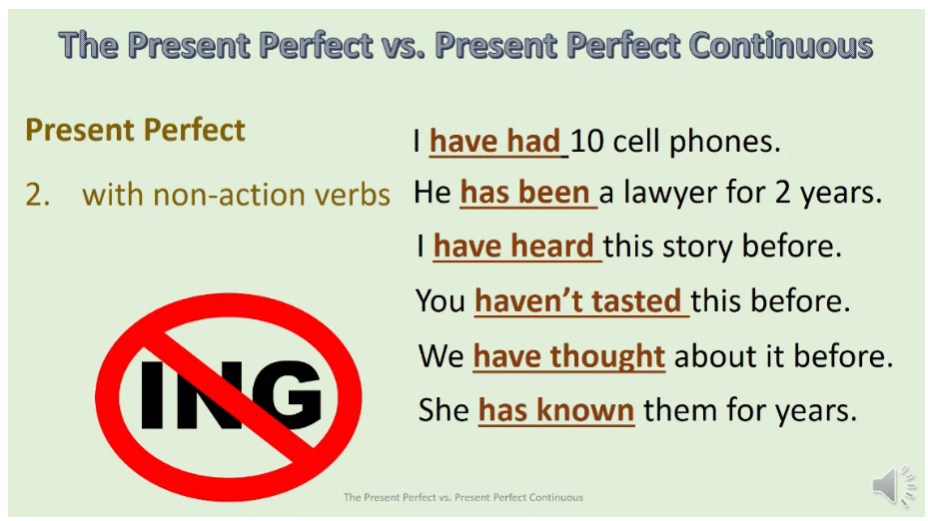
The present perfect is also
used with “ever” and “never”. For example,
Have you ever visited Las Vegas? No, I have never visited Las Vegas. Has he ever failed a class? No, he has never failed a class. The present perfect is also used
with “how often” questions. For example,
How often have you been to San Francisco? I have been there 6 times. How often has she called you? She has called many times.
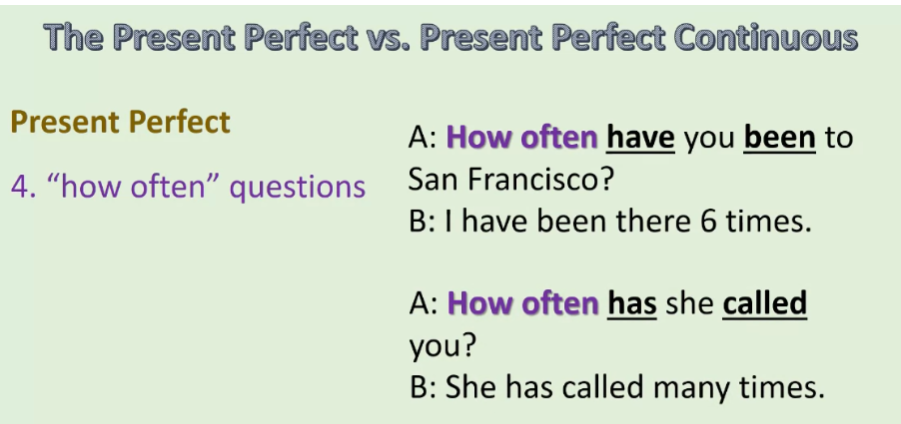
Present perfect continuous tense
is used with “how long” questions. For example,
How long have you been living here? How long has he been studying medicine? How long have they been dating?
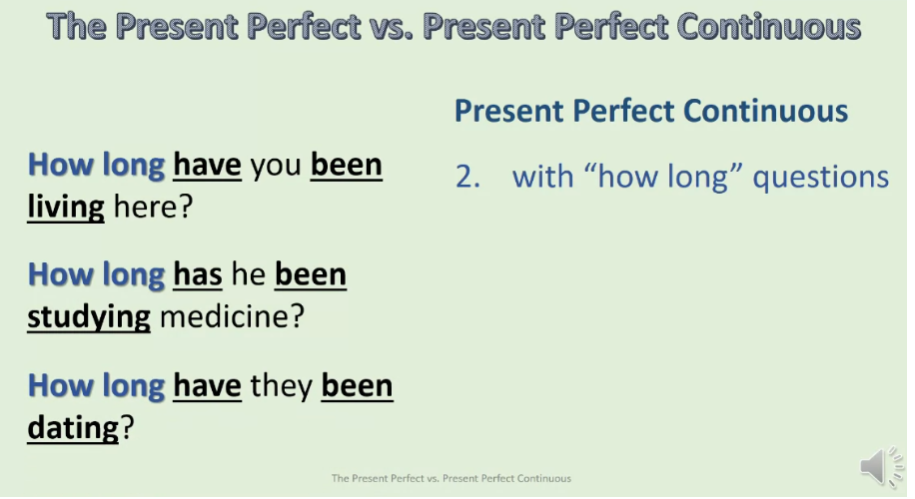
Also, present perfect continuous tense is
used to show emphasis on duration of time, whether the action is finished or
unfinished. For example, in the questions,
how long, the answers, I have been living here for 10 years,
puts the emphasis on the, for 10 years. He has been studying medicine since 2005. The emphasis is on, since 2005. They have been dating since March,
emphasis is on, since March.
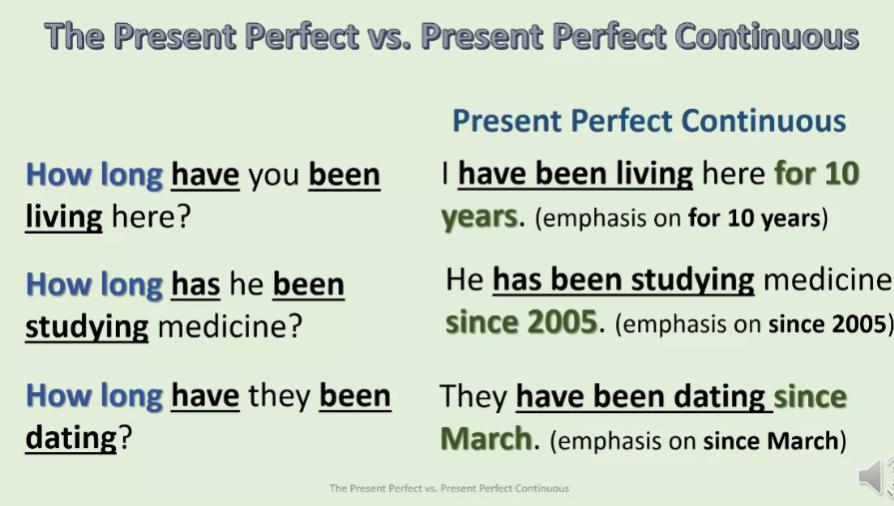
Lastly, present perfect continuous is
used when the action is finished but you can still see the results. For example, you are soaking wet. I have been walking in the rain
because I forgot my umbrella. You are soaking wet, means,
I can still see the results of the action, even though you’re not
currently walking in the rain. You look angry. Have you been fighting
with your boyfriend again? Because you look angry, I can see the results of your action
of fighting with your boyfriend. In this lesson,
we discussed the similarities and differences between the present perfect
with the present perfect continuous tense.
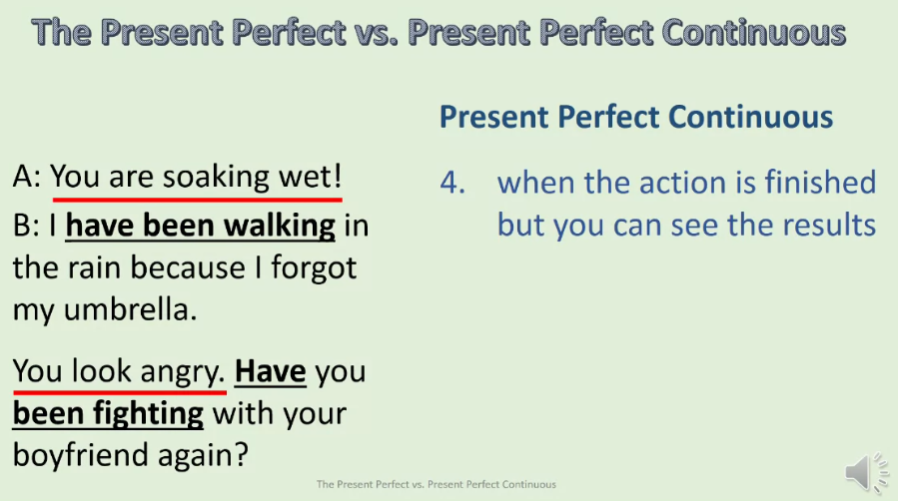
Practice Quiz on Present Perfect vs. Present Perfect Progressive
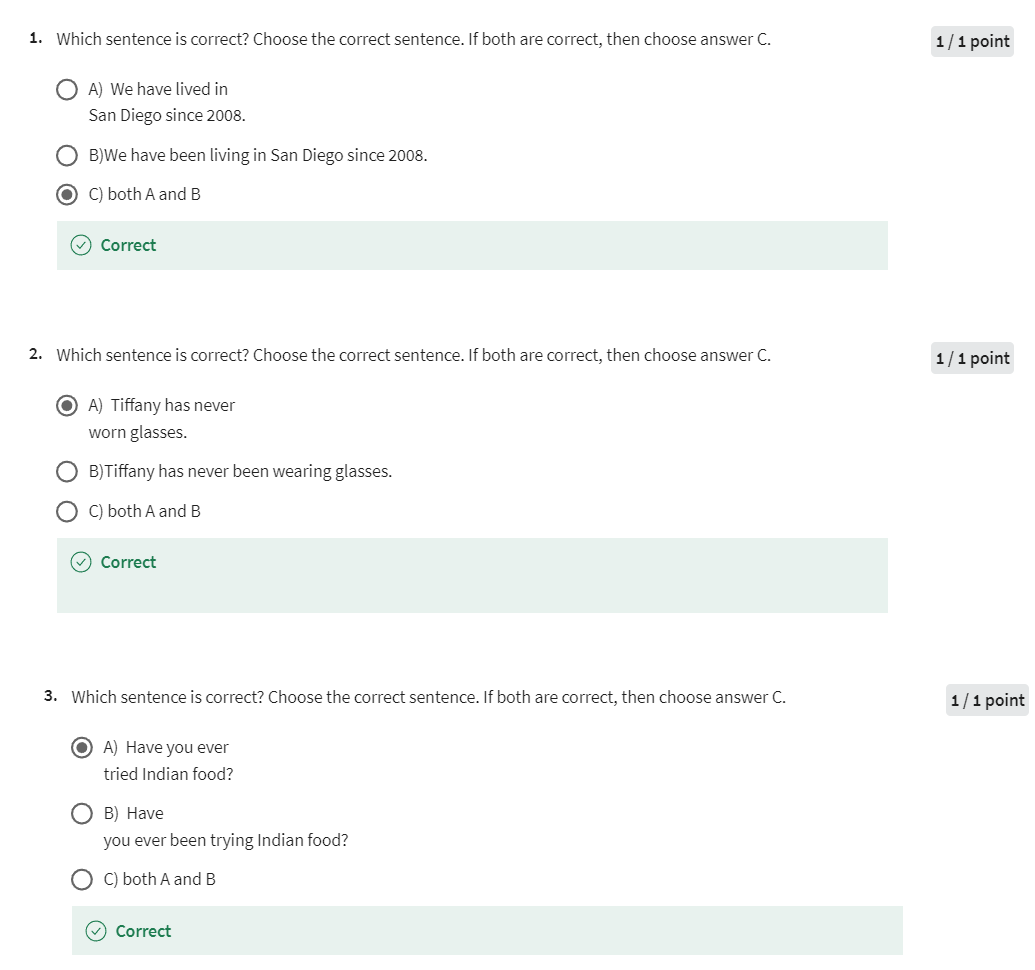
Graded Assignment: Present Perfect Progressive Assignment
Think of a situation that has been going on for a period of time, maybe for one hour or all day. Then write a dialogue between the people in this situation. Use lots of present perfect progressive verbs. Practice using affirmative and negative statements, as well as questions and answers. Write at least 5 present perfect progressive verbs.
For example:
Lucy is walking her dog, Felix, at the park. Felix has been causing a lot of problems for her. Then she meets her friend, Rebecca.
Lucy: Felix, has been running fast and pulling on his leash.
Rebecca: Oh! You must feel very tired.
Lucy: I am tired. He has been dragging me all over the park! I’ve haven’t been able to rest.
Rebecca: Has he been barking at the other dogs?
Lucy: Yes, he has. He has been barking all day.
Rebecca: What else have you been doing today?
Lucy: I have been thinking about my homework assignment while we’ve been walking. I don’t know what I am going to write my essay about.
Rebecca: I think you should write about your walk with Felix!
Lucy: That’s a good idea. I guess you can say that Felix has been helping me with my homework.
Rebecca: Ha! Ha!
My Try:
David and Sarah are stuck in traffic on their way to a concert. They have been sitting in the car for over an hour.
David: This traffic is insane! We have been crawling along at a snail’s pace for ages.
Sarah: I know, it’s frustrating. We’ve been listening to the same song on the radio for what feels like forever.
David: And we haven’t even reached the venue yet! I’ve been checking the GPS, but it keeps rerouting us because of the traffic.
Sarah: Have you been thinking about what we should do if we miss the opening act?
David: Yeah, I’ve been worrying about that. We’ve been looking forward to this concert for weeks.
Sarah: I’ve been hoping we’ll make it in time, but it’s not looking good. Have you been considering calling the venue to see if they’ll hold the show for us?
David: I haven’t thought about that yet. But it might be worth a try if we don’t get moving soon.
Sarah: I’ve been texting our friends to let them know we might be late. They’ve been waiting for us to arrive before going in.
David: Hopefully, they’ll understand the situation. I’ve been feeling bad about keeping everyone waiting.
Sarah: Me too. But there’s nothing we can do about the traffic. We’ve been stuck in this mess, and all we can do is wait it out.
Graded Quiz:Present Perfect Progressive Quiz

第三题粗心,应该选has been working

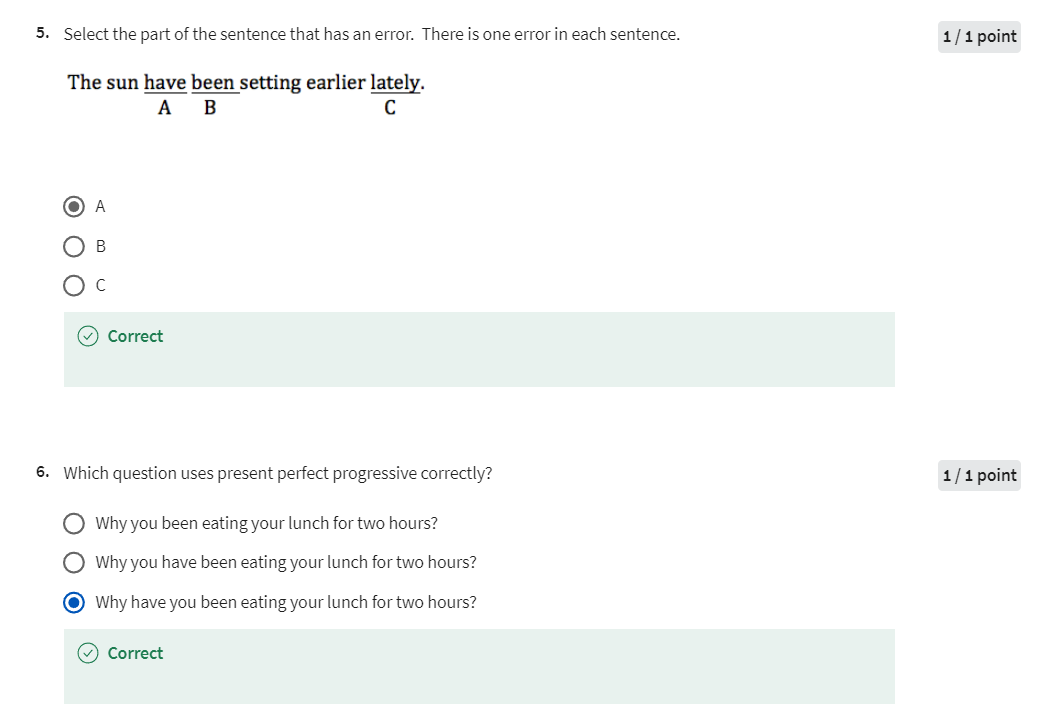
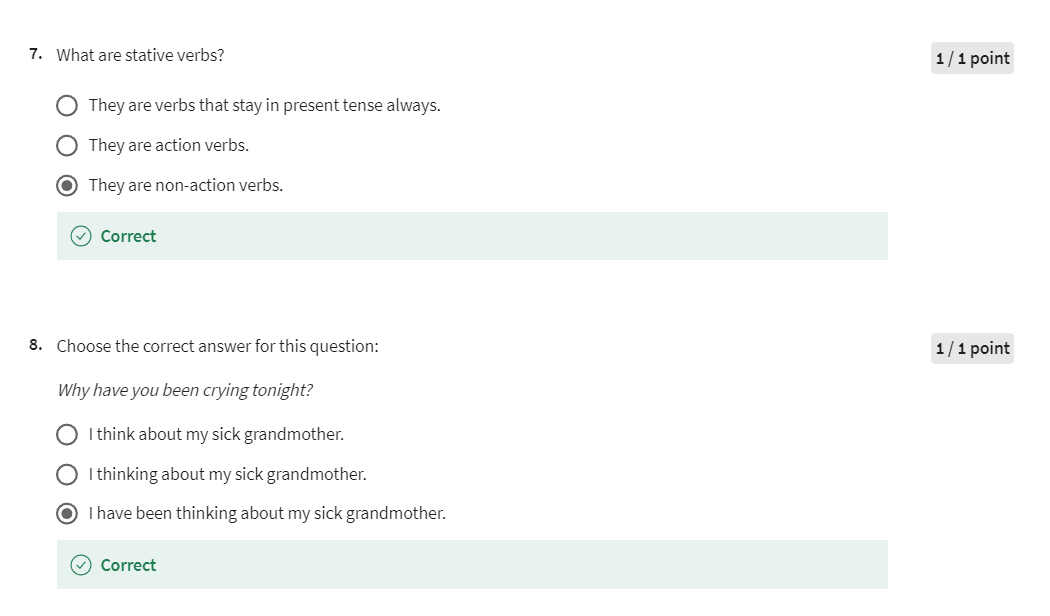
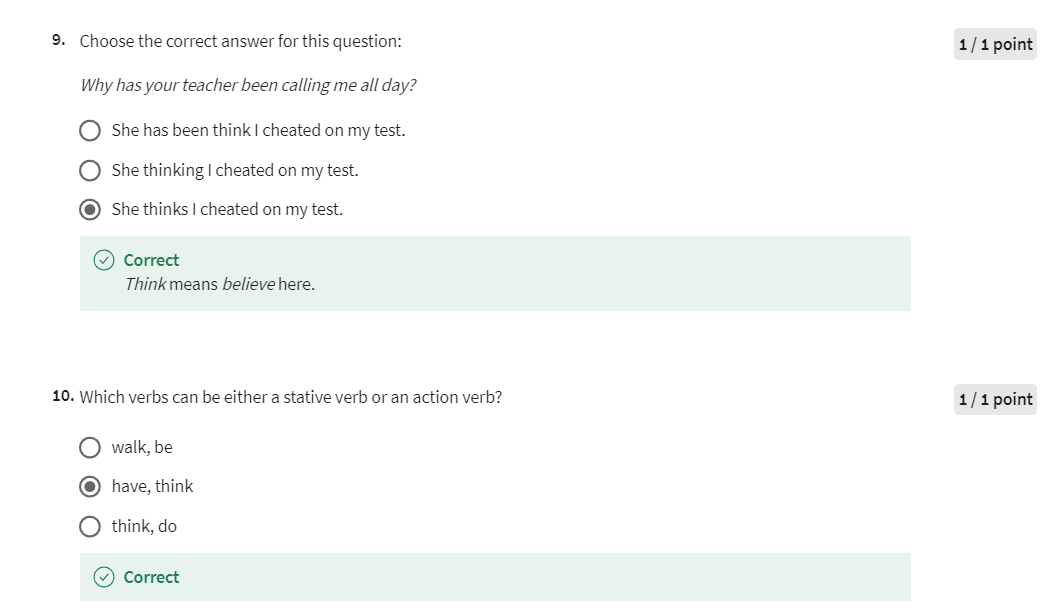
Week 03: Past Perfect and Past Perfect Progressive
This week, you’ll learn what the past perfect is and when to use it. You’ll practice using the correct form, and you’ll also learn the difference between present perfect and past perfect.
Learning Objectives
- explain the meaning of the past perfect tense
- use the past perfect tense correctly
Past Perfect Lecture
Hi, I’m Larry. This is my friend Judy. >> Hi, Larry and
I have a lot of fun together. Yesterday we watched a movie,
the newest remake of Cinderella. >> Actually,
we only saw the second half of the movie. The movie started at 7:00. We arrived at 7:45. We were really late. >> Sorry about that, buddy. That was totally my fault,
but we’ll get to that later. For now, can you complete this sentence? When we arrived, the movie started. Or when we arrived, the movie had started. If you say a, started,
the movie started after we arrived. Maybe we arrived at 7:00, and
the movie started at 7:45. We were not late at all. In fact, we were quite early. But, that’s not true. We were late. The answer is b, had started.
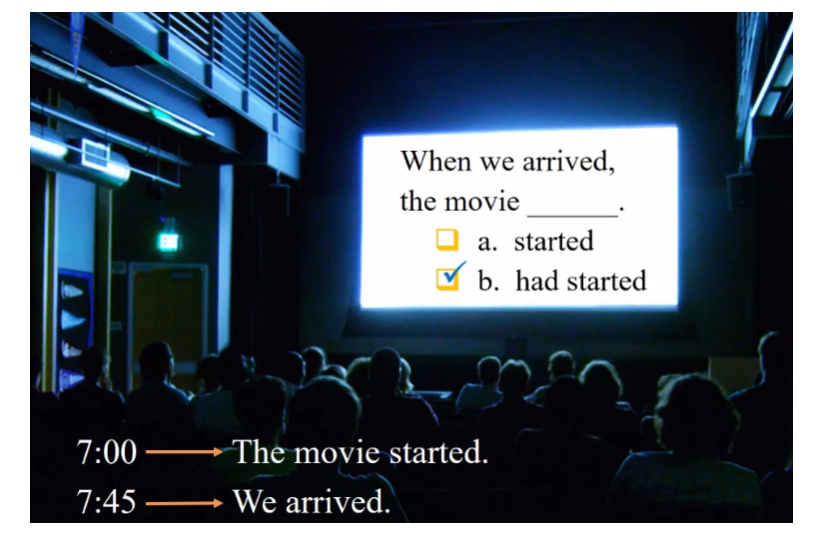
Do you know what verb tense this is? This is the past perfect tense. What are the two parts? Here’s a hint. Look at our sample sentence again. When we arrived, the movie had started. The past perfect tense is formed with the
helping verb had plus the past participle of the main verb. In this case, it is had started. Notice the had is often pronounced hood,
hood started. The past perfect means
that this happened first. The movie started first,
and then we arrived. We use the past perfect to clearly
show that once past event happened before another past event. It’s like the past before the past. It is possible to change the clause order. The movie had started when we arrived. The sentence looks different,
but the time order, the movie started first,
we arrived later, is the same.
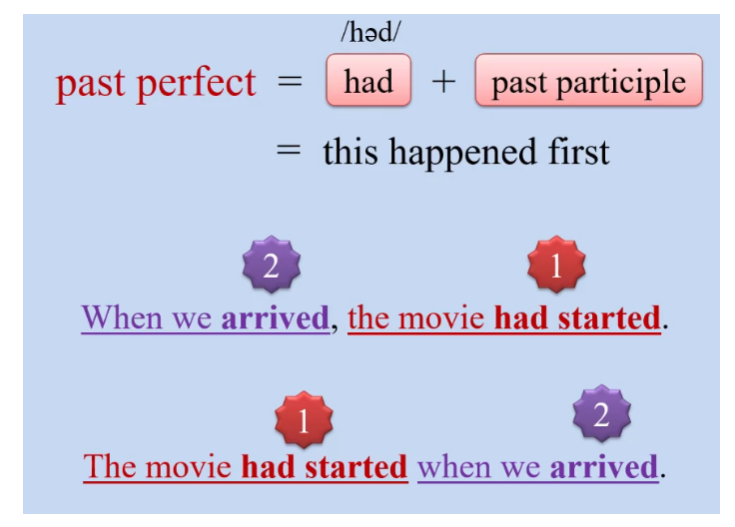
To make the negative,
we can add not after had. For example,
the movie hadn’t ended when we arrived. We missed the first half of the movie,
but I still enjoyed the second half. When the time order is clear, it is usually wrong to use
the past perfect tense. It would be confusing if we told all
of our stories in the past perfect. For example,
we had watched a movie yesterday. We had been late to the theater,
but I had enjoyed the movie. Instead, we simply use
the past simple tense. We watched a movie yesterday. We were late to the theater,
but I enjoyed the movie anyway.
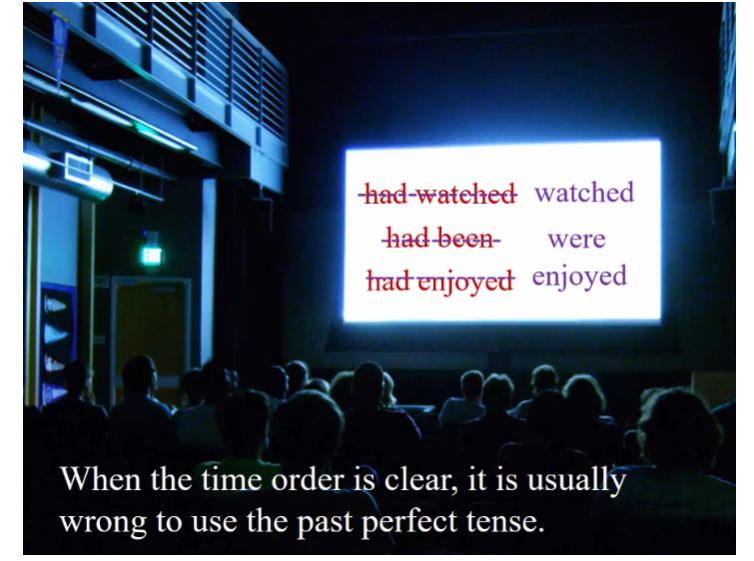
A common exception to this rule is,
by the time, a phrase that pretty much means before. When we use this phrase,
the time order is clear, but we almost always use the past perfect. For example, by the time we got
here all of the seats had filled. Larry and I had to stand in the back
of the theater to watch the movie. Notice by the time can be specified,
for example, 7:45. By 7:45, all seats had filled.
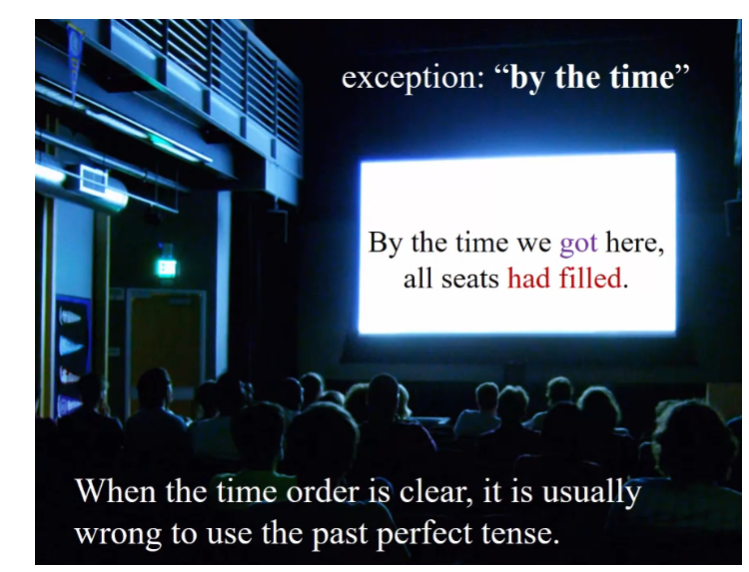
Let’s review,
the past perfect consists of two parts, had plus the past participle
of the main verb. It means that this happened first. Can you guess why Larry and
I were late yesterday? >> We were late to the theater because a,
she had left the movie tickets at home, and we had to drive back to get them. B, we had gotten lost while driving to
the theater from the restaurant where we had dinner. Or c. >> He had wanted to watch an action flick,
not a romance movie, so we were arguing about
which movie to watch. >> The answer is the first one of course. Judy had forgotten to bring the tickets. >> Yep, it was totally my fault. I’m such a scatterbrain. Next time, Larry, you hold the tickets,
and you pick the movie, any movie you want.
Past Perfect Practice
Practice
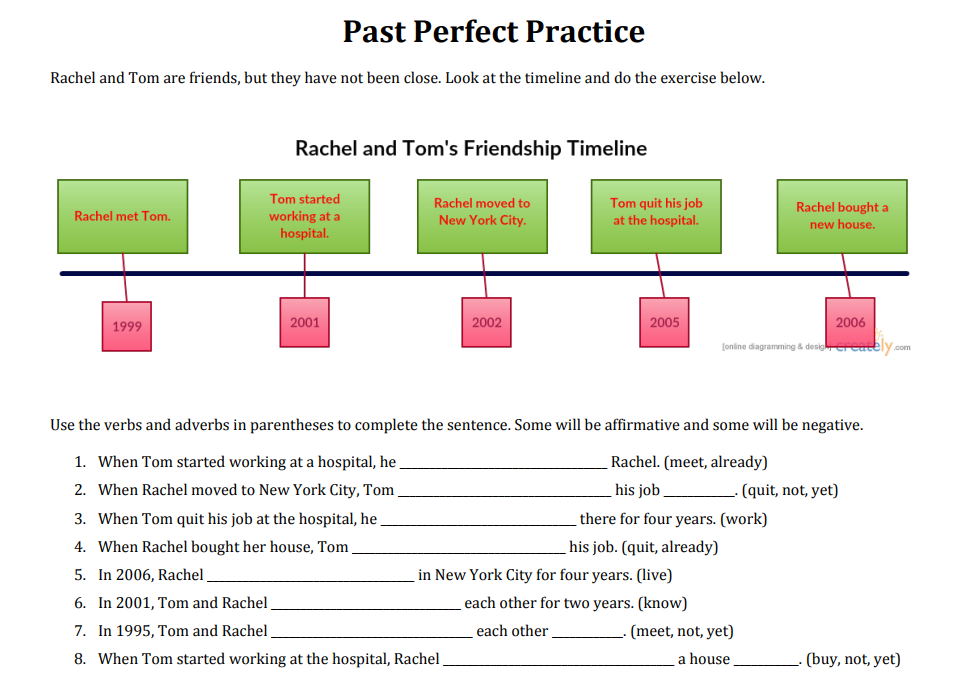
Answer

Practice Quiz on Past Perfect

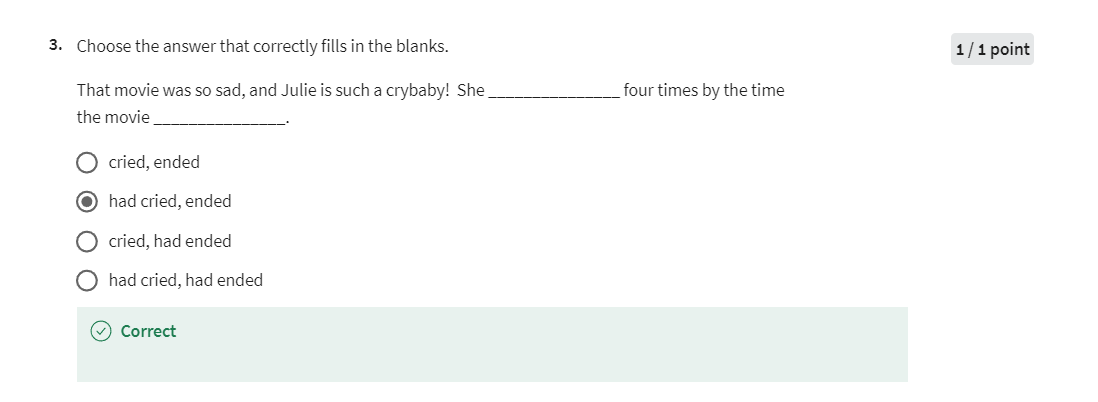
Past Perfect Questions Lecture
You’ve learned how to make statements in the past perfect tense. Now, you’ll learn about making questions with past perfect tense.
After you watch the following video lecture, you will be able to:
- form questions correctly using past perfect tense
- answer questions correctly using past perfect tense
Question and short answer forms part 3. The past perfect simple tense. Hm, are you interested in Jackie? >> Well, she just sounds really cool. It seems like she knows a lot. Before she started working here,
had she done other cool things? >> Yeah, she had done a homestay
with the Eskimos in Alaska. >> No way, why had she chosen
to do her homestay there? >> She had received a scholarship
to study about the Eskimo culture. >> How had she won the scholarship? >> Well, she had designed a new
machine that records whale sounds. [SOUND] Wow, I really have to ask her out.
It’s really amazing all
the things that Jackie has done. We’ve learned a lot about her, we know
that Jackie works in advertising now, but started working at
the company about a year ago. Before that she lived
with Eskimos in Alaska. That was possible because she
received a scholarship before that. And she was able to win that scholarship
because she had designed a special machine that records whale sounds. When we ask questions about past events
that happened before another past time, we often use the past perfect form. Like when Linus asked,
before she started working here, had she done other cool things? He asked this yes/no question to ask
about things she had done in the past before working at the company
which was a closer past time. How could you respond with a short
answer to a question like this? You would either say, yes,
she had or no, she hadn’t.
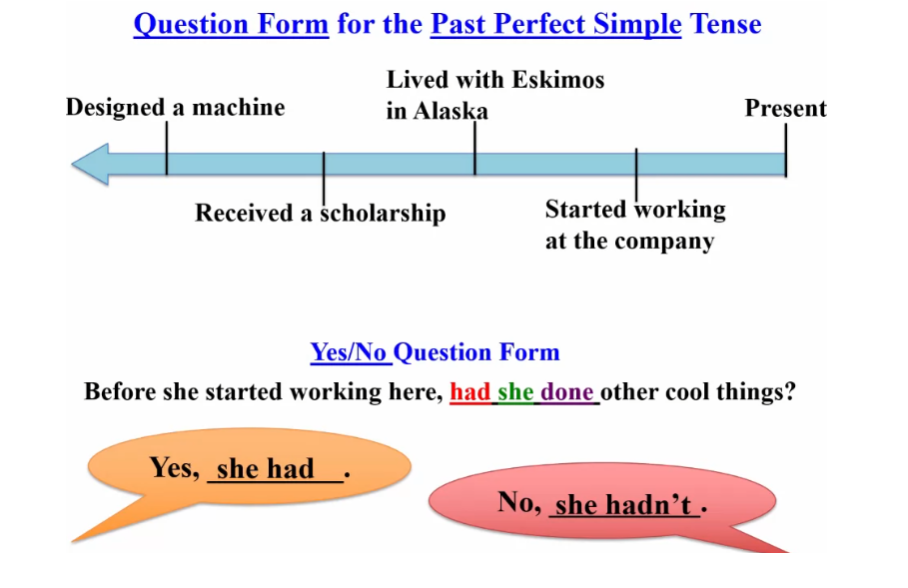
Great. As the conversation continued,
Linus wanted more detailed information, so he asked WH questions like, why had she
chosen to do her homestay in Alaska? He used the past perfect because he
was asking about the decision she made to go to Alaska which happened before
she started working at the company. Again, when Linus asked,
how had she won the scholarship, he used the past perfect form asking
about an even further time in the past. Did you notice the pattern in
question form for the past perfect? If you’re asking a WH question,
begin with the appropriate WH word, plus had, then the subject, and
then the past participle of the main verb. I hope you had a chance to watch
all 3 parts of the question and short answer forms for
the perfect tenses, thanks for watching.
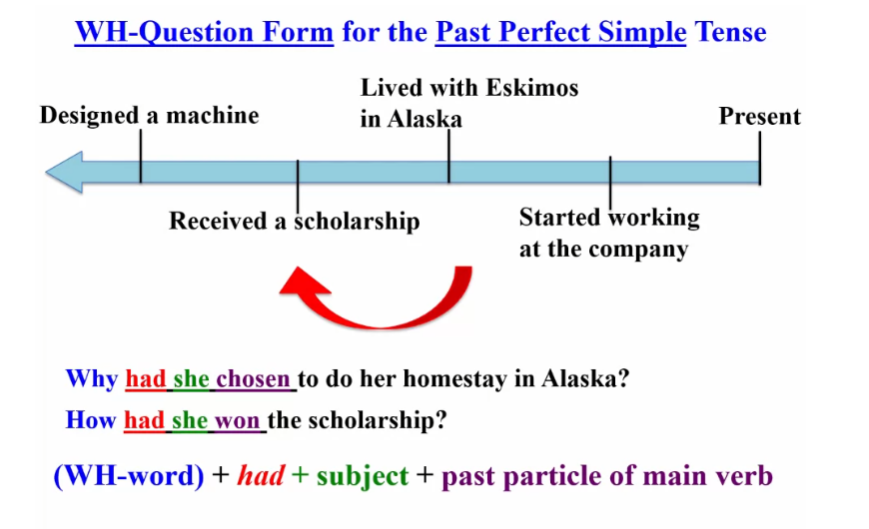
Practice Quiz on Past Perfect Questions
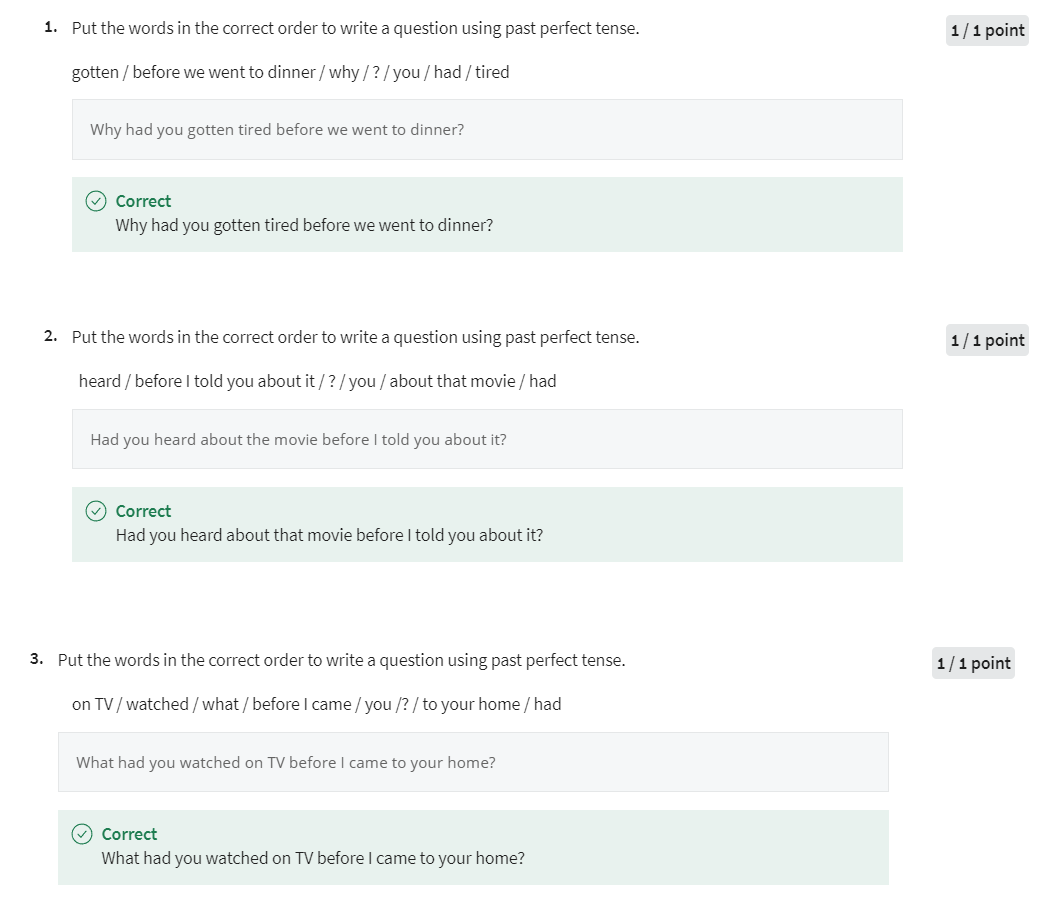
Past Perfect Questions Practice
Practice
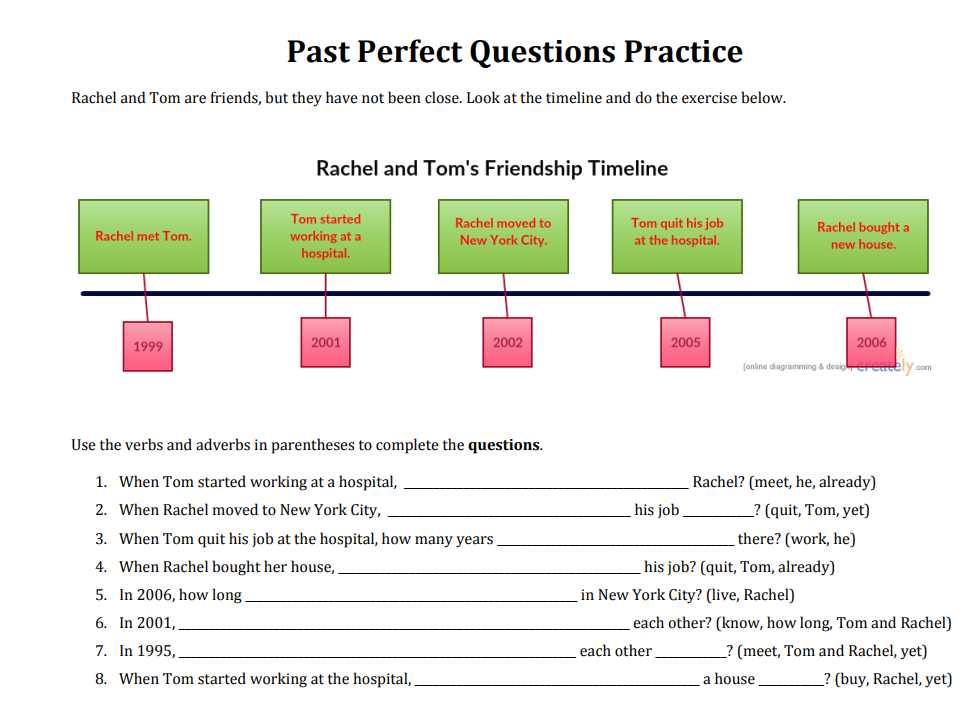
Answer
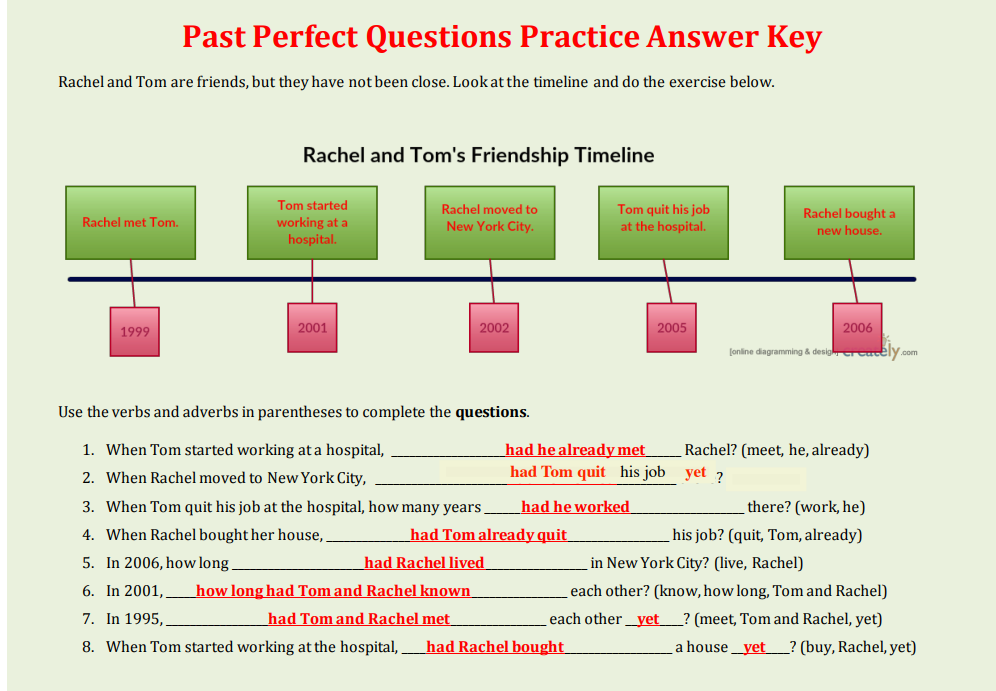
Graded Assignment: Past Perfect Assignment
Practice writing sentences using the past perfect tense. Write 5 statements or questions that require past perfect, and use it correctly. Be sure to number them.
For example:
- John had already eaten when Susan arrived with a pizza.
- Had you met my boss before, or was today the first time?
- Why had you gone shopping when you already had a dress to wear to the party?
- Our debate team had won several other competitions, so we were not surprised to win again.
- I had wanted to ride to the concert with you, so I tried calling you many times.
My Try:
- By the time we got to the cinema, the movie had already started.
- Had you finished your homework before you went out to play soccer?
- She realized she had left her keys at home when she reached the office.
- Why had the store closed early when it was supposed to be open until 9 PM?
- They had never visited Paris before they went on their honeymoon trip.
Past Perfect Progressive Lecture
Now, you are going to learn about the past perfect progressive tense. This is different from past perfect tense because progressive tenses emphasize an ongoing action.
After you watch this video lecture, you will be able to:
-
use past perfect progressive tense correctly
-
explain how past perfect progressive is similar to present perfect progressive tense
So, May,
did you pick up your car last night? >> [SOUND] The repair shop was
already closed when I got there. I have to go back tonight. Judy, I am so frustrated with Brendon. He was supposed to pick me up yesterday at
6 o’clock and drive me to the shop, but he totally forgot. By the time I called him,
I had been waiting for over an hour.
Lyn tells me that she had
been waiting for an hour. This verb phrase is in the past perfect
progressive, which has three main parts. Had, the optional not, been and then the I-N-G form of the main verb,
also called the present participle. Notice the had can be contracted,
shortened. She’d been waiting for an hour. The past perfect progressive is not
frequently used, but when we do use it, what does it mean? To understand, let’s revisit
the present perfect progressive.
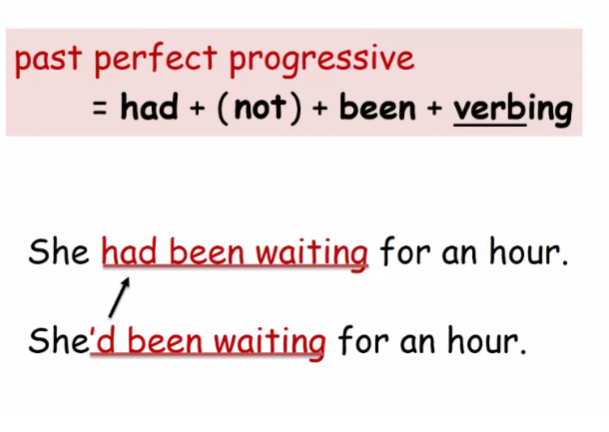
Here’s what happened last night. >> Where are you? The repair shop’s closed now. You were supposed to be here at 6,
and now it’s 7. I’ve been waiting here for an hour.
Meg tells her boyfriend Brendon,
that she has been waiting for an hour. This is the present
perfect progressive tense. You may remember that this verb
tense also has three main parts. The helping verbs has or
have, plus been, and then the present participle
of the main verb. It can have two meanings. When the time is specified or
implied using expressions such as for, since, or all day,
it is an unfinished action right now. Without expressions, such as for or since, sometimes called unspecified time,
this verb tends might suggest that an action was very
recently finished just before now.
In our example Meg started waiting at 6. It is past 7 now. She has been waiting for an hour. Brendon has not arrived, so
Meg must continue to wait. Here, waiting is an unfinished
action right now. She has been waiting since 6 o’clock,
and she is still waiting. Now let’s go back to our original example. The past perfect progressive looks the
same, except that has or have becomes had. It also has the same two meanings but instead of referring to now, it’s
referring to another time in the past. This morning,
when chatting with me in the office, Meg says that she started
waiting at 6 o’clock yesterday. By 7:00 PM, she had been waiting for
an hour, and was still waiting. Here, waiting is an unfinished
time in the past. Brendon realized his mistake
at 7:00 PM last night, but by then, Meg had already been
waiting since 6 o’clock.
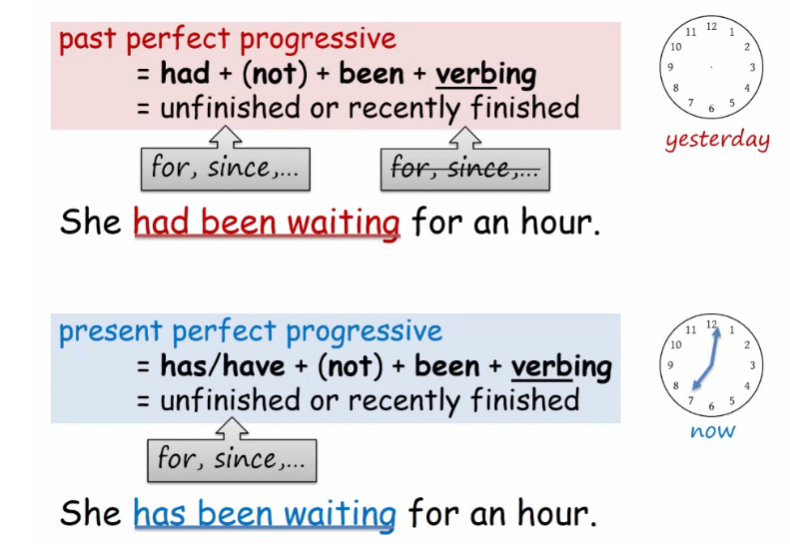
I’m so sorry I’m late. I know the repair shop is closed now. I promise, we’ll get your car tomorrow. >> [SOUND]
Meg is clearly angry. She has been feeling
angry since last night. This sentence is in the present
perfect progressive. How can we make the sentence in
the past perfect progressive? That’s right, she had been feeling angry. What might this mean? Was it unfinished time still happening, or
recently finished, no longer happening? Well, there’s no time expression
such as for or since, so perhaps this feeling ended very recently. Very recently can be a minute or
even a short second ago. Take for example,
the conclusion of this story. >> I’ve been feeling so angry. He’s the worst. [NOISE]
Flower delivery for Meg? >> For me? Thank you. >> You’re welcome. >> They’re so pretty. >> Where are they from? >> Sorry about last night, babe. I’ll pick you up tonight
at 6 o’clock sharp. Love, Brendon. >> Aw, I know that you had
been feeling angry lately. Not anymore, I guess? >> No, I’m not angry at all.
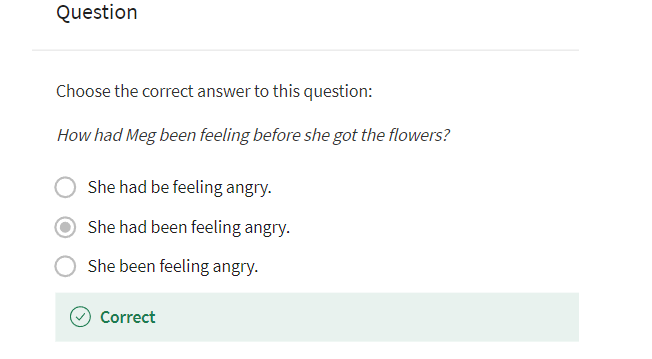
The Past Perfect Progressive tense, also known as the Past Perfect Continuous tense, is used to describe an action that began before a certain point in the past and continued up to that point or beyond it. It emphasizes the duration of the action leading up to the past moment being discussed.
In terms of structure, the Past Perfect Progressive tense is formed using the auxiliary verbs “had been” followed by the present participle of the main verb (the base verb + “-ing”).
Here’s the basic structure:
Subject + had been + present participle
For example:
- She had been studying for hours before the exam.
- They had been working on the project all morning.
- By the time I arrived, he had been waiting for over an hour.
The Past Perfect Progressive tense is often used to provide context or background information about a past event. It helps to show that an action was ongoing or in progress before another event took place. This tense is particularly useful when narrating stories or describing events that occurred in the past with a sense of continuity.
Practice Quiz on Past Perfect Progressive
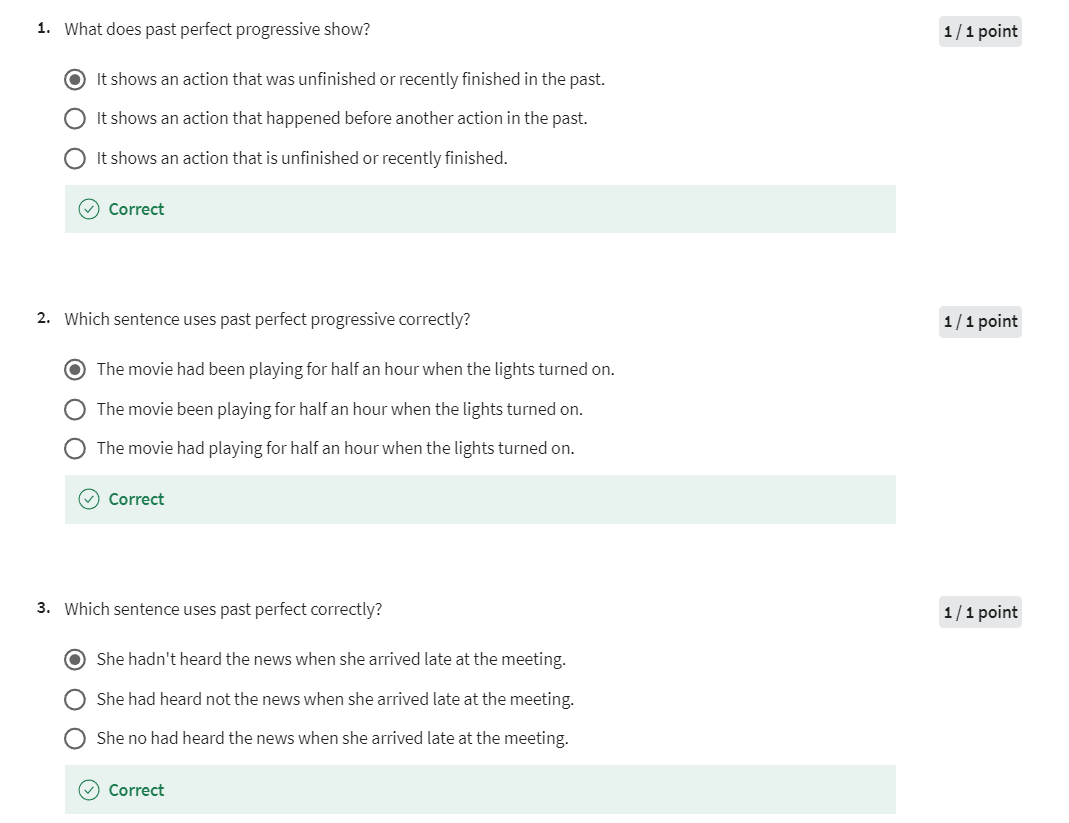
Past Perfect Progressive Questions Lecture
You’ve learned about making statements in the past perfect progressive tense. Now, you’re going to learn about making questions using this tense.
After you watch the following video lecture, you will be able to:
- form questions correctly using past perfect progressive
- answer questions correctly using past perfect progressive
Question and short answer forms part four. The past perfect progressive tense. >> I’m so stupid. >> What’s wrong? >> I had been waiting for that day for
so long, and I mess it up, Maria. >> What are you talking about? >> I finally met Linus in
the elevator the other day. I’d been planning for it for so long,
and I didn’t even tell him my name. >> Why had you been planning
to meet him in the elevator? >> I just wanted to talk to him. I noticed him a while ago and thought
he was cute, and he seemed different. >> I see. Well, how long had you
been trying to meet him? >> A little after I started working here,
so about five months. >> Wow, you must really like him. Did you know? [SOUND]
Linus. >> Hey. Hi again. You guys getting in the elevator? >> Go on without me, Jackie. I forgot something.
Let’s now look at the question form for
the past perfect progressive tense. We’ve learned from Maria and
Jackie’s talk that just a few days ago, Jackie met Linus for
the first time in the elevator. That obviously happened in the past. And further in the past, about five
months ago, was when Jackie saw Linus for the first time. So we can say before the meeting in
the elevator, Jackie had first seen Linus about five months ago using
the past perfect simple form had seen. Between these two past times Jackie
had been trying to meet Linus. We can say before
the meeting in the elevator, Jackie had been trying to meet Linus for
about five months.
Now let me ask you an easy yes,
no question. Before Jackie ment Linus for
the first time a few days ago, had she been thinking about him? You could answer yes she had,
or no she hadn’t. You are correct if your
answer is yes she had. Jackie liked Linus even
before she met him. So, she had definitely been
thinking a lot about him.
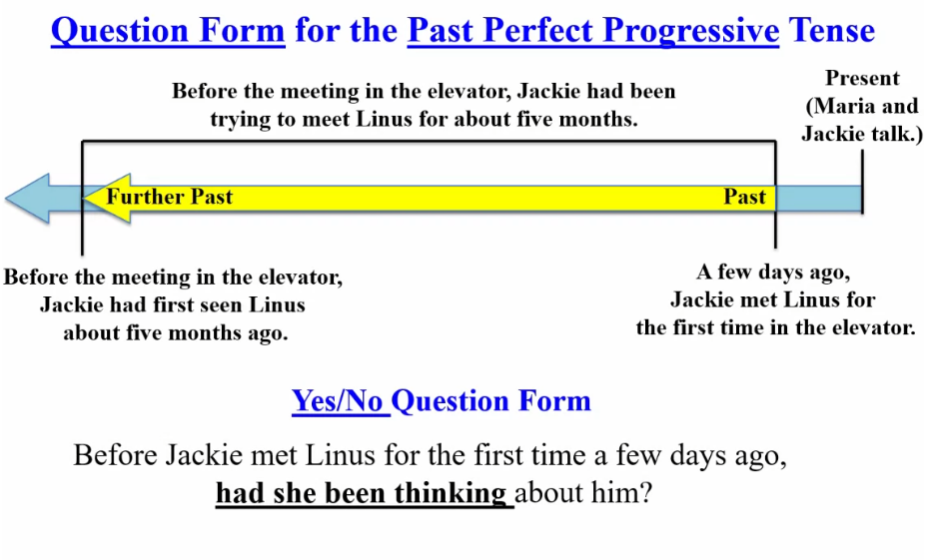
Now let’s look at the WH
questions Maria asked. Pay close attention to the pattern in the
grammatical structure of these sentences. Why had you been planning to
meet him in the elevator? How long had you been trying to meet him? In forming the WH-questions in
the past perfect progressive tense, notice that the WH-word
goes first followed by had, then the subject followed by been and then the -ing progressive
form of the main verb. Using this form shows than
action happened over time in the past before
a particular past action
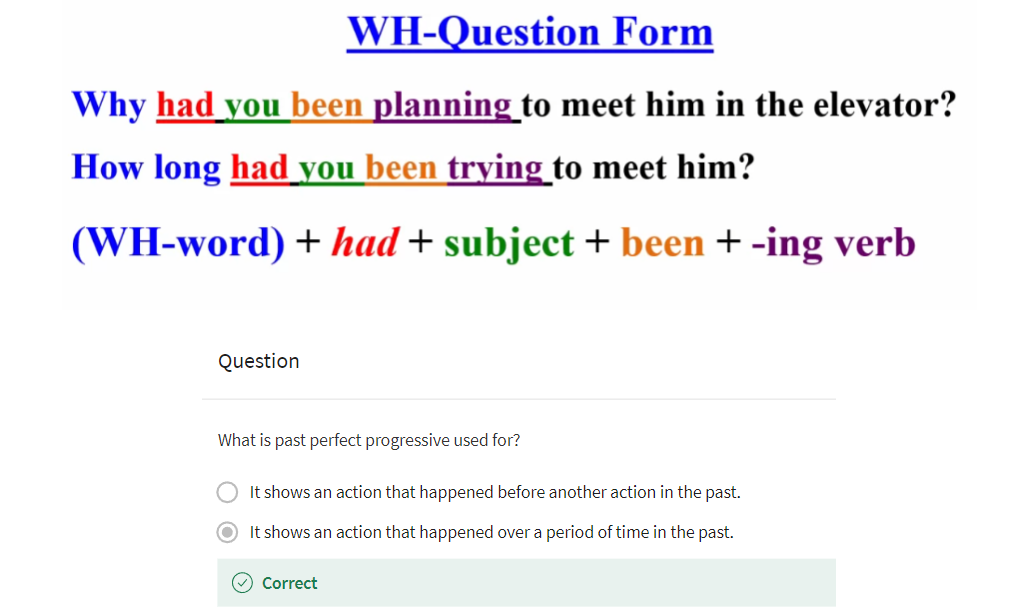
Past Perfect Progressive Practice
Practice
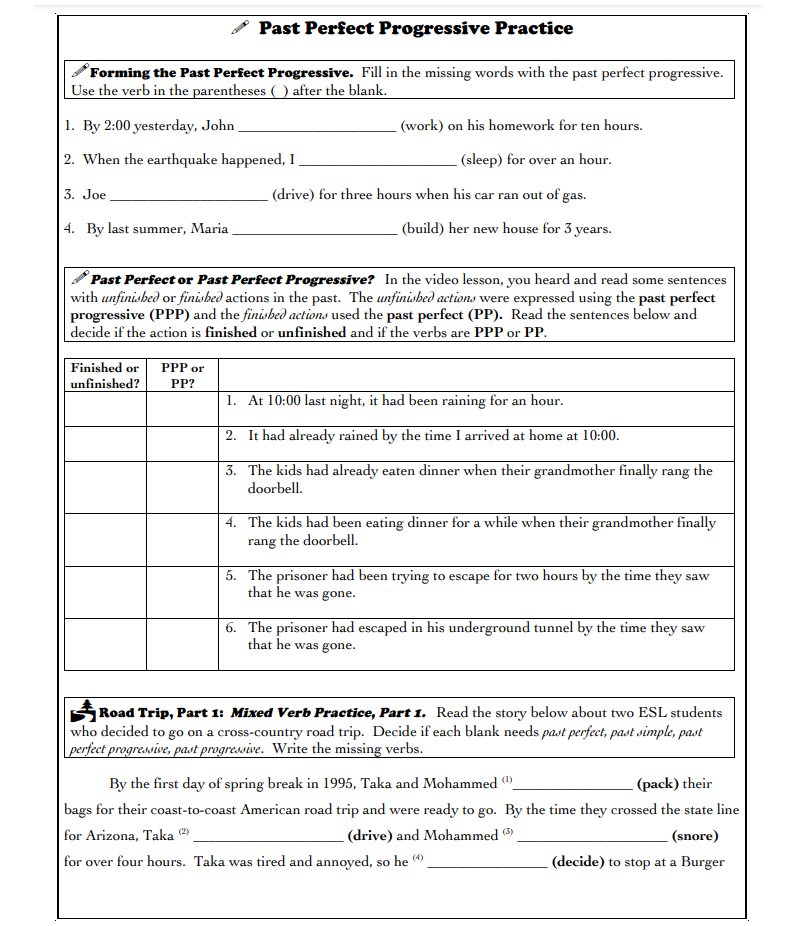
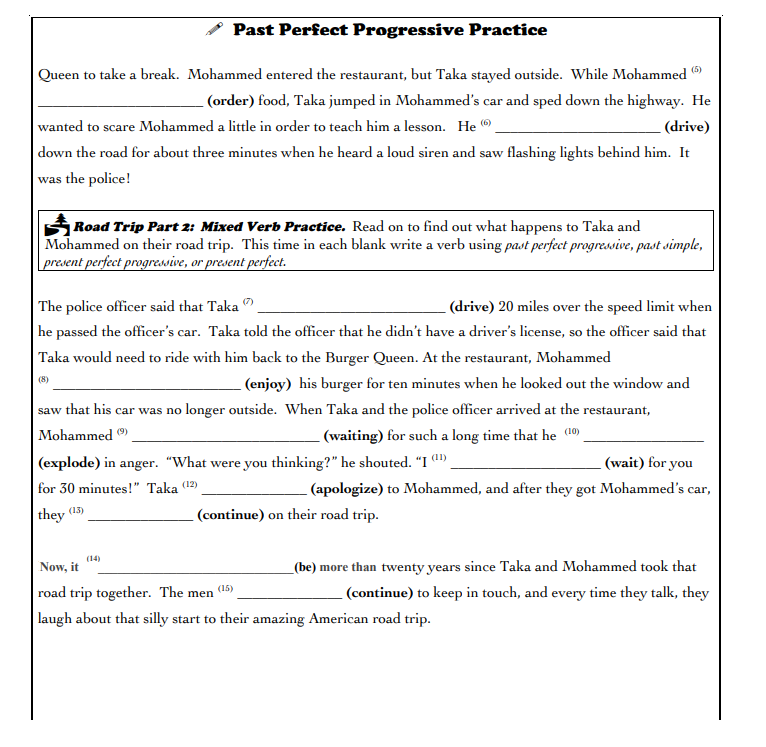
Answer
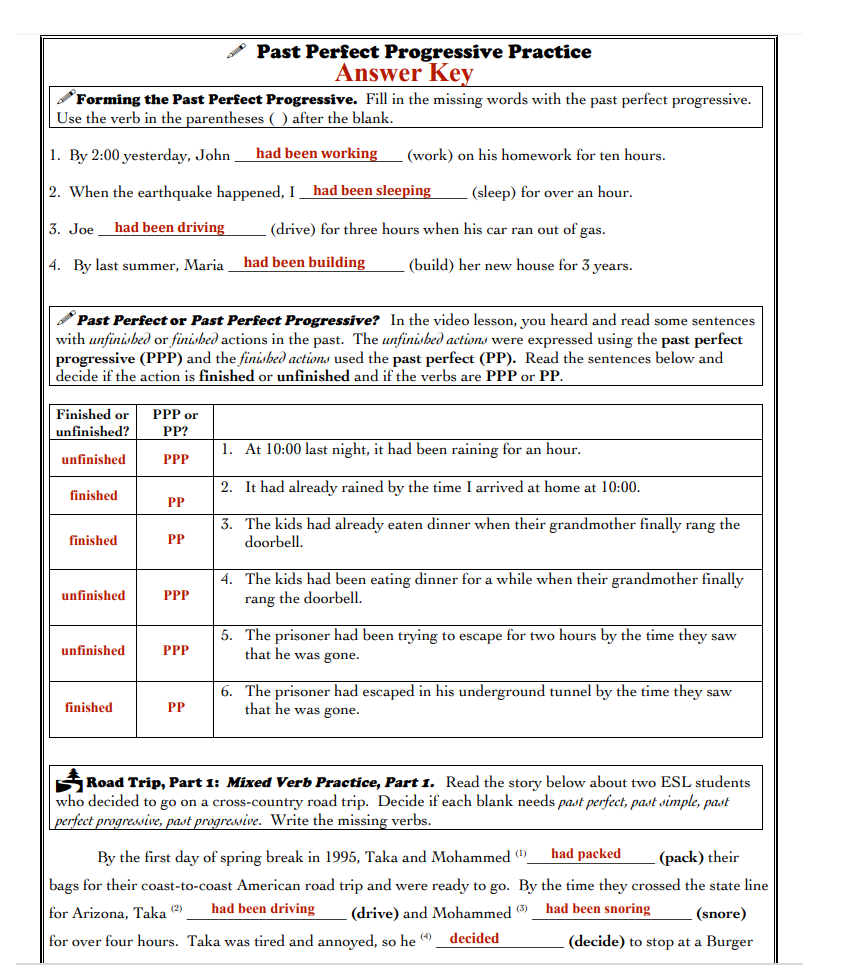

Practice Quiz on Past Perfect Progressive Questions

Graded Assignment: Past Perfect Progressive Assignment
Write a story about an exciting event in the past. This can be a true story or an imaginary story. Use lots of past perfect and past perfect progressive verbs. Use both affirmative and negative statements. You should write the story in paragraph form and use at least 6 sentences.
For example:
When James was 10 years old, he had the best birthday party ever. For weeks, he had been waiting for his birthday, and he had been asking his parents to give him a bicycle for his birthday. He had also asked them to let him have a party at the beach.
When his birthday finally arrived, he got up early. There was a string tied to his arm. He got up and followed the string. He followed it out of his bedroom and down the hallway. The string led him into the garage. When he finally got to the garage, his parents and sisters were there. They had been waiting for him for several minutes. As James went into the garage, his family yelled, “Surprise! Happy birthday, James!” That’s when James saw his new bicycle. It had been hiding there all week, but he hadn’t noticed.
James decided to ride his new bike to the beach for his party. When he got to the beach, his friends had already arrived. They had been playing in the ocean and having a good time. When he arrived, they all ran toward him and wished him a happy birthday.
My Try
When Sarah was in high school, she had the most thrilling adventure of her life during a camping trip with her friends. They had been planning the trip for months, eagerly anticipating the opportunity to explore the wilderness. Sarah had been packing her backpack for days, making sure she had everything she needed for the excursion. On the morning of the trip, she had been filled with excitement as she hopped into her friend’s car with all her gear. They had been driving for hours, chatting and singing along to their favorite songs on the radio.
As they had arrived at the campsite, they had been greeted by breathtaking views of the mountains and the crisp scent of pine in the air. They had been setting up their tents when they had heard a rustling noise coming from the bushes nearby. Sarah had been feeling nervous, wondering what could be lurking in the wilderness. Suddenly, a bear had emerged from the bushes, and Sarah had screamed in terror. Her friends had been frozen in fear as they had watched the bear approach their campsite.
Fortunately, a park ranger had been nearby and had quickly intervened, scaring the bear away. Sarah had been shaken but relieved that they had been safe. After the ordeal, they had spent the rest of the trip cautiously enjoying the beauty of nature and sharing stories around the campfire. Despite the scare, Sarah had returned home with unforgettable memories of their thrilling adventure in the great outdoors.
Graded Quiz: Past Perfect and Past Perfect Progressive Quiz
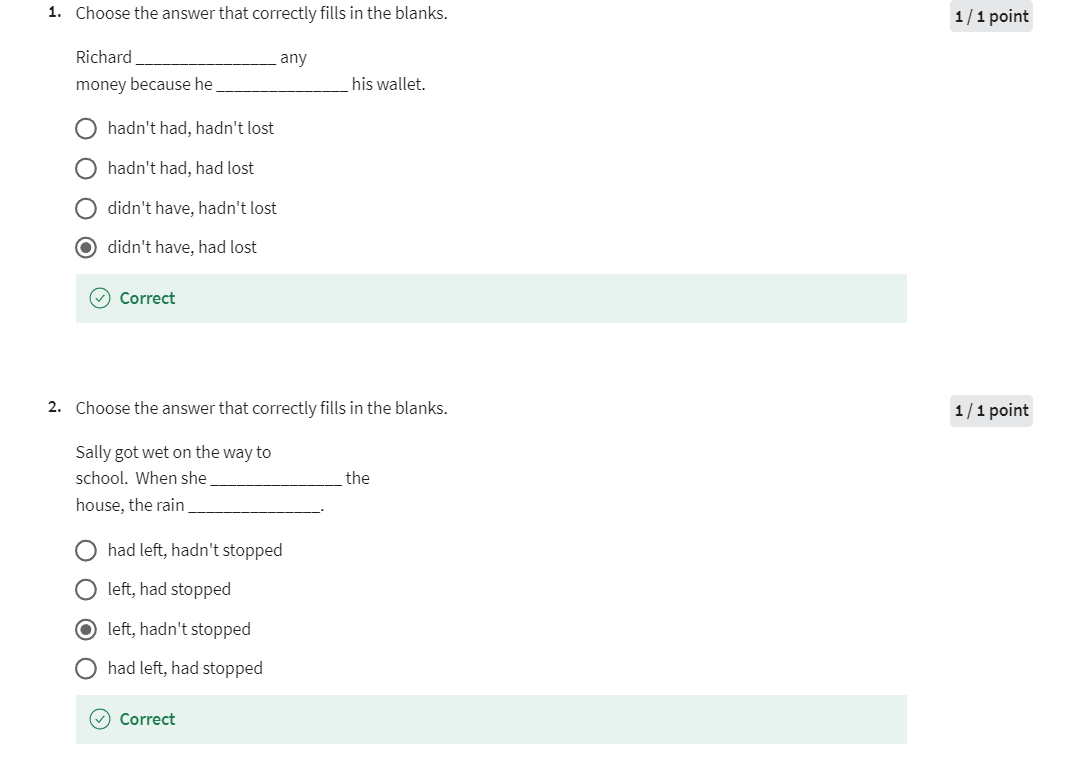
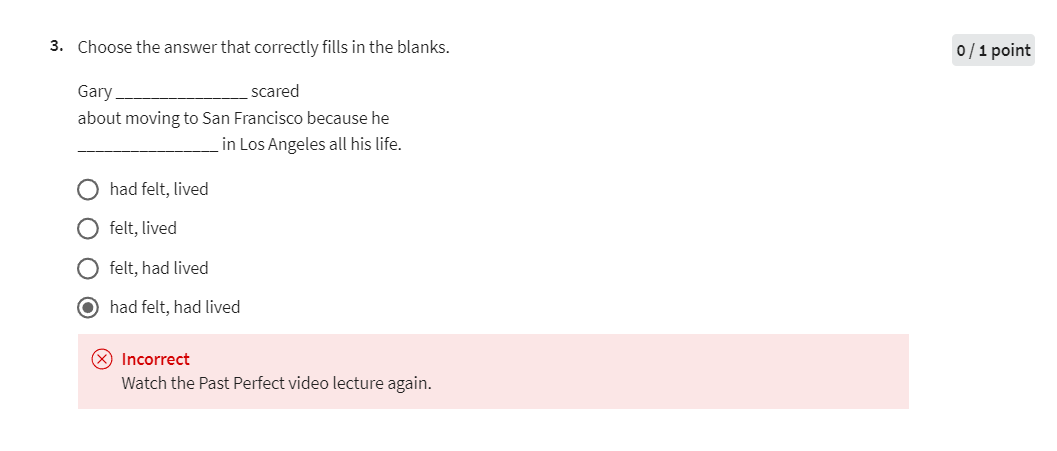
The correct answer is: felt, had lived
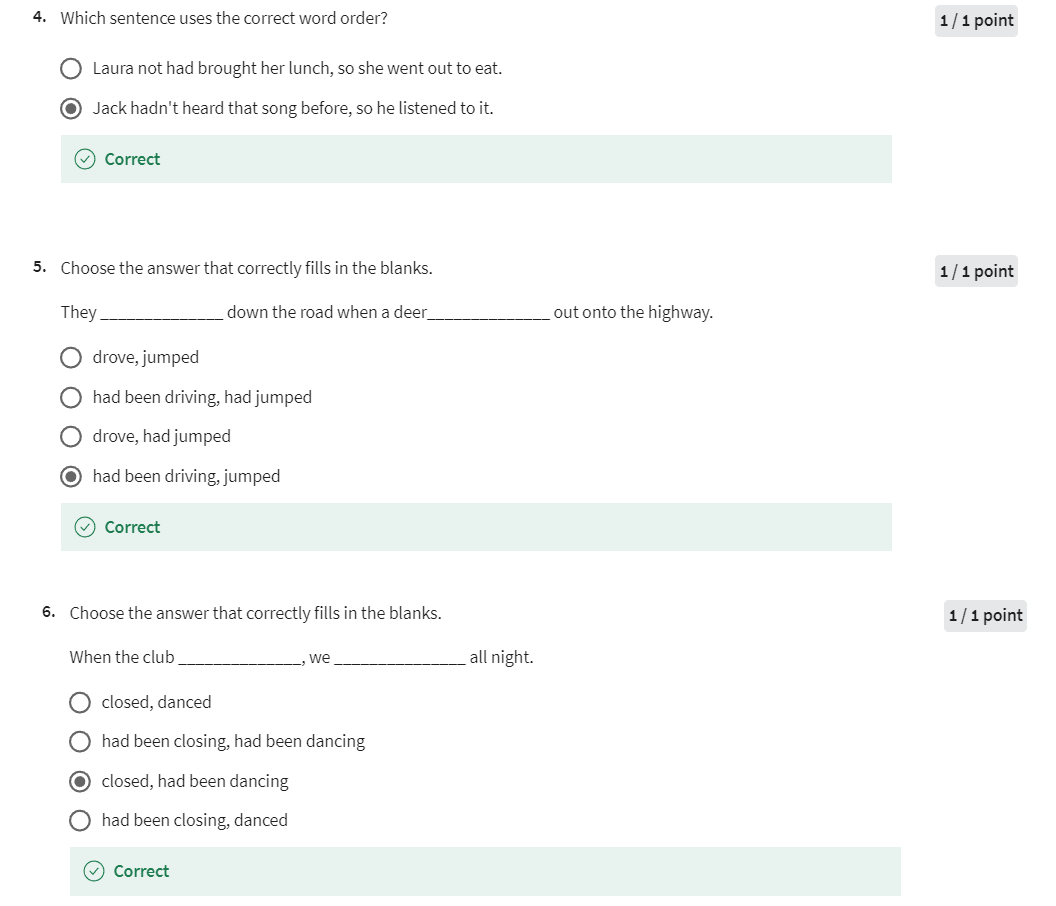

The correct answer is:
It shows an action that started in the past before another action in the past.
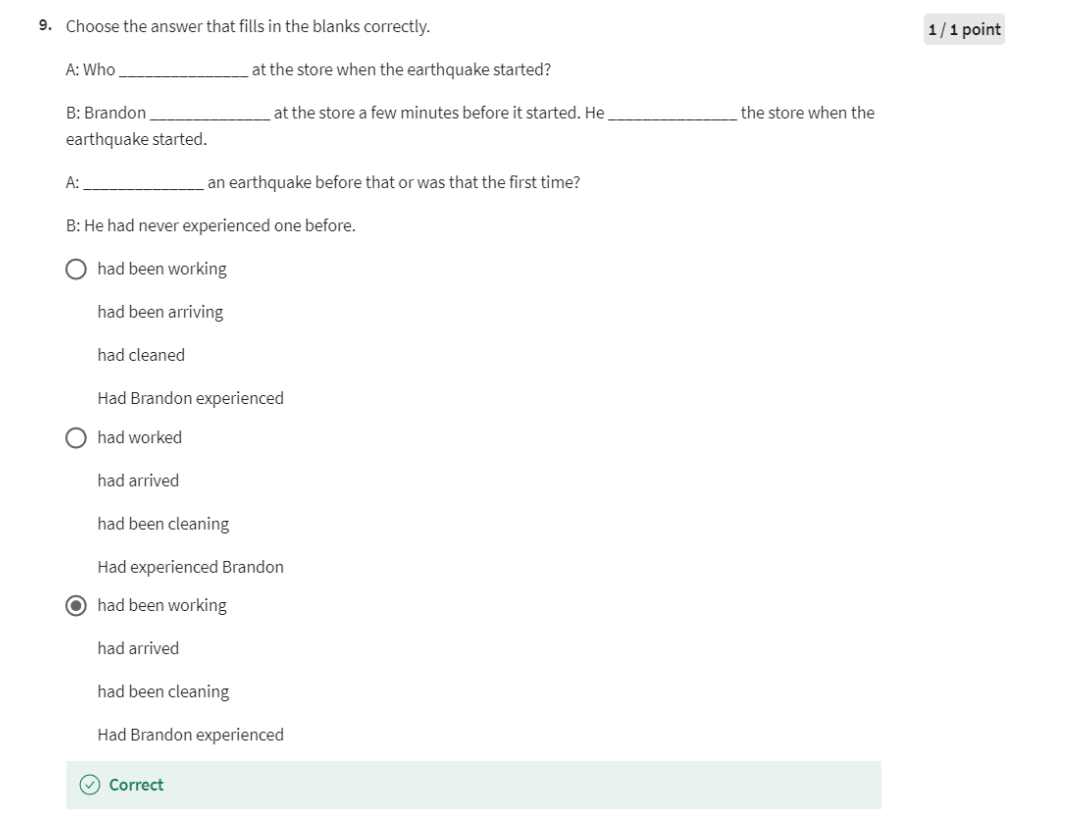
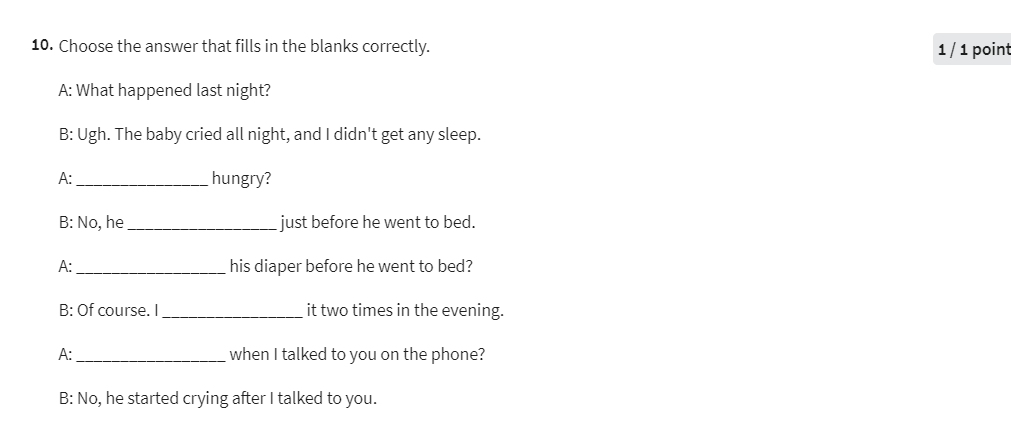
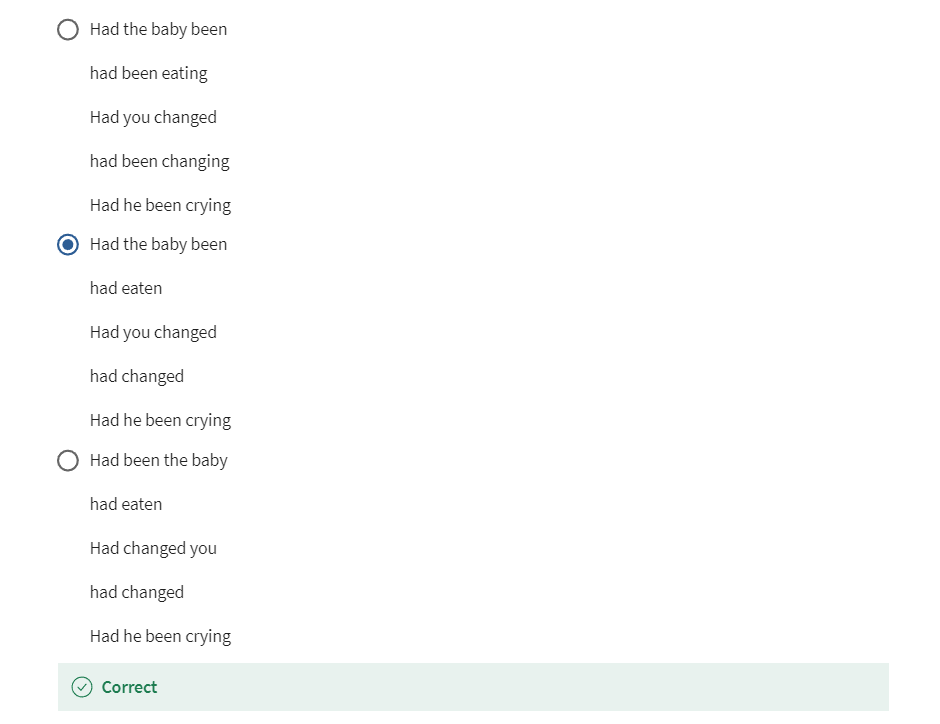
Week 04: Modals–Ability, Possibility, Preference, and Impossibility
In this last week, you are going to learn a lot. This module is all about modal verbs. English has a lot of these, and here you’re going to learn about many of them. They will help you talk about abilities, possibilities, impossibilities, and preferences.
Learning Objectives
- list several examples of modals
- explain two rules for using modals in sentences
Modals Introduction Lecture
Hi my name is Ms. Modal and today I will
give you a short introduction to Modals. Modals are a special group of
words that help main verbs, so they are called helping verbs. In a sentence they usually come after
the subject and before the main verb. When you put a modal with a main verb
it gives the verb a special meaning. You will learn about the special
meanings in other lessons, but first let’s take a look
at the group of modals. Can, could, may, might, should, had better, must, will, and would.
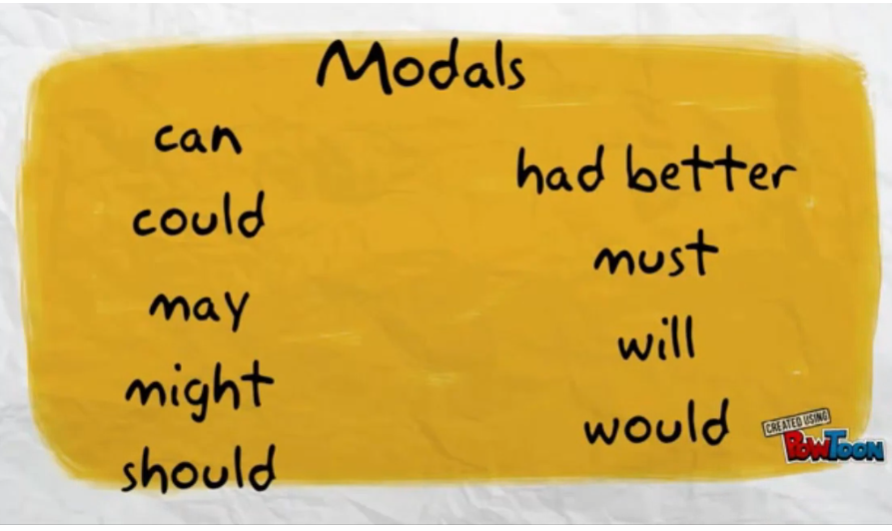
The most important rule about
modals is that they never change. He cans, no, they woulded, no. The second most important rule is
when you combine modals with verbs, the verb stays in the original form. Original form means there is no -s,
-ing, or -ed ending. For example, take the sentence, She runs. If I add can, it becomes She can run. The s is gone. Here are some more sample sentences. The students wore a uniform. I am taking the dog out. The boy is sick. If I add a modal to each
of these sentences, the verb changes back
to the original form. The students must wear a uniform. I should take the dog out. The boy might be sick. Where, take, and
be are all original verbs. Does this make sense? I hope so, let’s do a quick review. Today, you have learned that
modals are helping verbs and you always use it with
the original form of the verb. Thanks for listening, bye.
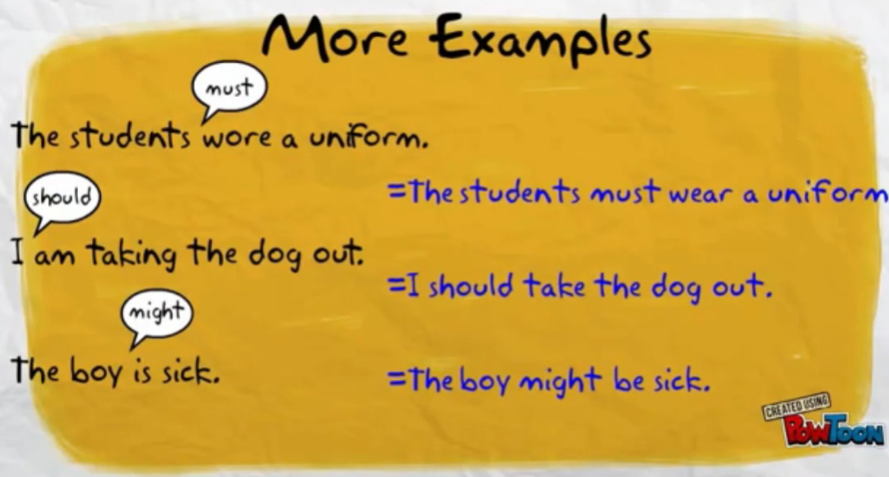

Phrasal Modals Lecture
Hello. >>Hello. Who are you? >> I’m Ms. Modal. >> What? No, you’re not. I’m Ms. Modal. You’re Ms. Phrasal Modals. >> I am? I am. How did you know? >> Your modals are different
from my modals. Look. Have to, have got to, ought to,
and be able to, they all have to. >> You’re right.
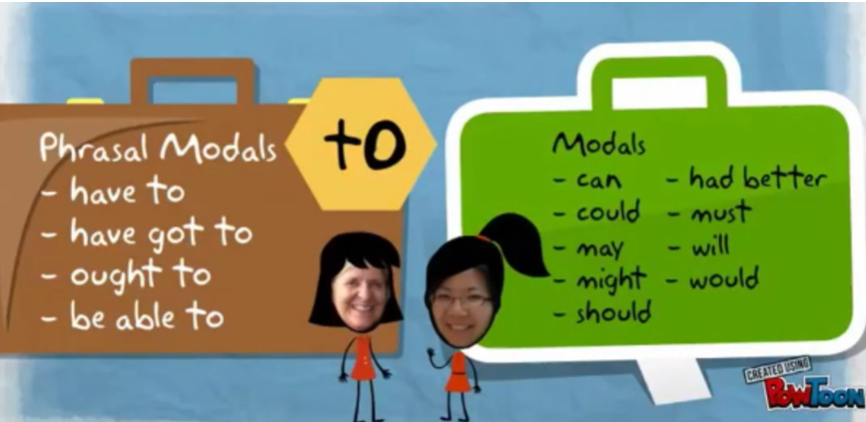
Well,
your modals are similar to my modals, because when you’re with a verb,
the verb stays in the original form. For example, they run,
becomes they have to run. >> I see. But actually, I would call you Ms.
Fake Modals. >> Fake modal? Why? >> Well, for have to,
have got to, and be able to, the modal changes
depending on the subject. For example, when you change the subject
from they to she, have changes to has. She has to run. >> I see. >> Okay.
Let me show you a couple more examples. Number one.
The bird have got to find food? No.
The bird has got to find food. Number two. The boy be able to eat spicy food? No. The boy is able to eat spicy food. >> Got it. >>

Ought to is the only
one that doesn’t change. They ought to sleep. He ought to sleep. I guess this isn’t a fake modal. >> See, I’m not completely fake. Fine, fine, Ms. Phrasal Modal. You learned about modals and
phrasal modals.
Phrasal Modals Practice
Practice

Answer
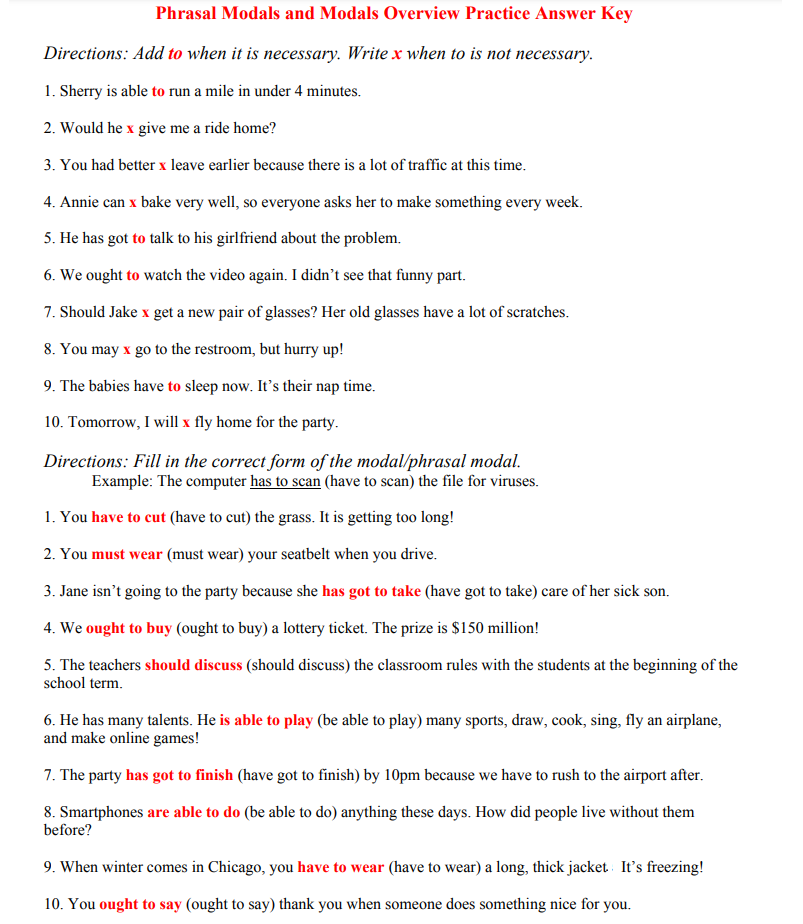
Ability Modals Lecture
Hi. Hey, want to see what I can do? Watch this. Did you see that? Did you see what I can do? I can do a handstand. How about you? Can you do a handstand? What can you do? Today, I want to talk to you
about how to express ability and inability in English, using the words can,
could and be able to. Do you know what kind of verbs these are? If you said modal verbs, you’re right. So, how about it? Do you want to learn how to use
these words to express ability? I’ll teach you, come with me. Let’s start with ability
in the present and future. These babies can touch their toes! We can also say,
these babies are able to touch their toes! We use the modal verb, can,
and the phrasal modal verb, be able to, to express ability. Because these are modal verbs, they’re followed by the simple
form of the main verb. Can you find the main
verb in these sentences? That’s right, it’s touch. So these two sentences mean
exactly the same thing. But let’s take a look at
the first one to see how it’s a little bit different in its
form than the second one. When we use can,
all we need is any subject. Followed by can, remember no s, and a main verb in its simple form. To make it negative, we can say cannot or
the contraction can’t. For example, this baby can’t walk. She can only crawl.

Unlike can, be able to will
change according to the subject. For example we say, I am able to. You, we, they are able to and he, she, it is able to all followed by the main verb. To make it negative, we simply add not. For example, she is not able to walk.
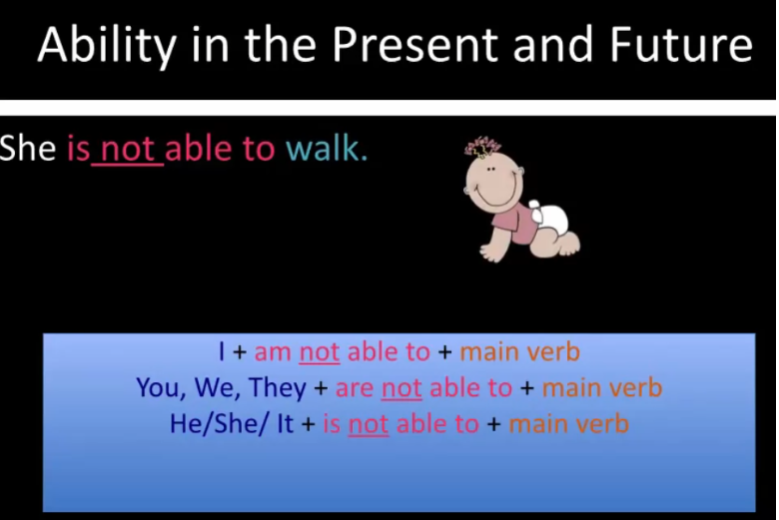
Okay, let’s take a look
at ability in the past. When Joe was younger,
he could touch his toes. Now, he can’t. Poor Joe. We can also say when Joe was younger,
he was able to touch his toes. Now he can’t. We use the modal verb could to
express ability in the past. We have another clue in this sentence that
tells us we’re talking about the past. Can you find it? Yep, it’s the verb was,
which is in its past form.
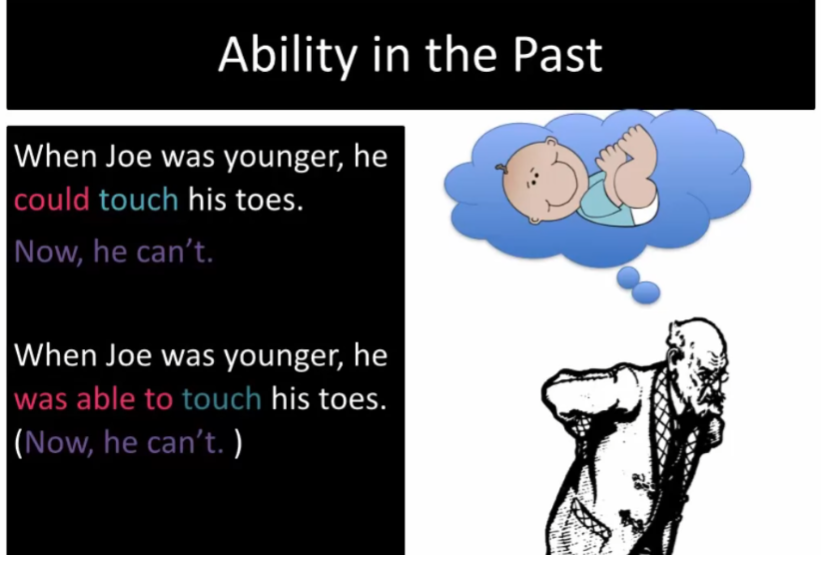
Just like can, could is easy to use. We don’t need to change it
according to the subject. To make it negative, we simply add not or
use the contraction couldn’t.
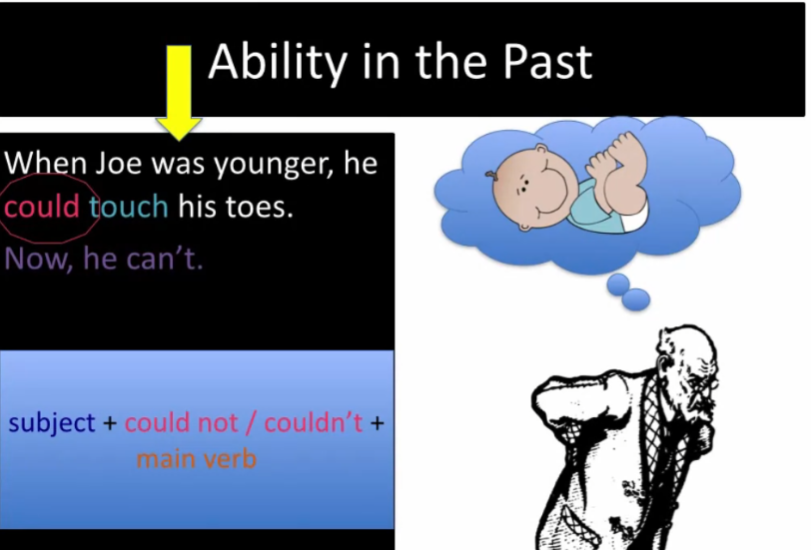
Be careful with be able to in the past. There are two different forms. We can say I, he, she and it was able to. And you, we, they were able to. To make it negative, we simply add not. Was not able to and were not able to.
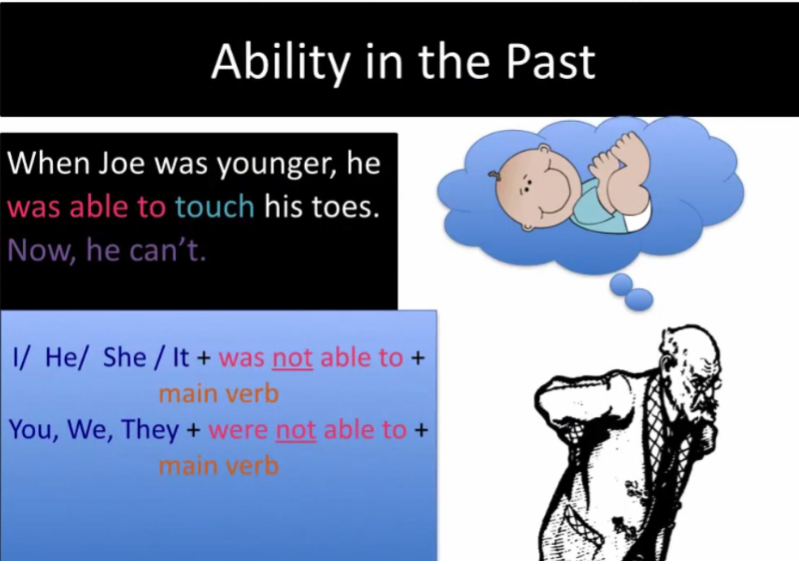
Okay, let’s review what we learned. To express ability in the present and
future, we can use can or
cannot to express inability. And the main verb in its simple form. To express ability and
inability in the past, we can use could or
could not, and let’s not forget the contractions,
can’t and couldn’t. We can also use the phrasal modal verb, be able to, to express ability
in the present and future. And in the past. I hope you had fun learning how
to express ability in English.
Modals Part 1 Practice Quiz
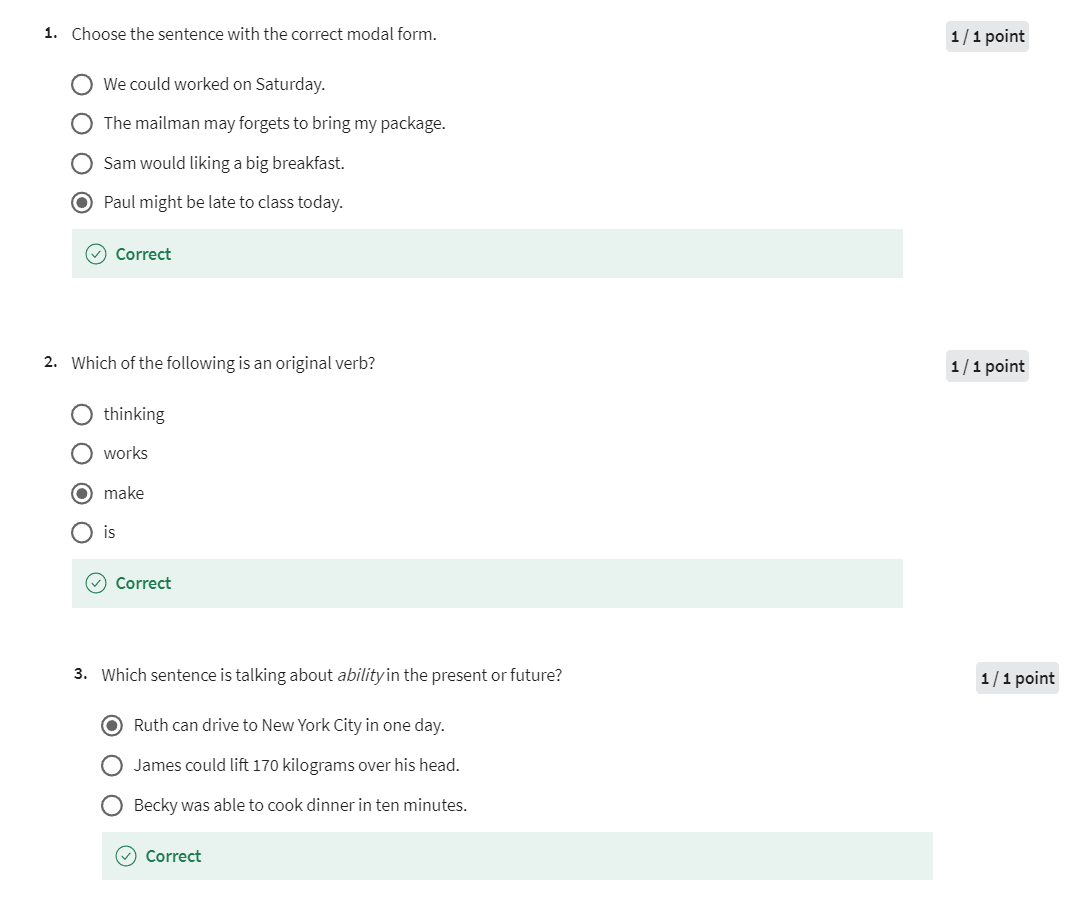
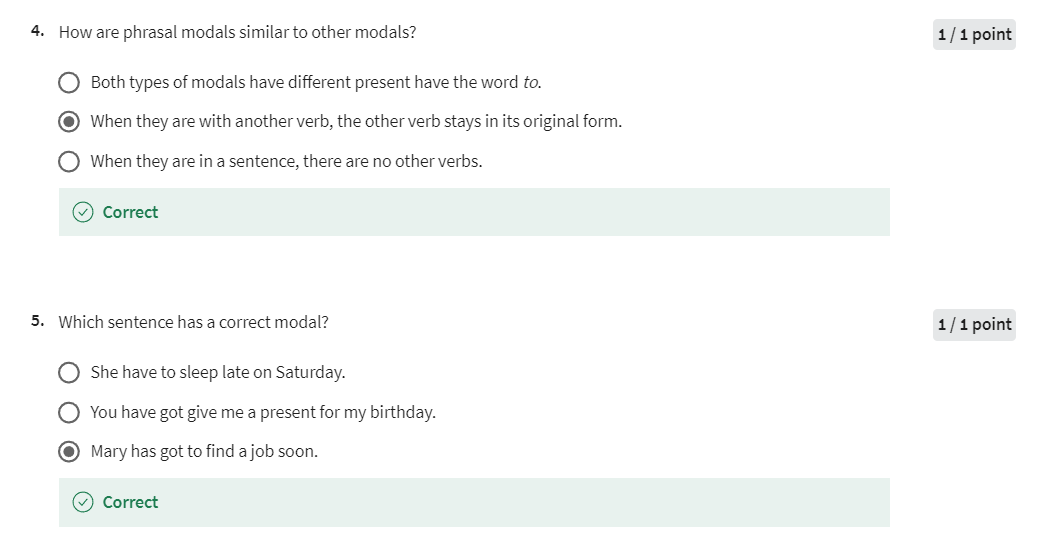
Modals of Possibility Lecture
Hi.
This is a grammar lesson on modals of possibility. Let’s start with a quick exercise. Imagine one of your good friends. Can you picture his or her face? What do you think your friend
could be doing right now? Do you think your friend
could be playing sports? Might be at a club dancing. Maybe at home reading, or
maybe your friend is driving around town. Let’s look at these sentences again. My friend could be playing sports. My friend might be at a club dancing. My friend may be at home reading. Maybe my friend is driving around town. All of these sentences
express possibility. Meaning, there is some chance
that these sentences are true. The first three sentences
use modals of possibility. Could, might, and may, shown in red, plus the base form of
a main verb shown in blue. Could, might, and
may have the same meaning, but one is more formal than the other two,
and that’s may. You will see may used more in writing
than in speech or conversation.
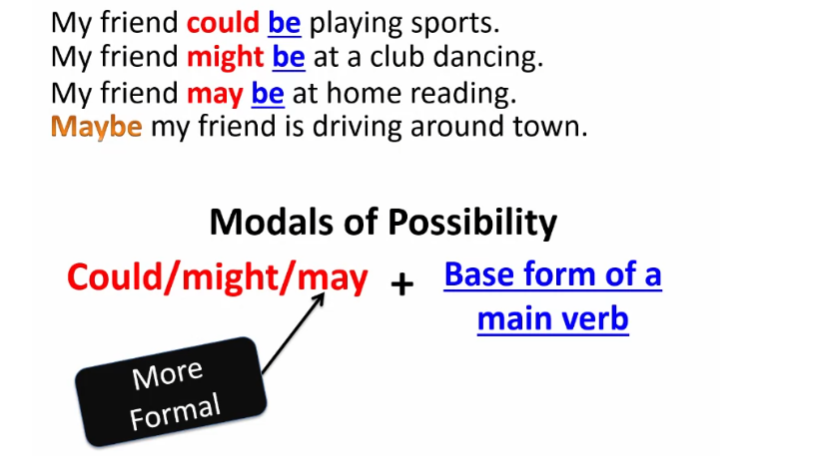
I want to say one more thing about may. But may used With be. May be. And how it is different from maybe. Let’s look at the sentence
that uses maybe. Maybe my friend is driving around town. Maybe, which is one word, means possibly. So this sentence, like all the other
sentences, expresses possibility. It means the same as saying,
my friend may be driving around town. Maybe, one word, is not a motile, but instead an adverb, and
it goes at the beginning of a sentence.
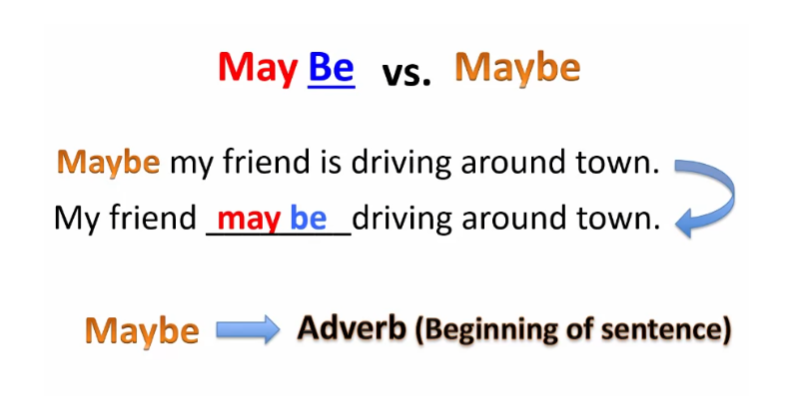
Okay, let’s get back to modals. Look at this image here. What could this image be? Use could, might, or
may to give an answer. Well, if you focus on the white, you’d
probably say, this image could be a vase. If you don’t know what a vase is,
a vase holds flowers. If you focus your attention
on the black parts, you’d probably say this image may
be two faces looking at each other.
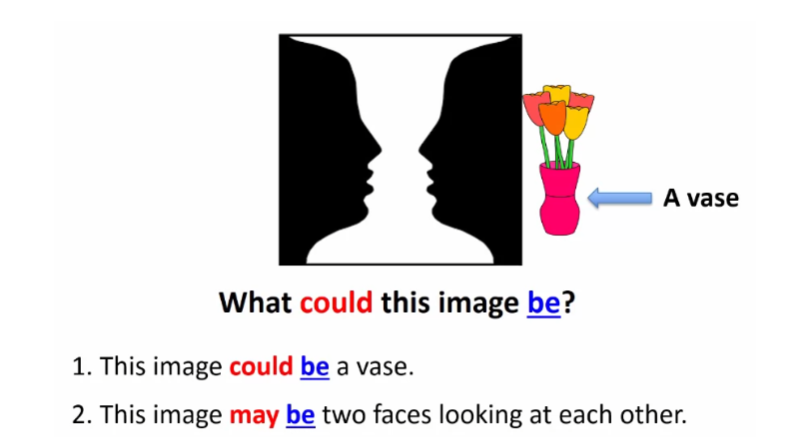
Great. Let’s try another image. What could this image be? Well, I think this image may
be the back of a young lady. But there’s another possibility. Do you see it? A left eye here. The tip of a nose here. A mouth here. Yes, this image could be
the side of an old woman’s face. Kind of creepy, don’t you think?
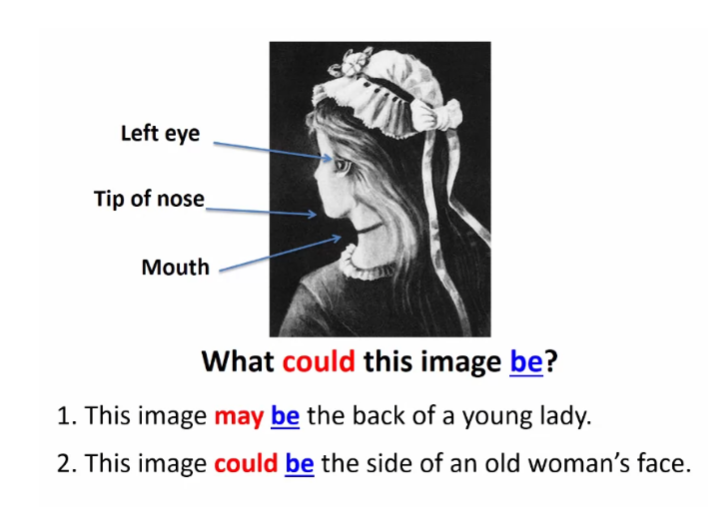
Okay. So far, all the sentences we
looked at were in the same tense. Which one? Well, the present tense. We’ve seen sentences like,
My friend could be playing sports. My friend might be at a club dancing. This image may be two faces
looking at each other. The same structure can be used
to express future possibility. For example, it may snow tomorrow. I might cook tonight
instead of eating out. My mother could call me this week.
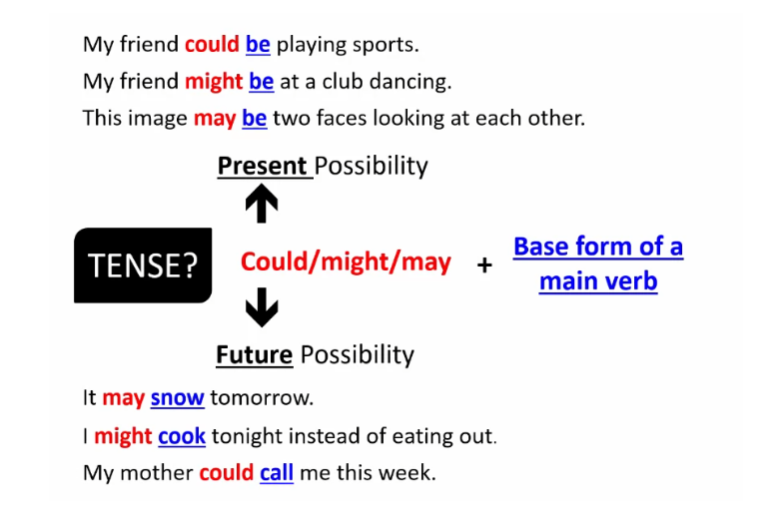
So let’s practice. How would you answer these questions? Number one,
what might the weather be like tomorrow? Number two, what could you eat for
breakfast tomorrow morning? Number three,
where could you go on your next vacation? Well, here are my answers. It might rain tomorrow. I could have eggs and bacon. I might also have some coffee. I could go to Las Vegas. It’s only five hours away by car.
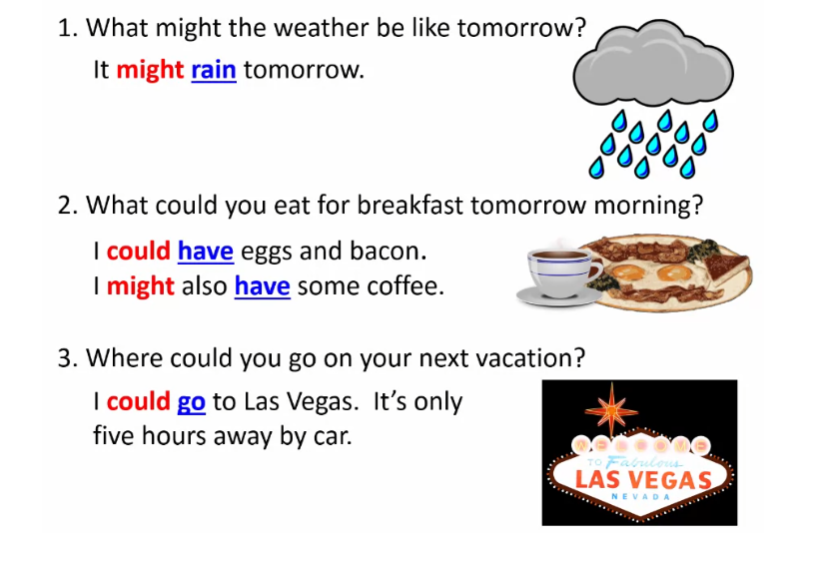
All right. So we’ve learned how to use could,
might, and may, to express present and future possibility. Let’s learn one more modal, one that
shows a very high chance of possibility. Look at these pictures. Let’s match the sentences
to each of the images. A.
The baby must be hungry. That goes here. B. He must be sick. Definitely goes here. C. The man must be late. This man looks like he’s definitely
late for something important. And D.
He must be very angry. This bright red face shows anger for sure. Notice the words in red. It’s must. This is another modal. When we use, when we are very certain
about what we think is possible. I’m going to call this
the modal of certainty. And like the other modals, must is used
with the base form of a main verb. Let’s look at some more pictures. How would you use the pictures
to complete the sentences? Well, here are my answers. The penguin must be cold. The diamond ring must cost a lot. The lady bugs must love each other. The monkey must be scared. Do you have similar answers?
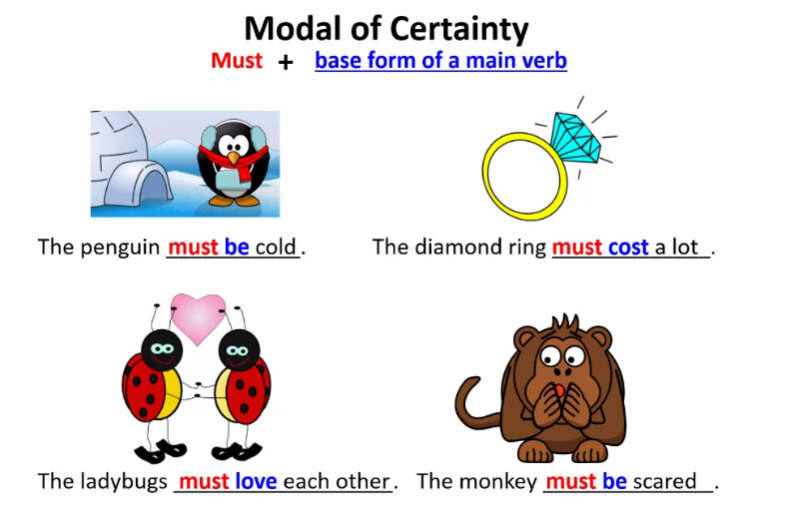
Okay, let’s review. We learned that the modals of
possibility are could, might, and may, and the modal of certainty or
high chance of possibility is must. I hope you feel confident enough
to try these modals yourselves. Thanks for watching.
Modals of Possibility Practice
Practice
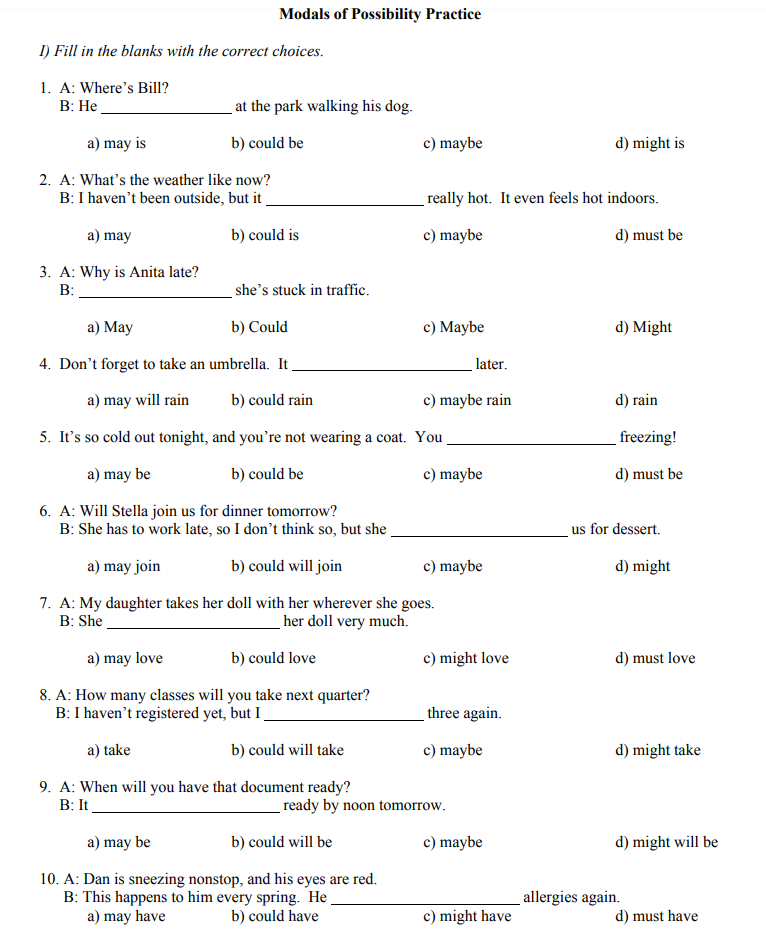
Answer
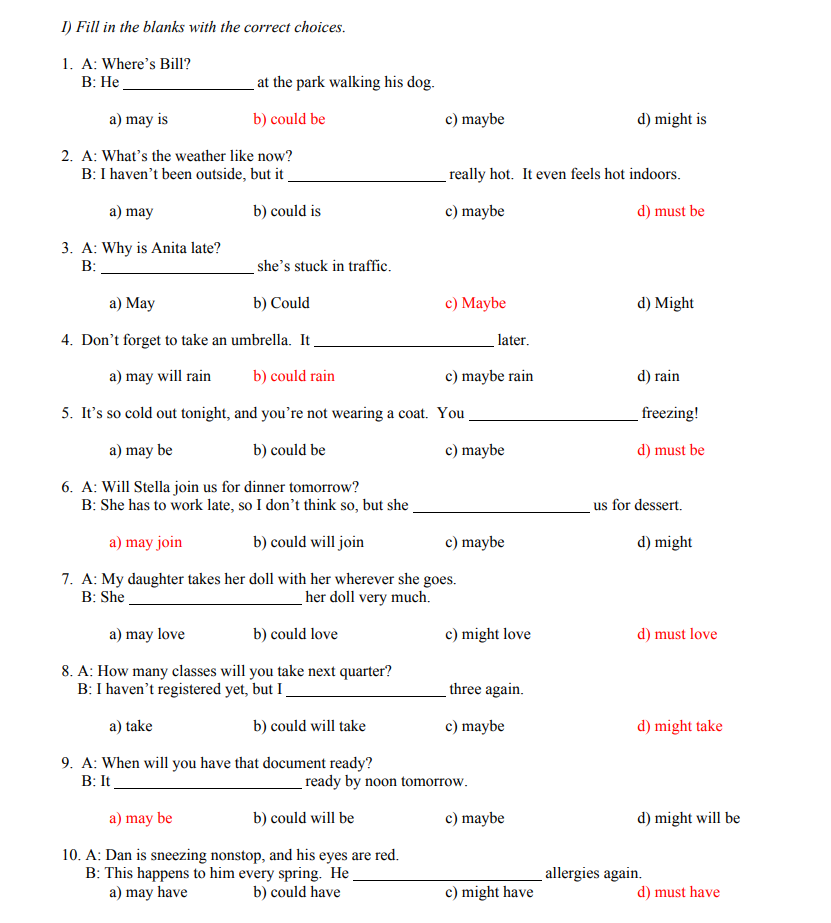
Advice Modals Lecture
Giving advice with the modal verb should,
ought to and had better. [SOUND]
It’s Joe. >> Yeah? What did he say? >> He said, see you at
the restaurant in an hour, what? The restaurant? No, my gosh. I completely forgot. Today’s our anniversary. We’re going to Gary’s Steakhouse
in an hour at 7 o’clock. I’m not even ready,
I don’t even have a gift. What am I going to do? How am I going to buy a gift, wrap it,
and make it to the restaurant by seven? [SOUND]
Poor Emily, she needs our help. Where is the best place for
Emily to buy a gift, at the city park, a drugstore, a shopping mall,
or a supermarket? I’m thinking a shopping mall. There are many stores and
lots of presents to choose from. Which way sounds more friendly? I’m telling you to go to the mall, or,
it’s a good idea to go to the mall. The first way is a command. It may sound bossy to tell
someone to do something. The second way, say that’s a good idea,
sounds more friendly. There are three main advice modals. Should. She should buy a gift at the mall. Ought to. She ought to buy a gift at the mall. Had better. She’d better buy a gift at the mall. The first way, should, is the most common. It can be used in any situation from
informal conversations with friends to formal academic and
professional writing. The second way, ought to,
is used in conversations. It is not often used in academic and
professional writing. Because ought to is informal style,
ought to is often reduced to otta. She otta buy a gift at the mall. The third way is had better. That d stands for had. She had better buy a gift at the mall. In conversation,
we often contract it to she’d better. She’d better buy a gift at the mall. This last one, had better, is the
strongest of these three advice modals. There’s a sense of danger, like something
bad will happen if you don’t follow this advice, for example,
maybe the mall will close very soon. Emily had better buy a gift
at the mall before it closes. If she doesn’t reach
the mall before it closes, she will not be able
to buy a gift in time.
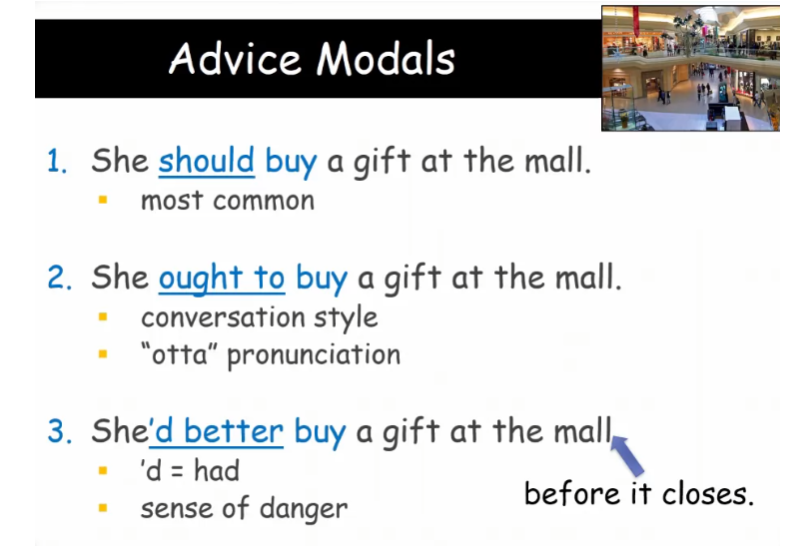
In my conversation with Emily,
it is almost 6 o’clock. Do you remember what time she
needs to be at the restaurant? She needs to be at
the restaurant at 7 o’clock. That gives her an hour,
not very much time for shopping. She should not spend too
much time at the mall. This is an example of using an advice
modal in its negative form, should, would not. Should not can be contracted to shouldn’t. She shouldn’t spend too
much time at the mall. In American English we do
not use ought to with not. With not, we will use should or
have better. For example, she had better not
spend too much time at the mall. Had can be shortened, contracted, she’d better not spend too
much time at the mall.
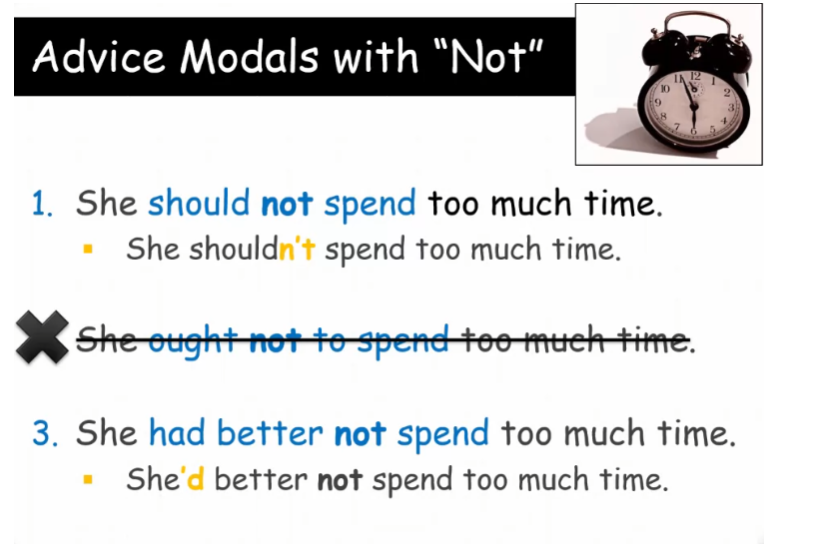
Don’t worry, I have an idea. >> Okay? >> Well you don’t have much time, so
you’d definitely better not drive too far. >> All right, where should I go? >> You ought to try the Irvine Mall. It’s on the way to the restaurant, and
there are lots of stores over there. >> Okay, okay. >> And
maybe you should get a gift receipt too. That way, if he doesn’t like the present,
he could easily return it. >> Great idea.
Thank you so much Judy. I’d better go now if I
want to make it on time. Bye. >> Have fun. >> Thanks.
Let’s review. There are three advice modals. Should, ought to, and had better. Which one is the strongest? Remember, had better has a sense
of urgency, of emergency, like something bad will happen
if you don’t follow this advice. Notice, not is common with should and
had better. The negative is not commonly
used with ought to. Finally to,
ought is always followed by to. There is no to with should and had better. Well I better go now, I ought to call
Emily and see how her date went, talk to you later.
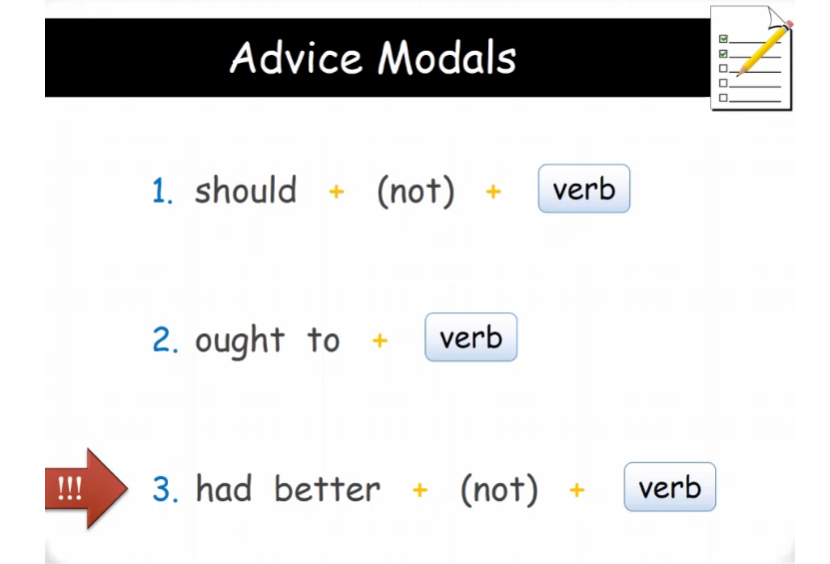
Preference Modals Lecture
Modal of Preference Would Rather and
Other Expressions of Preference. >> I’m so
glad we’re finally on break, guys. >> I know!
We have a whole week off to go anywhere we want. >> We can finally plan our trip. >> Yeah, I can’t wait to lie
on a beautiful beach and go surfing, like in Hawaii! >> That sounds nice, but
I like the snow better than the water. Can’t we go snowboarding instead,
perhaps in Colorado? >> But I like warm weather
better than cold weather. >> Pink,
would you rather go to Colorado or Hawaii? You can make the decision since Gray and
I can’t agree. >> Ok, well, I prefer snowboarding to
surfing, but I’ve never been to Hawaii. >> So you pick Hawaii? >> Well, I’m not sure. You see, I would love to visit Hawaii some
day, but I think I would rather play in the snow, rent a nice little cabin,
and drink hot chocolate by the fire. Doesn’t that sound nice? >> Yes, it does. All right. So you pick Colorado. Great! >> Never mind! I’d rather go to Hawaii than Colorado. >> Yes! >> Ugh!
Hi, in this lesson you will learn how
to use different expressions to show what your preferences are. In other words,
what you’d like more than something else. Let’s look at the preferences
expressed in the conversation. I prefer snowboarding to surfing. I like snow better than the water. I like warm weather
better than cold weather. I would rather play in the snow. I’d rather go to Hawaii than Colorado. Would you rather go to Colorado or Hawaii? As you can see Gray, Pink, and Blue were
all able to express their preferences between going to Hawaii or Colorado. But they did it using different types
of expressions, including the phrase or modal, would rather.
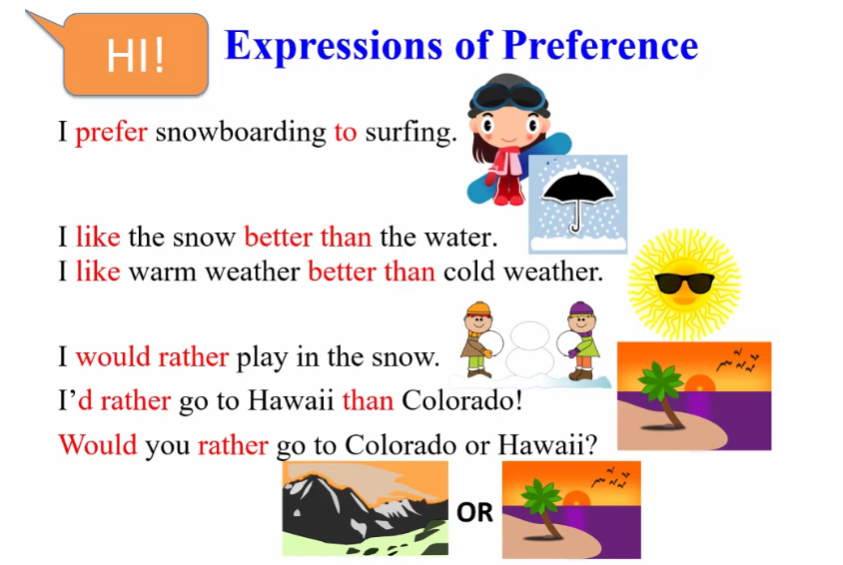
Let’s first start with
the use of the verb, prefer. I prefer snowboarding to surfing. The structure used here was prefer,
-ing verb, to, -ing, verb. Notice the preposition to. When you use prefer to compare
two actions or activities, you must use the preposition to. Why don’t you try? Answer this question. Do you prefer singing or dancing? If you like singing more, you would say,
I prefer singing to dancing. If you like dancing more, you would say,
I prefer dancing to singing.

Now let’s move on to using like. In the conversation we heard,
I like the snow better than water. I like warm weather
better than cold weather. Do you see a pattern? When you use like, you use better than. This structure can be used to compare
two nouns, as we see in these examples. Snow to water,
warm weather to cold weather, but it can also be used to compare two
actions or activities using -ing verbs. Let’s try each form. Look at this image. We could say,
the chick likes worms better than seeds. How about this one? The chick likes being with
family better than being alone. So with like, remember to use better than.
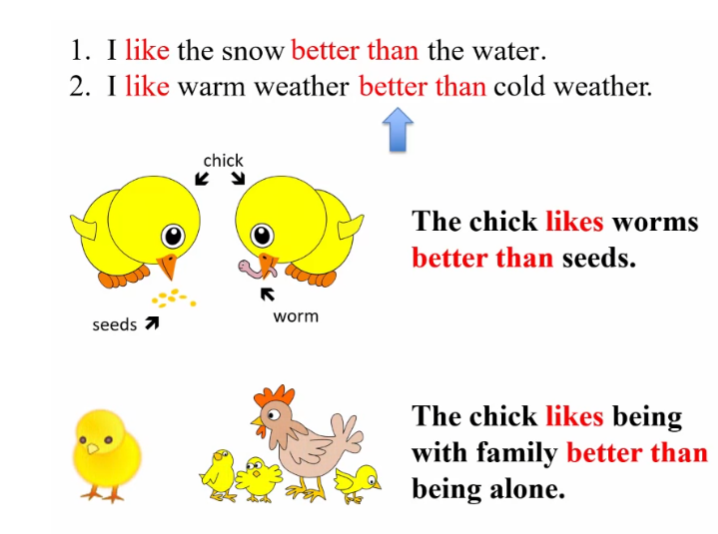
Now I would like to talk about would
rather, a modal to express preference. Because would rather is a modal, we always use it followed by
the base form of a main verb. You can use would rather plus a main
verb to state what you prefer, like when Pink said,
I would rather play in the snow. When you use would rather to
compare two options, use than. We saw this when Pink said,
I’d rather go to Hawaii than Colorado. Hm, did you notice something
strange about this last sentence? Instead of I would, it says, I’d. I’d is a shortened form or
contraction, and contractions are very commonly
used in conversations. So instead of using the longer form,
try using the shortened contractions.
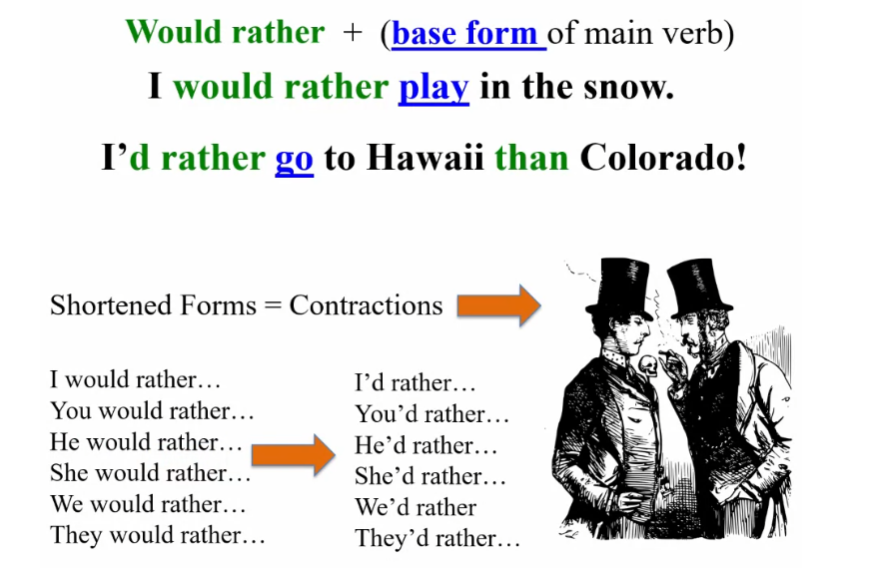
Now you know how to express preference
using the phrase and modal, would rather. But how would you ask someone a question
about their preferences using would rather? Well, how did Blue do it? She said to Pink,
would you rather go to Colorado or Hawaii? What changed from the statement form? Well, would and the subject of
the sentence, you, were switched. Easy, right? Can you use would rather to ask
me what my preferences are? Take a look at these options. Number one, travel alone or with friends. Number two, cook at home or eat out. Well, you could ask me questions. You could ask, would you rather
travel alone or with friends? Would you rather cook at home or eat out? Well, here are my answers. For number one, I’d rather travel
with friends than travel alone. And number two, I’d rather eat out,
ha ha and not have to clean. Great.
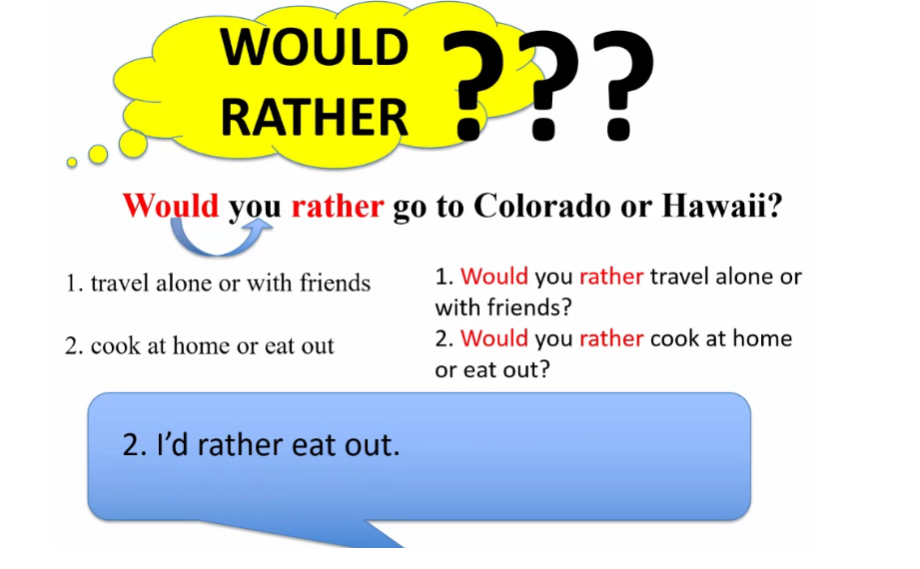
So you know now how to use would rather, but how would you use this
modal in the negative? Just use not. Just add not after would rather and
before the main verb. Can you tell me what I mean when I say, I would rather travel with
friends than travel alone? Does this mean A, I would rather
not travel with friends, or B, I would rather not travel alone. Hm. The answer is B. A is incorrect. How about this sentence? I would rather eat out than eat at home. Does this mean A, I would rather not eat
out, or B, I would rather not eat at home? The correct answer is A. B is incorrect. So, let’s do a quick review. Let’s use better than, to, and
than to complete the sentences. Remember, prefer is used with to, like is used with better than, and
would rather is used with than. Can you express sentence
number three using would rather in the negative form? Yes, it would be, we would rather not go to the theater. Nice job.
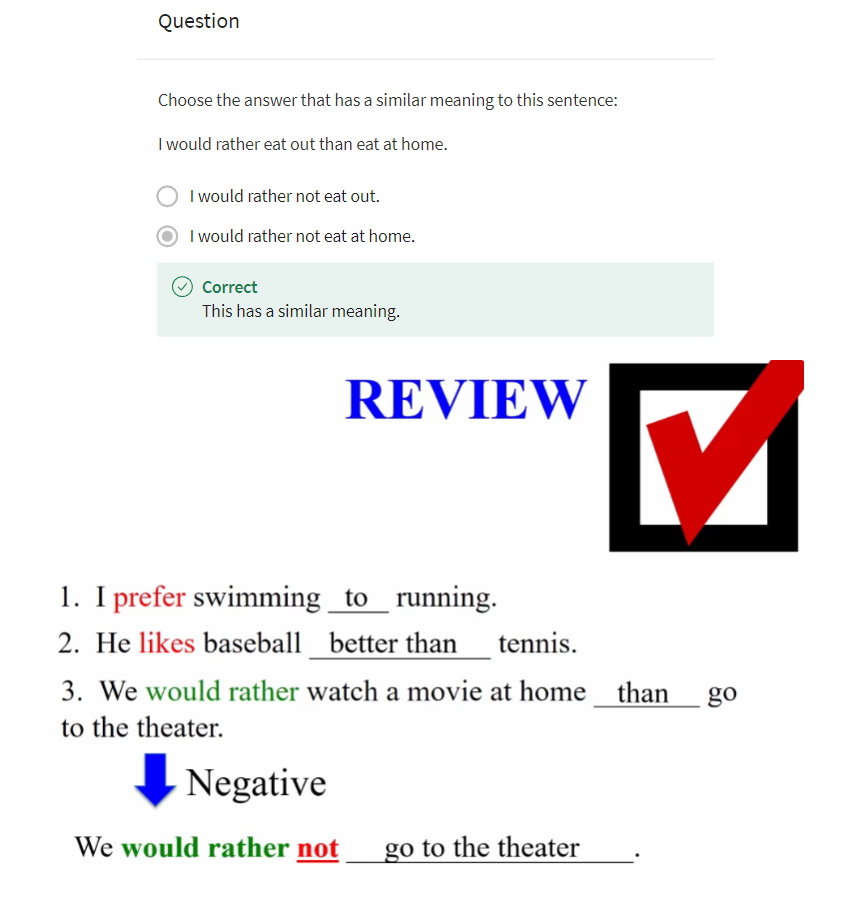
Modals Part 2 Practice Quiz
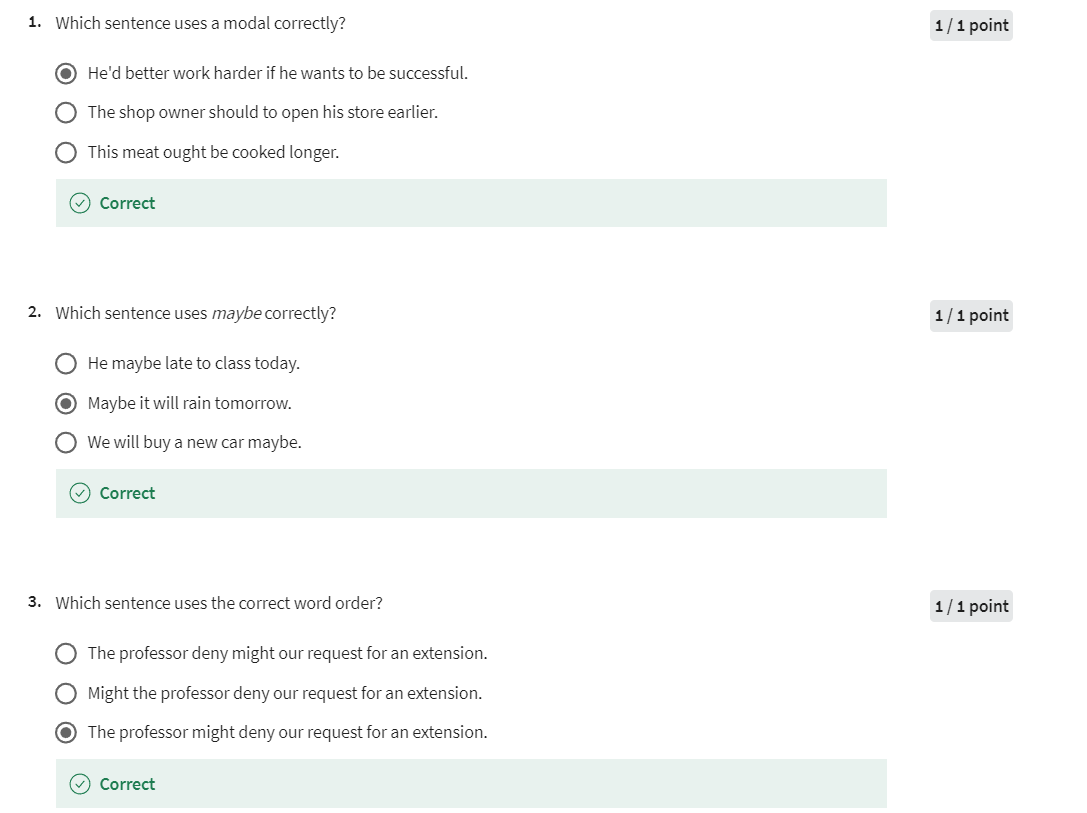
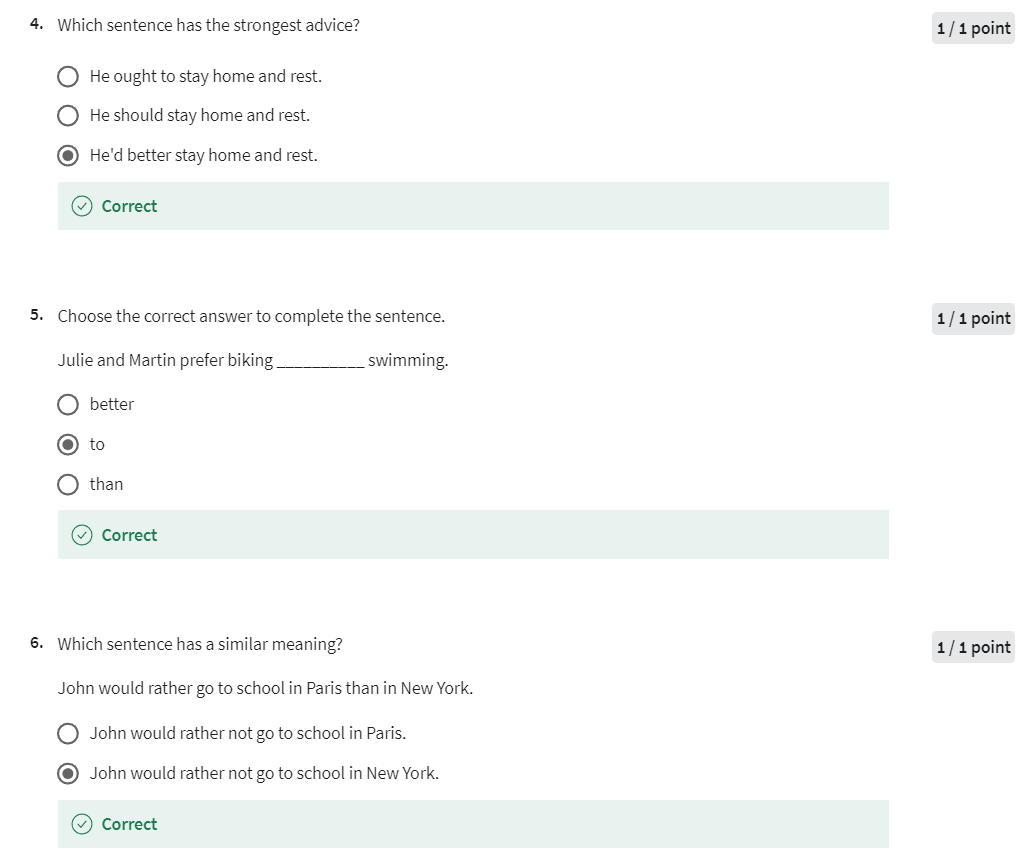
Graded Assignment: Modals Assignment 1
Write 8 sentences. Follow the directions below. Please number your sentences.
Write two sentences about what you can or can’t do.
Write two sentences about what your mother or father could or couldn’t do when they were younger.
Write two sentences about what you might or might not do after you finish this assignment.
Write two sentences about your preferences with food.
My try
-
I can swim, but I can’t dance.
-
I enjoy drawing, but I’m not very fond of singing.
-
My mom could play the piano when she was younger, but my dad couldn’t swim.
-
My dad used to play soccer when he was younger, but my mom wasn’t very good at riding a bike.
-
After finishing this assignment, I might watch TV or play outdoors.
-
I might do some math problems or read a storybook.
-
I like eating fruits, especially strawberries and bananas.
-
I’m not very keen on spicy food because I can’t handle the heat.
Modals of Impossibility Lecture
Modal verbs, can’t and couldn’t,
impossibility or disbelief. [NOISE]
Someone’s at the door. >> Is it your mom? >> It can’t be my mom,
she’s out of the country. [NOISE] Whoa, is it your neighbor? >> It couldn’t be my neighbor,
he’s at work right now. [NOISE]
Who could it be? >> Can’t and couldn’t,
these modal verbs express impossibility or disbelief in the present. >> For example,
my mom can’t be at the door. She’s traveling to another country. It’s impossible!

For impossibility and disbelief,
can’t and couldn’t have the same meaning. >> It can’t be my neighbor, or
it couldn’t be my neighbor. He’s at work right now. >> It can’t be my neighbor is the same as it couldn’t be my neighbor.
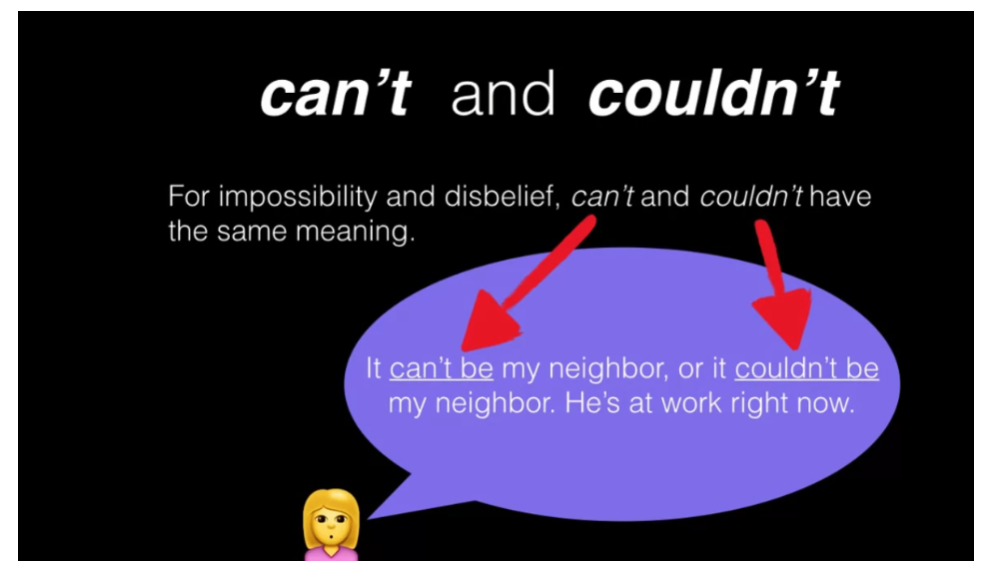
Can’t and couldn’t show that
someone is not 100% certain. >> I can’t see who it is,
so I don’t know for sure. However, I’m almost certain it
isn’t my mom or my neighbor. >> [NOISE] Hi, thank you. >> I was right, it wasn’t my mom or
my neighbor, it was the postman. >> Well, what is it? >> I have no idea. >> Well, it can’t be your phone,
it’s too big. >> Yeah, clearly, and it’s obviously
not my new bike because it’s too small. What could it be?
Okay, let’s remember,
like other modal verbs, can’t and couldn’t will come before
the simple form of the main verb. With this use,
the main verb is almost always be. >> For example,
it can’t be my new phone in this box. The box is much too big.
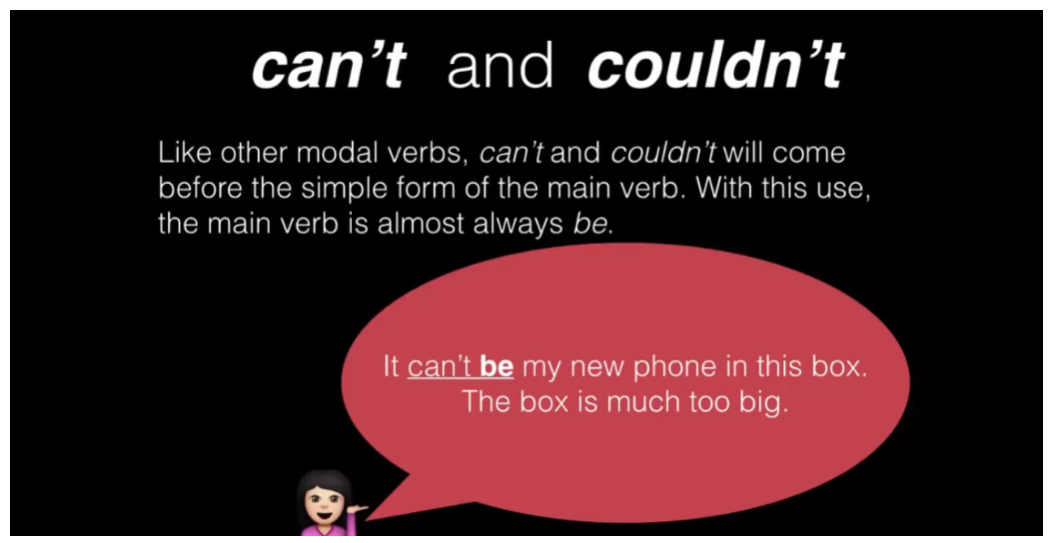
It’s your turn. What’s in the box? Here are some hints. Number one, it won’t break if you drop it. >> Number two, you can wear it. >> Number three,
you can’t eat it or drink it. >> And number four, it is not heavy. Okay, put the words in
the appropriate order. Make sentences using can’t or couldn’t to express impossibility
about what is in the box. Are you ready? Okay. >> Number one,
it couldn’t be delicious candy. >> Number two, it can’t be my new glasses. >> Number three,
it couldn’t be a heavy book. >> Number four,
it can’t be expensive perfume. Did you get it? Good job! Okay, let’s review. >> What are two modal verbs we can use
to express impossibility or disbelief? >> That’s easy, can’t and couldn’t. >> You’re so smart. And what verb usually comes after can’t or
couldn’t? >> That’s easy too, it’s be! >> You got it! Okay, one last question. If I use can’t or couldn’t to express
impossibility, am I 100% certain? >> No, you are almost 100% certain.
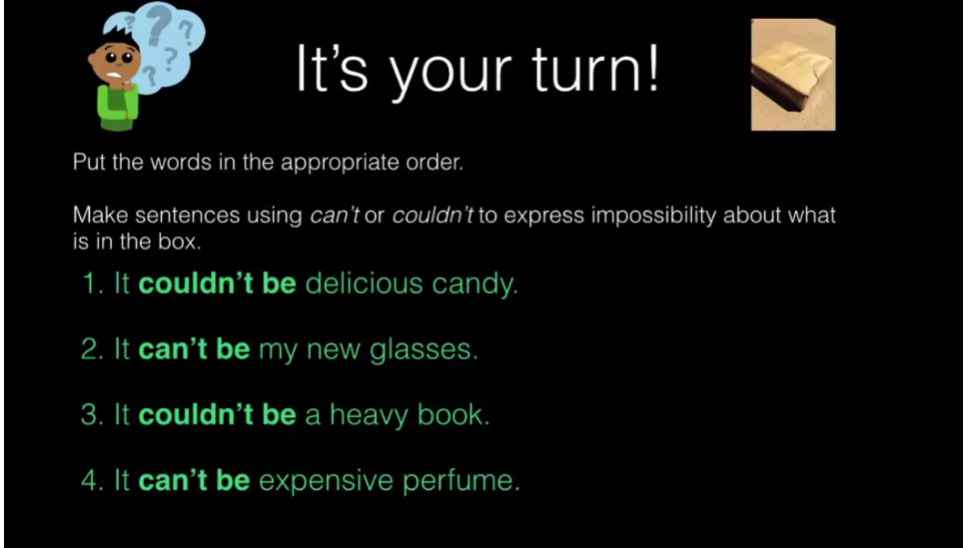
Questions with Modals Lecture
Asking questions using modal verbs. Hey Matt, it’s a beautiful day, isn’t it? >> Yeah, what’s up? >> Did you get the invitation to my party? >> Yeah. >> Are you able to come? >> I think so. When should I come? >> Could you come early to set up
the dance floor, maybe around 6? >> The dance floor? Wow!
Sure. I can do that. But do I have to dance? >> Of course you have to dance! Who will I dance with if
you don’t dance with me? >> Okay, if I have to, I will. You sure are lucky to
have a friend like me. >> I know.
Now, should we practice? >> Right, sure.
Let’s take a look at how we
make questions with modal verbs. With true modal verbs, we used
the modal followed by the subject and then the main verb. Let’s look at an example
from the dialogue. Could you come early to my party? Could you come is the question form, which is different from
the statement form, you could come.
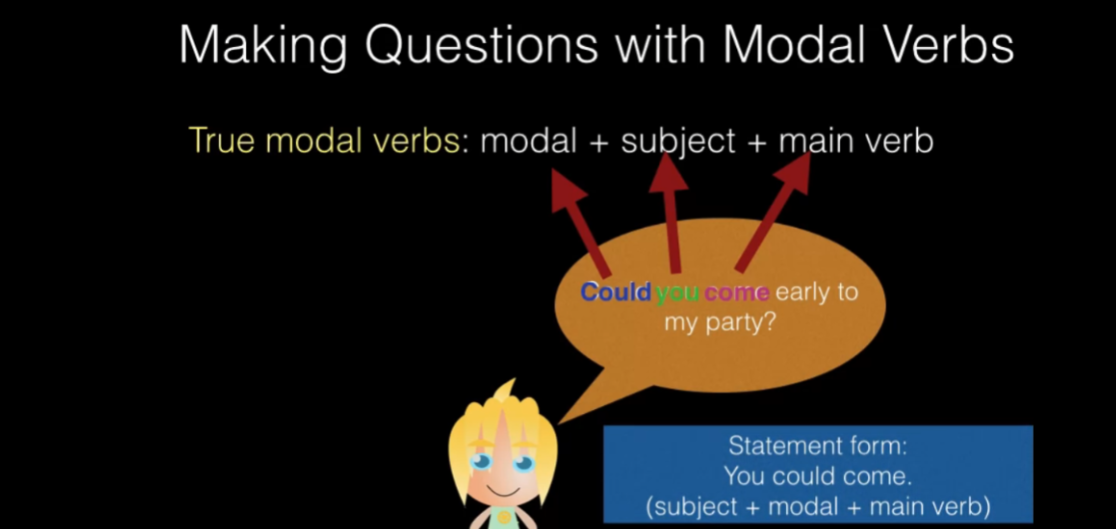
Let’s look at one more example. Should we practice? Can you identify the parts
of the question? Good. Should is the modal verb. And we is the subject. Finally, we have the main verb
in it’s simple form, practice. If we want to ask an information question, we can simply add the wh word to
the beginning of the sentence. For example, when should we practice? Where should we practice? Or why should we practice?
Making questions with phrasal
modals is a little different. Let’s start with have to. In the dialogue, Nah asks,
do I have to dance? Notice the word order. We need do because we’re talking
about the present not the past. Then we have the subject I followed
by have to and the main verb, dance. Can you change this
question into a statement? Good.
I have to dance.
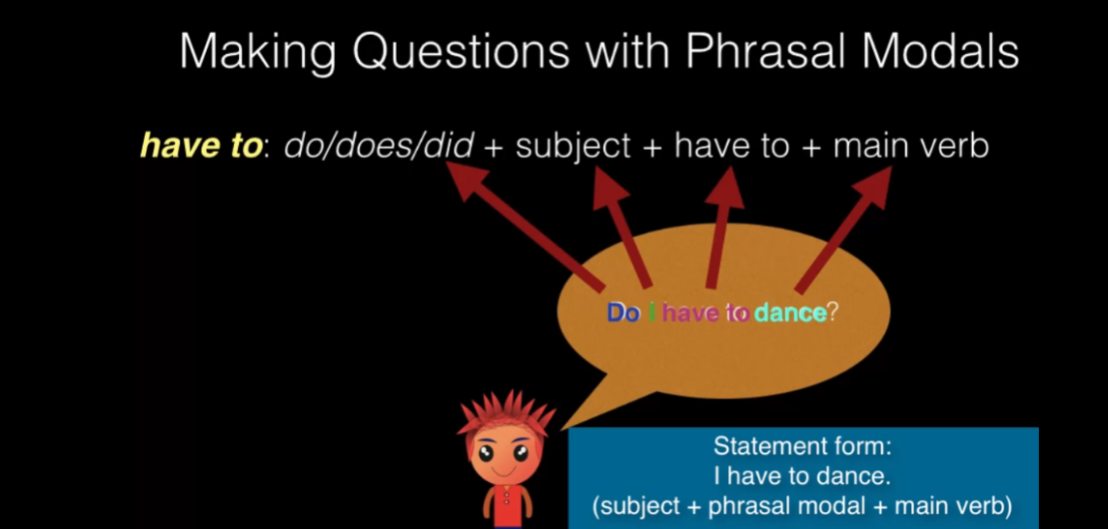
Now, let’s look at how to make questions
with the phrasal modal, be able to. Molly asks Matt, are you able to come? Can you identify the parts
of the question? Here we have the be verb, which is are,
in this case, followed by the subject, you, then able to, and
the main verb in it’s simple form. How can we change this to a statement? Yep, I am able to come.
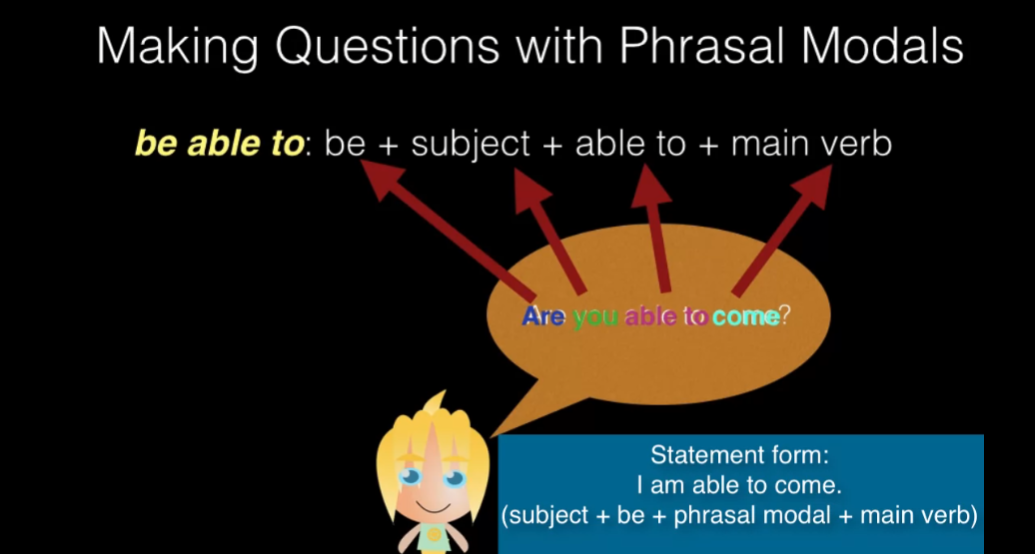
We can also add wh words to these
questions by putting them at the beginning. For example, when are you able to come? Okay, it’s your turn. The guests at this party
have a lot of questions. Can you match the questions
to the answers? Number one. Where can I find the bathroom? Good, c. It’s down the hall to the right. Number two. Will you dance with me? Yep it’s d, I’m sorry, but I’d rather not. Number three,
may I have something to drink? Mm-hm e, of course tea or lemonade. Number four, where should I put this gift? Yep over there on the table please. And finally number five,
do you have to leave early? Yeah, I have an early flight to catch. All right, good job. Now you know how to use
modal verbs in questions. See you next time.
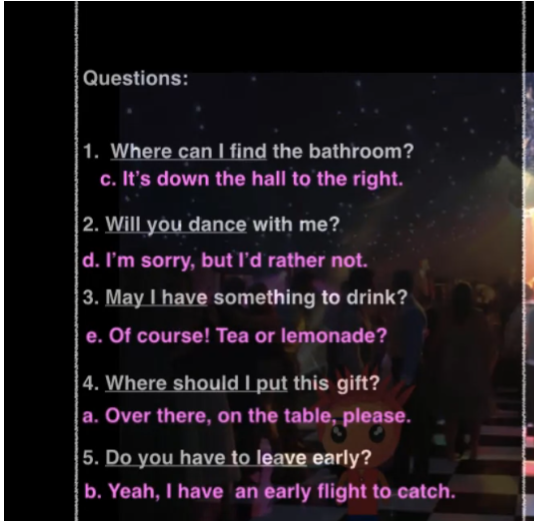
Modals Part 3 Practice Quiz
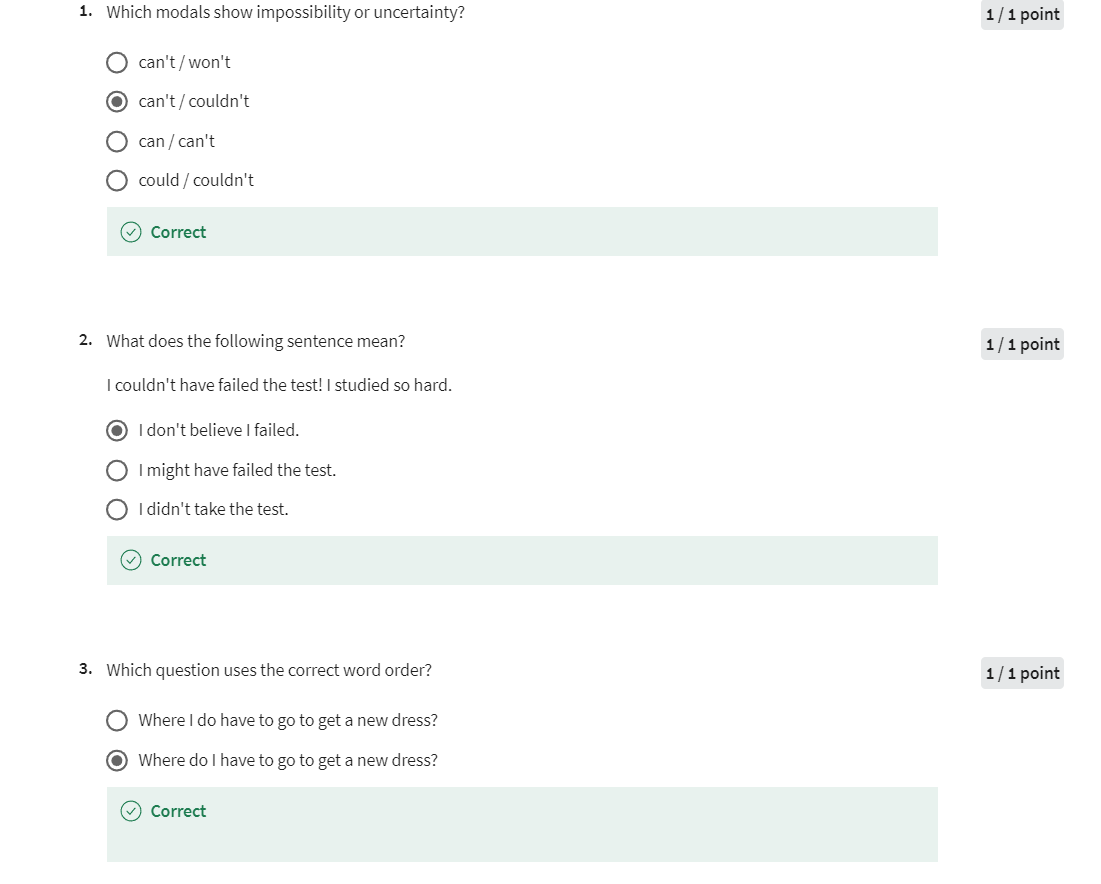
Graded Assignment: Modals Assignment 2
Write a dialogue between two people. Use as many different kinds of modals as you can. Try to use at least three different types and include questions and statements.
Here is an example:
Linda: Hi Paul. Can you help me with something?
Paul: Sure, I can, but I won’t be able to help you until after school.
Linda: That’s ok. I would rather do this later than now anyway.
Paul: What do you need help with? I might be able to guess.
Linda: You may be able to guess, but I’d better explain.
Paul: Ok. Explain.
Linda: I am having trouble in my French class. I can’t seem to understand past perfect tense. Could you help me review before my test?
Graded Quiz: Modals Quiz
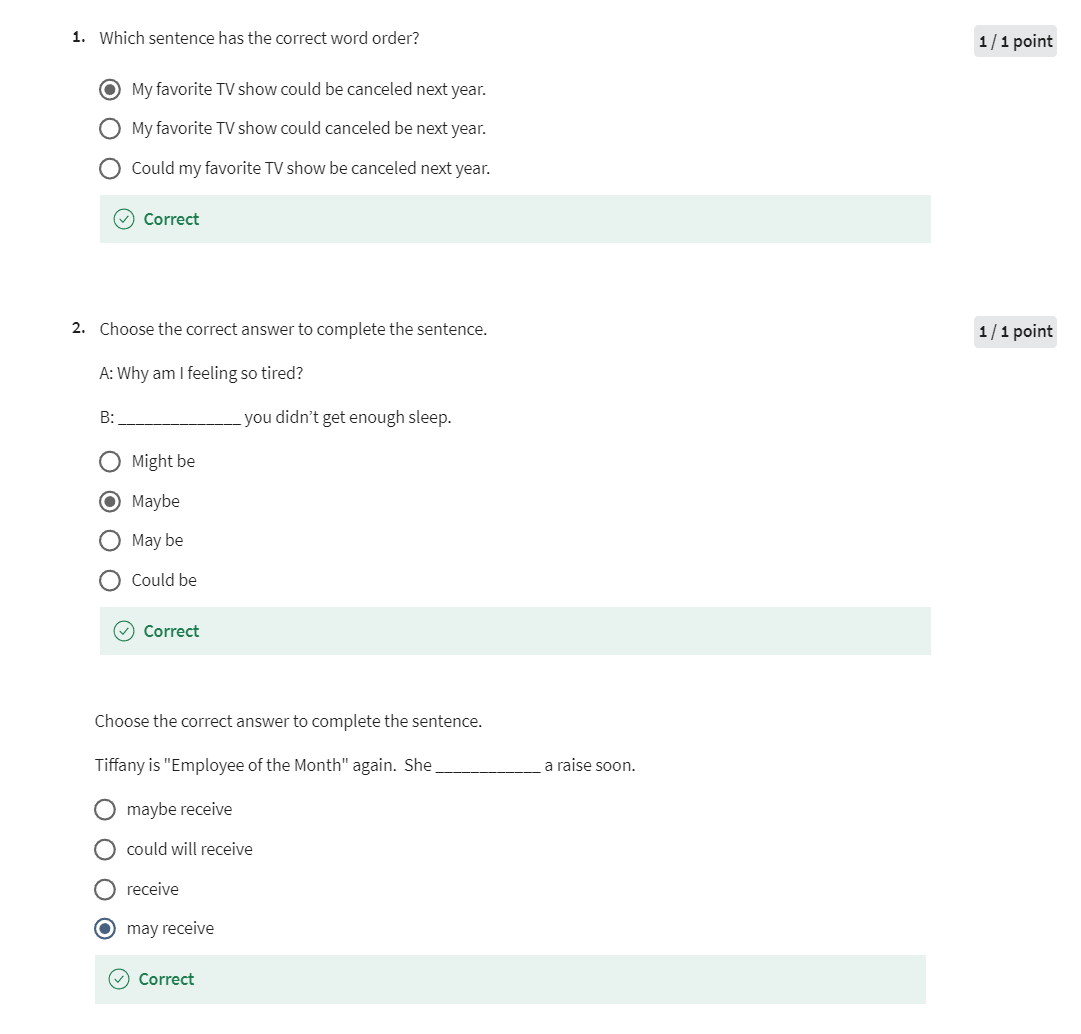
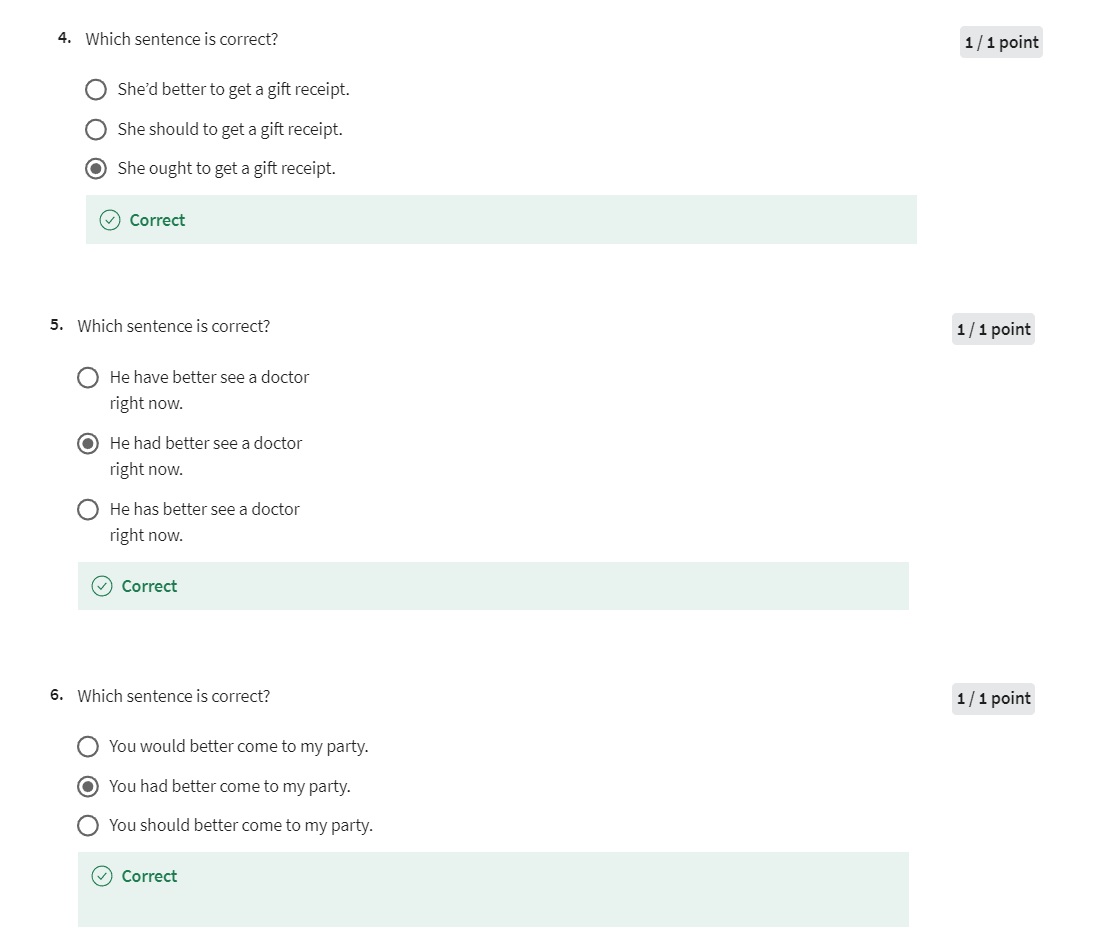
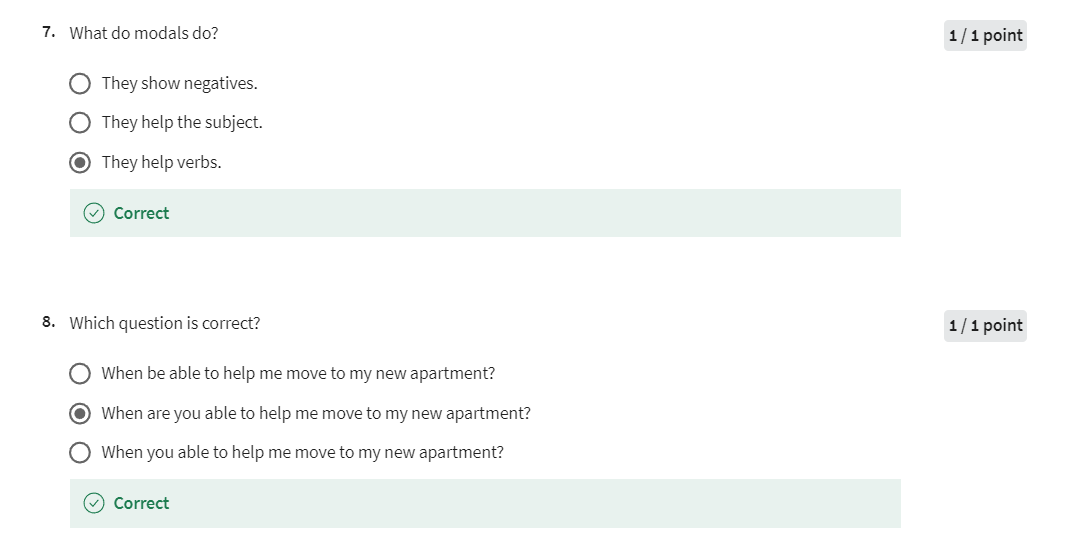
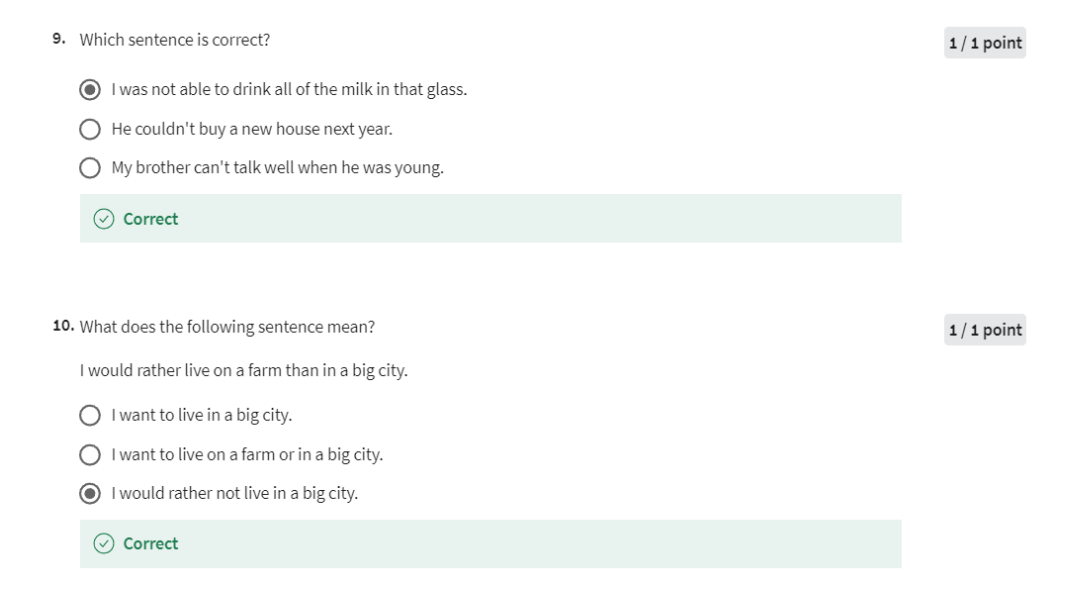
后记
截至2024年4月21日13点51分,花费2天时间完成这门英语语法课的学习。学会用英文描述语法现象。
这篇关于加州大学欧文分校英语中级语法专项课程01:Perfect Tenses and Modals 学习笔记的文章就介绍到这儿,希望我们推荐的文章对编程师们有所帮助!


